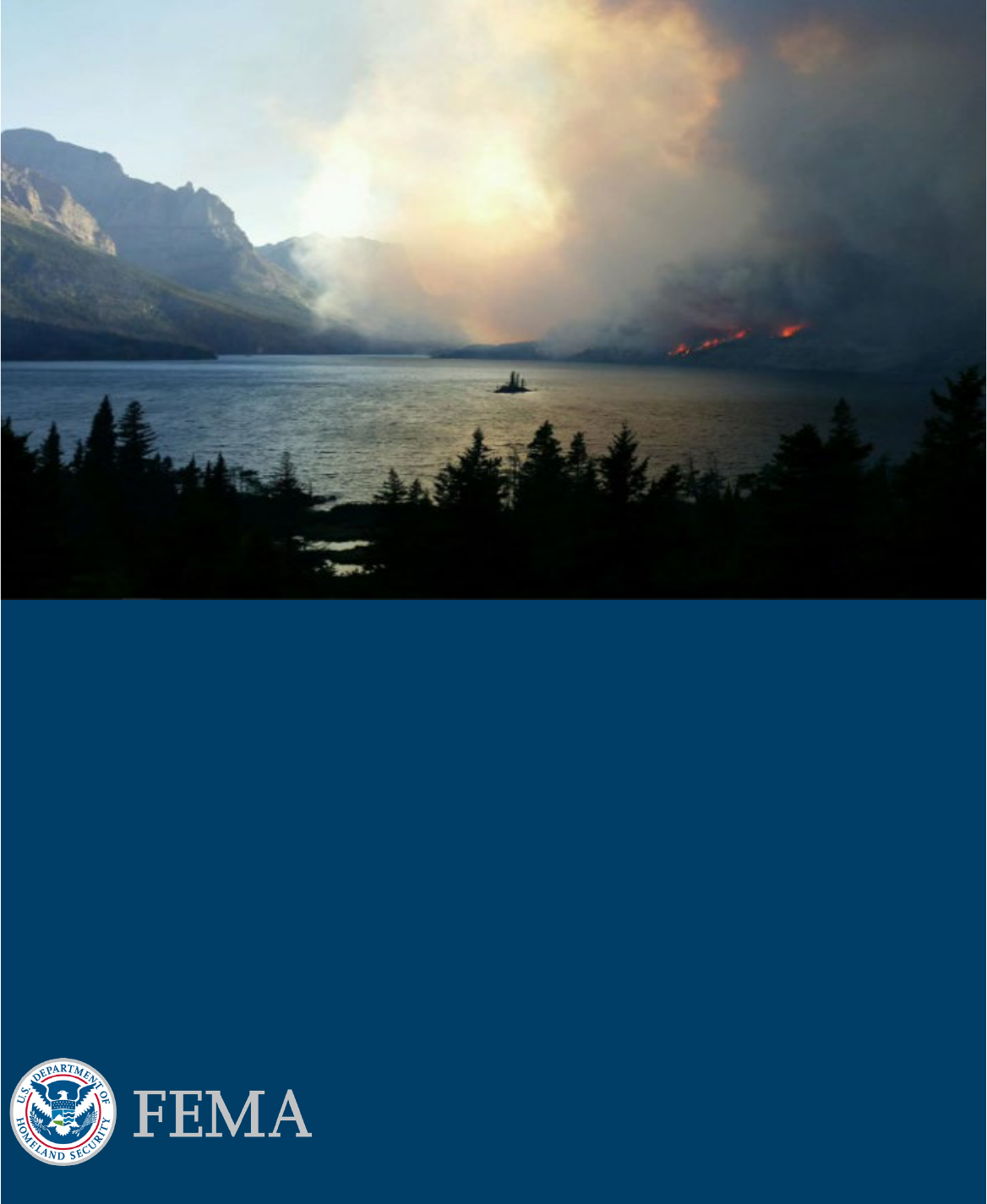
Climate Adaptation
Planning
Guidance for Emergency Managers
April 2024

Climate Adaptation Planning: Guidance for Emergency Managers
This page intentionally left blank

Climate Adaptation Planning: Guidance for Emergency Managers
i
Table of Contents
1. Introduction ................................................................................................................................ 1
1.1. Purpose ............................................................................................................................ 1
1.2. Key Terms and Considerations for Climate Adaptation Planning ................................ 2
2. Climate Science for Emergency Managers ............................................................................... 5
2.1. Understanding Past and Potential Future Climate Conditions ..................................... 5
2.2. Climate Impacts Globally and in the United States ....................................................... 8
2.3. Regional Impacts .......................................................................................................... 10
2.4. Climate Impacts on People and the Economy ............................................................ 14
2.5. Climate Informed Decision-Making for Emergency Managers .................................. 18
2.6. Potential Tools for Climate Modeling .......................................................................... 19
2.7. Communicating Changes in Climate ........................................................................... 20
3. Climate Adaptation Planning: An Overview ............................................................................ 22
3.1. Principles of Climate Adaptation Planning.................................................................. 22
3.2. Climate Funding and Adaptation Solutions for Emergency Managers ..................... 25
3.3. Connecting Hazard Mitigation and Climate Adaptation Planning ............................. 29
4. Climate Adaptation Planning: Six-Step Planning Process ...................................................... 32
4.1. Step 1: Form a Collaborative Planning Team ............................................................. 34
4.2. Step 2: Understand the Situation ................................................................................ 36
4.3. Step 3: Determine Goals and Objectives .................................................................... 41
4.4. Step 4: Develop the Plan ............................................................................................. 44
4.5. Step 5: Prepare and Review the Plan ......................................................................... 50
4.6. Step 6: Implement and Maintain the Plan .................................................................. 52
5. Conclusion ............................................................................................................................... 55
Appendix A: Climate Impacts on Emergency Response and Recovery Planning .......................... 56
Appendix B: Climate Data and Mapping Applications ................................................................... 62
Appendix C: Financing Climate Adaptation and Mitigation ........................................................... 64
Appendix D: Trainings and Additional Resources .......................................................................... 74
Appendix E: Glossary ...................................................................................................................... 77
Appendix F: Acronyms .................................................................................................................... 79

Climate Adaptation Planning: Guidance for Emergency Managers
1
1. Introduction
Communities across the nation are experiencing changes in the natural hazards they face. Extreme
weather events such as extreme heat, floods, and wildfires are occurring more often or during
different times of the year. This makes it more difficult to plan for future incidents solely based on
what has happened in the past. The evolving hazard landscape means emergency managers need to
plan differently when assessing disaster risk and community resilience. To become more resilient,
communities should examine the changing environment, understand how future hazards could
unfold, and factor that information into their planning efforts.
1.1. Purpose
The Climate Adaption Planning: Guidance for
Emergency Managers (this guide) is intended
to help state, local, tribal, and territorial
(SLTT) emergency managers incorporate
climate adaptation into emergency
management planning efforts. It discusses
climate science in the context of disaster
preparedness and explains how emergency
managers can help communities develop
effective climate adaptation strategies.
Communities may use different terminology
around climate resilience and climate
adaptation efforts, but for the context of this
guide, the terminology will be subsequently
referred to as “climate adaptation planning.”
The introductory section provides an overview of this guide and definitions of key terms. Section 2
provides an overview of climate science, regional impacts, and potential tools for climate modeling.
Section 3 pr
esents an overview of climate adaptation planning before section 4 follows up with the
six step planning process based on Comprehensive Preparedness Guide (CPG) 101: Building and
Maintaining Emergency Operations Plans.
1
It also provides information and actions for each step.
Section 2 can be read as reference material, whereas Sections 3 and 4 provides case studies and
potential best practices emergency managers can take to plan for changes in climate. At the end of
each section and step are key takeaways for emergency managers. The Appendices provide
potential cascading impacts on response and recovery planning, more details on modeling tools,
resources for financing climate resilience, information on trainings, glossary, and acronym list.
1
The Federal Emergency Management Agency (FEMA). Comprehensive Preparedness Guide 101: Developing and
Maintaining Emergency Operations Plans, Version 3.0. (2021).
https://www.fema.gov/sites/default/files/documents/fema_cpg-101-v3-developing-maintaining-eops.pdf
.
Climate Adaptation Planning
For the purpose of this guide, climate
adaptation planning is defined as a
systematic approach used to identify the
threats and hazards that might impact a
community given plausible future climatic
conditions. The process involves assessing
the risk posed by these threats or hazards
and positioning the community to avoid or
minimize the consequences of climate-
related disruptions.

Climate Adaptation Planning: Guidance for Emergency Managers
2
1.2. Key Terms and Considerations for Climate Adaptation Planning
Adaptation: Adjustment in natural or human systems to a new or changing environment that
exploits beneficial opportunities or moderates negative effects.
2
Climate mitigation (may also be called “mitigation” or “greenhouse gas [GHG] mitigation”):
Measures to reduce the amount and speed of future climate change by reducing emissions
of heat-trapping gases or removing carbon dioxide from the atmosphere.
3
Hazard mitigation: Any sustained action taken to reduce or eliminate the long-term risk
to human life and property from hazards.
4
Nature-based solutions (NBS): The sustainable planning, design, environmental
management, and engineering practices that weave natural features and processes into the
built environment to promote adaptation and resilience.
5
Resilience: the ability to prepare for threats and hazards, adapt to changing conditions, and
withstand and recover rapidly from adverse conditions and disruptions.
6
Risk: Threats to life, health and safety, the environment, economic well-being, and other
things of value. Risks are often evaluated in terms of how likely they are to occur (probability)
and the damages that would result if they did happen (consequences).
7
Effective planning takes time and includes understanding potential future conditions, infrastructure,
and impacts, along with proactive integration with other plans. Too often, planning occurs in silos
which leads to conflicting community plans, especially in light of planning for the future with a
dynamic climate. An example of this would be an economic development plan that identifies a
waterfront district for expansion, which may conflict with a climate adaptation plan calling for
greenspace in the area due to an expected rise in the sea level. Through efforts such as hazard
mitigation and disaster recovery planning, emergency managers are in a key position to help bring
different parts of the community together to harmonize long-term strategies that address the
evolving climate as well as day-to-day planning challenges.
2
U.S. Global Change Research Program (USGCRP). Glossary: Adaptation. (2022).
https://downloads.globalchange.gov/strategic-plan/2022/USGCRP_2022-2031_Decadal_Strategic_Plan.pdf
.
3
USGCRP. Glossary: Mitigation. (2022). https://downloads.globalchange.gov/strategic-plan/2022/USGCRP_2022-
2031_Decadal_Strategic_Plan.pdf.
4
FEMA. 44 C.F.R. § 201.2: Definitions. (2023). https://www.ecfr.gov/current/title-44/chapter-I/subchapter-D/part-
201/section-201.2.
5
FEMA. FEMA Resources for Climate Resilience. (2021).
https://www.fema.gov/sites/default/files/documents/fema_resources-climate-resilience.pdf
.
6
USGCRP. Fifth National Climate Assessment. (2023). https://nca2023.globalchange.gov/chapter/1#box-1_1.
7
USGCRP. Glossary: Risk. (2022). The U.S. Global Change Research Program 2022-2031 Strategic Plan.
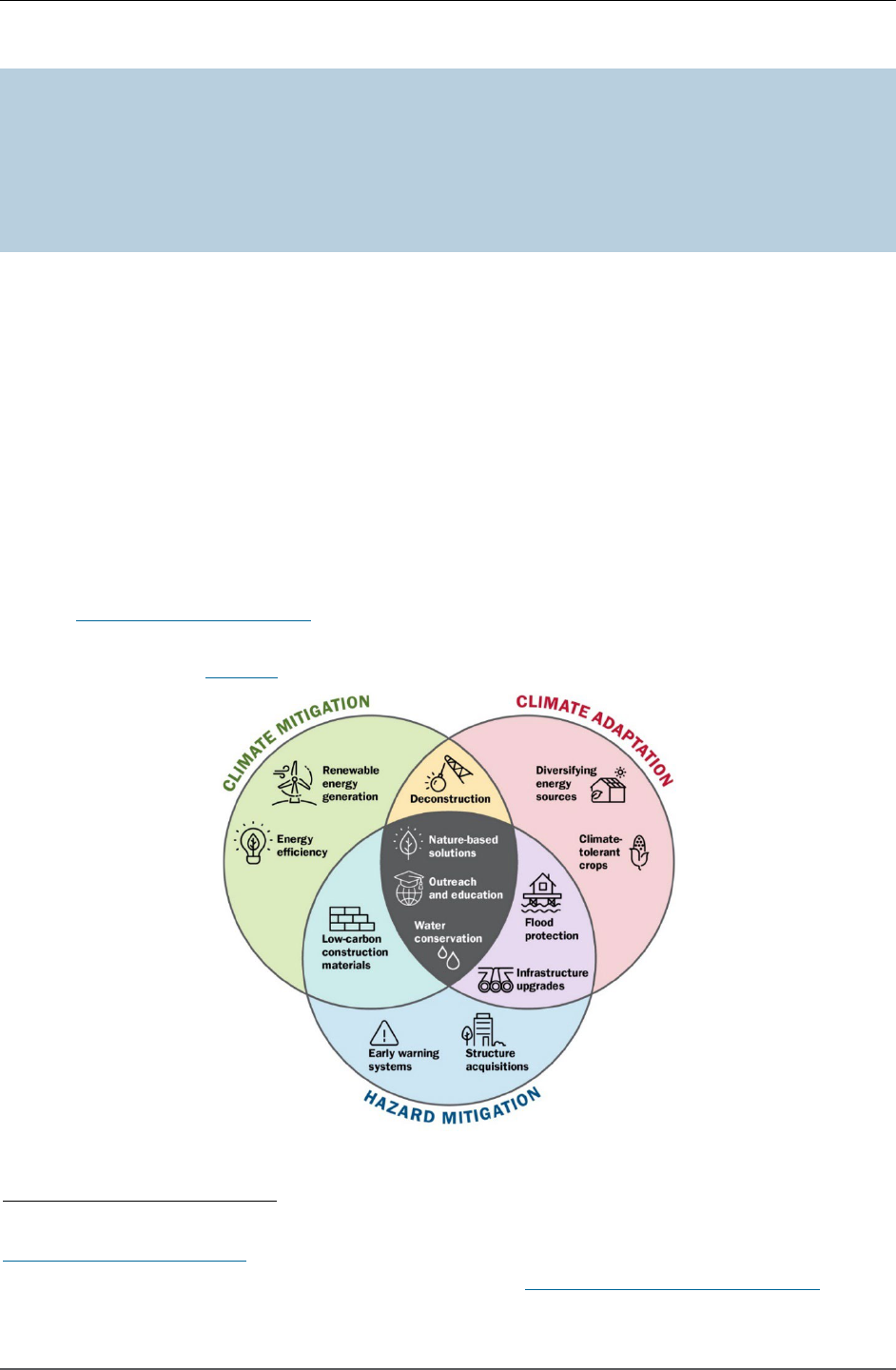
Climate Adaptation Planning: Guidance for Emergency Managers
3
Hazard Mitigation versus Climate Mitigation for Emergency Managers
Emergency managers often shorten the phrase “hazard mitigation” to “mitigation,” however, in
the climate discipline, “mitigation” often refers to climate mitigation. Hazard mitigation is any
sustainable action to reduce or eliminate long-term risk. Climate mitigation is the reduction of
GHG emissions in the atmosphere to reduce the severity of human-caused climate changes.
Climate adaptation and hazard mitigation share a common goal of minimizing impacts from natural
hazards that are expected to increase in frequency and intensity due to climate change. Climate
adaptation is especially concerned with adjusting to future conditions and building resilience to
withstand those changes. As the future climate is variable and may present new challenges, climate
adaptation uses scenarios to help plan for uncertainty. Adaptation is also a process that continues
over time, responding to new information or climate conditions. Successful climate adaptation
solutions can vary depending on the scope of the action but often include changes in processes,
behaviors, and infrastructure. Adaptations can shorten recovery by building communities that are
more resilient for current and future hazards. Hazard mitigation and climate adaptation are essential
because the effects of climate change are happening now and are expected to worsen.
8
As all-hazards planners, emergency managers already consider the impacts of an evolving climate
through hazard mitigation planning.
9
By adding climate adaptation planning, emergency managers
can help promote climate resiliency across plans while supporting underserved populations and the
whole community (see
Figure 1 for examples).
Figure 1: Overlaps between Climate Mitigation, Hazard Mitigation, and Climate Adaptation
8
National Aeronautics and Space Administration (NASA). Global Climate Change: The Effects of Climate Change. (2024).
https://climate.nasa.gov/effects/
.
9
For more information on hazard mitigation planning requirements, see https://www.fema.gov/hazard-mitigation.

Climate Adaptation Planning: Guidance for Emergency Managers
4
Key Takeaways for Emergency Managers: Introduction
Extreme weather events are becoming more frequent and intense.
It is important to understand key terms commonly used in climate adaptation planning,
specifically the differences between hazard mitigation, climate mitigation, and climate
adaptation.
Climate adaptation planning seeks to assess climate-related hazards, develop courses of
action to mitigate risk, and devise strategies for responding to climate-related disruptions.
Emergency managers can help communities become more resilient by developing
effective hazard mitigation and adaptation strategies to lessen the impacts of an evolving
climate. They are in a key position to help bring different parts of the community together
to harmonize long term strategies that address climate adaptation as well as day-to-day
planning challenges in a comprehensive way.
10
10
This guide contains references to non-federal resources. Linking to such sources does not constitute an endorsement by
FEMA, the Department of Homeland Security, or any of its employees of the information or products presented.
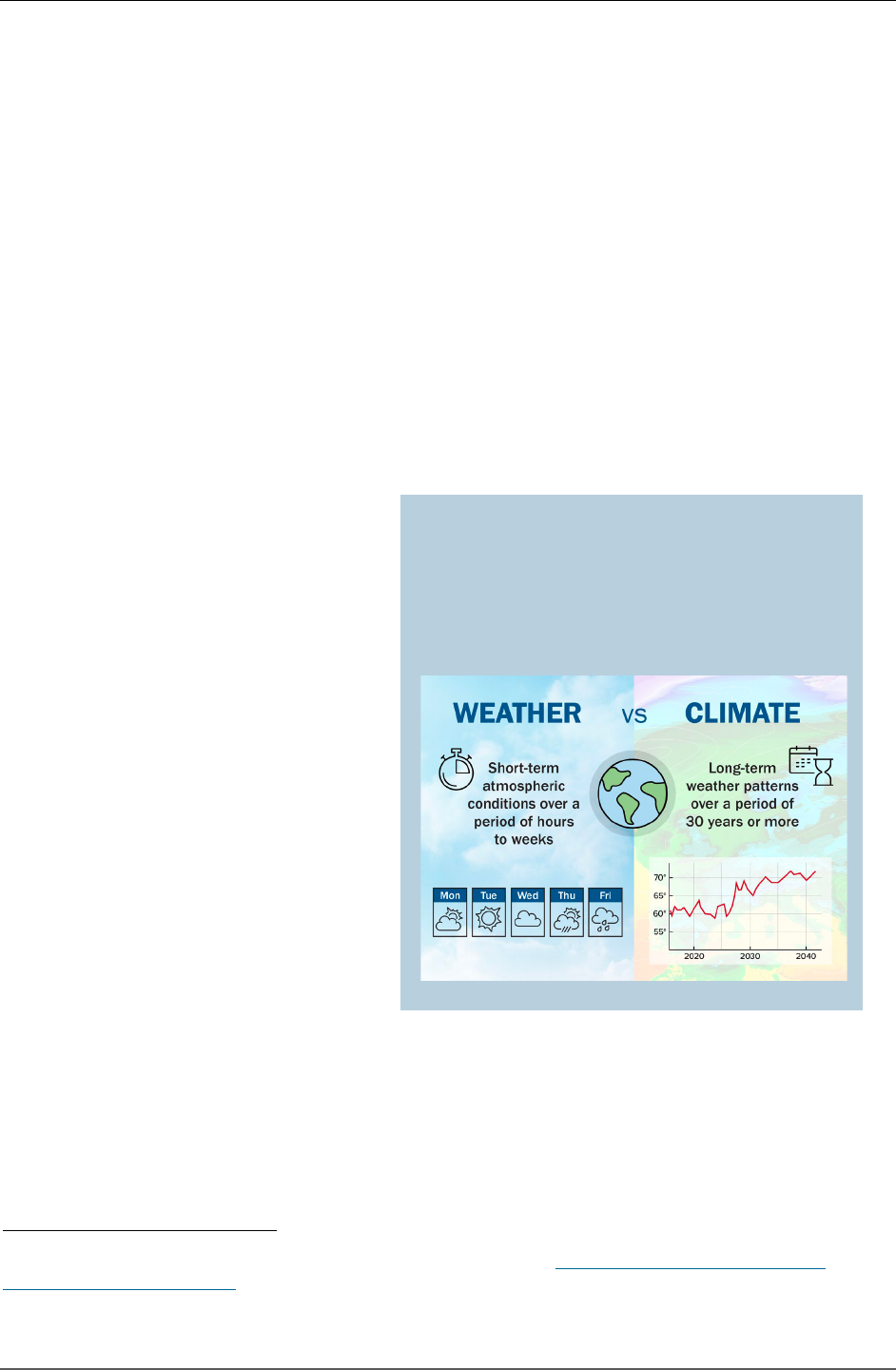
Climate Adaptation Planning: Guidance for Emergency Managers
5
2. Climate Science for Emergency Managers
Climate science investigates the structure and dynamics of Earth’s climate system. It seeks to
understand global, regional, and local climate characteristics as well as the processes that influence
change over time. Climate science is similar to the academic discipline of emergency management
in that it draws on a number of scientific fields, including meteorology, oceanography, physics,
chemistry, environmental science, informatics, and computer science. Climate scientists are
increasingly working with engineers and social scientists across disciplines to understand and
explain how changing climatic conditions will impact individuals, communities, economies, and
infrastructure systems. This section describes the scientific underpinnings of the evolving climate
and its potential impacts, provides potential data tools for analyzing changes in the climate, and
introduces communication strategies needed to build climate-resilient communities.
2.1. Understanding Past and Potential Future Climate Conditions
Climate change is a broad term that can
cover changes in multiple parts of the
climate system, from temperature to
precipitation to wind patterns.
11
A region’s
climate provides the background
conditions that give rise to a location’s
weather events. Thus, climate can be
described as the “average weather” for an
area; it refers to the average of the
meteorological conditions and weather
patterns that occur over long time periods.
Through geologic time, Earth’s climate has
varied, reflecting the complex interactions
and dependencies of the solar, oceanic,
terrestrial, atmospheric, and living
components that make up Earth’s systems.
Earth experiences long cycles of warming
and cooling that span tens of thousands to
100,000 years in length. The cycles are
influenced by regular changes in Earth’s orbit that alter the intensity of the solar energy that the
planet receives, absorbs, and reflects. Earth’s climate has also been transformed over a long
timescale by changes in atmospheric chemistry and ocean circulation. It has also changed due to
sudden events, such as massive volcanic eruptions into the stratosphere.
11
For more information on Climate Essentials for Emergency Managers, see https://www.fema.gov/node/climate-
essentials-emergency-managers.
Climate versus Weather
Weather refers to short-term atmospheric
conditions while climate is the weather of a
specific region averaged over a long period of
time.

Climate Adaptation Planning: Guidance for Emergency Managers
6
The rate of change in the climate during the 20
th
century and early 21
st
century stands out in the
geological record as extremely rapid, especially relative to the last 10,000 years. Since the year
1900, global temperatures have risen by approximately 2°F, and climate scientists expect Earth’s
temperature will continue to rise at an increasing rate throughout the 21
st
century.
12
The key driver
of this growing rate has been attributed to the emission of gases that trap heat in the atmosphere,
commonly referred to as GHG.
13
Greenhouse Gases
GHG are gases that trap heat and solar radiation in Earth’s atmosphere rather than allowing it to
escape into space. This process of heating the atmosphere is known as the greenhouse effect.
GHG include carbon dioxide, methane, ozone, nitrous oxide, and industrial gases. Except for
industrial gases, all are naturally occurring and are important for regulating Earth’s temperature.
Human activities have increased the amounts of gases in the atmosphere, creating a disruption
in the complex system of feedback loops in Earth’s warming atmosphere and climate.
14
The types and severity of change in the climate depend on how much GHG have built up in the
Earth’s atmosphere. These gases have fluctuated over geologic time, yet human activities since the
pre-industrial era, most notably fossil fuel burning, have exponentially increased the release of
carbon dioxide emissions, resulting in a higher concentration of heat-trapping GHG and an increase
in Earth’s average surface temperature (see Figure 2).
15
Figure 2: Atmospheric Carbon Dioxide Amounts and Annual Emissions (1750 – 2021)
16
12
National Oceanic and Atmospheric Administration (NOAA). Climate Change: Global Temperature. (2024).
https://www.climate.gov/news-features/understanding-climate/climate-change-global-temperature
.
13
Environmental Protection Agency (EPA). Greenhouse Gas Emissions: Overview of Greenhouse Gases. (2024).
https://www.epa.gov/ghgemissions/overview-greenhouse-gases
.
14
NASA Earth Observatory. Glossary: Greenhouse Gas Effect. (2024). https://earthobservatory.nasa.gov/glossary/f/h.
15
NASA. Vital Signs of the Planet: What is Climate Change? (2024). https://climate.nasa.gov/global-warming-vs-climate-
change/.
16
NOAA. Climate Change: Atmospheric Carbon Dioxide. (2023). https://www.climate.gov/news-features/understanding-
climate/climate-change-atmospheric-carbon-dioxide.

Climate Adaptation Planning: Guidance for Emergency Managers
7
As it is not possible to determine exactly what future GHG emissions will be, climate scientists have
created scenarios to better understand how human behavior will shape the future climate. Recently,
these scenarios have been tied to societal narratives that describe potential challenges to climate
mitigation and adaptation; these narratives are called Shared Socioeconomic Pathways (SSPs).
The Intergovernmental Panel on Climate Change (IPCC)
17
uses SSPs for climate modeling scenarios
that reflect change since the pre-industrial era. Each SSP is based on different assumptions of
societal, demographic, and economic conditions that will either decrease, maintain, or increase
future GHG emissions. For example, SSP2-4.5 describes a middle of the road scenario where
significant action is taken to mitigate changes in the climate, yet emissions remain relatively high
until midcentury. SSP3-7.0 is a scenario with many challenges in reducing emissions, while SSP5-8.5
describes a world with very high levels of fossil-fuel development throughout the rest of the
century.
18
Table 1 and Figure 3
show the estimated impact of three scenarios on global temperature ranges.
Table 1: Shared Socioeconomic Pathways (SSP) Impact on Global Temperature by 2100
SSP
Scenario
Global Mean Surface Temperature
Increase in 2081-2100 Relative to
1850-1900 Time Period
19
SSP2-4.5 Intermediate: Fossil fuel carbon emissions
peak mid-century, then decrease.
3.8°- 6.3°F (2.1 – 3.5° C)
SSP3-7.0 Higher: Assumes difficulty in reaching
emissions reductions with slow mitigation.
5.0°- 8.3°F (2.8 – 4.6° C)
SSP5-8.5 Highest: Fossil fuel carbon emissions continue
to increase throughout the century.
5.9°- 10.3°F (3.3 – 5.7° C)
17
The IPCC is an intergovernmental body of the United Nations responsible for advancing knowledge on climate change. It
provides objective and comprehensive scientific information on climate change. It undertakes a periodic, systematic review
of all relevant published literature and synthesizes the data and compiles key findings into "Assessment Reports."
18
The IPCC adopted SSPs as an update to Representative Concentration Pathways (RCPs) in its Sixth Assessment Report
(2023; https://www.ipcc.ch/report/ar6/syr/
). Many publicly available climate data still use RCPs, including some of the
resources listed in this document. Fortunately, SSPs and RCPs share many similarities, with the second number in SSPs’
names matching several RCPs. For example, SSP5-8.5 is comparable to RCP8.5 and SSP2-4.5 to RCP4.5. Additional SSP
scenarios have been developed, including scenarios with GHG emissions trends substantially lower than SSP2-4.5;
however, we focus on the scenarios that most closely track with recent GHG emissions, ranging from intermediate to the
highest emissions scenario. See
USDA’s Climate Hubs for an explanation of SSPs and a comparison of RCPs and SSPs.
19
IPCC. Technical Summary: Climate Change 2021: The Physical Science Basis. (2021).
https://www.ipcc.ch/report/ar6/wg1/downloads/report/IPCC_AR6_WGI_TS.pdf
.

Climate Adaptation Planning: Guidance for Emergency Managers
8
Figure 3: Carbon Emissions and Temperature Scenarios Based on SSPs
20
While the emission of GHG are currently the key driver of changes to the climate, other factors
influence both short- and long-term atmospheric patterns. For example, changes in land cover can
influence both weather and climate by altering the concentration of GHG and the exchange of energy
between land and the atmosphere. Furthermore, reforestation can provide localized cooling, even as
continued warming is expected for the planet as a whole and most regions on Earth.
Many factors will influence future GHG concentration including carbon capture and renewable energy
technology advancements, governmental and organizational policy decisions, consumer behavior,
and the pace of modernization in developing countries. Emergency managers are encouraged to
remain up to date with current science and undertake climate-informed risk analysis, especially as it
relates to climate impacts specific to a geographic region (see Regional Impacts
).
2.2. Climate Impacts Globally and in the United States
The National Oceanic and Atmospheric Administration (NOAA) monitors how global climate data
changes over time in its annual assessment. It al
so reports results through several Climate Change
Indicators on its Global Climate Dashboard.
21
On the next page are some of the NOAA Climate
Change Indicators:
20
Data compiled from these three sources: International Institute for Applied Systems Analysis. SSP Database. (2018).
https://tntcat.iiasa.ac.at/SspDb/dsd?Action=htmlpage&page=welcome. Copernicus Climate Change Service. ERA5 1940-
2023. (2023). https://cds.climate.copernicus.eu/#!/home. Our World in Data. Annual total emissions of carbon dioxide
(CO
₂
), including land-use change, measured in tonnes. (2023). https://ourworldindata.org/co2-emissions#global-co2-
emissions-from-fossil-fuels-and-land-use-change.
21
For additional U.S.-based indicators, see the USGCRP Indicators Platform: https://www.globalchange.gov/our-
work/indicators?page=1

Climate Adaptation Planning: Guidance for Emergency Managers
9
Annual Greenhouse Gas Index: Tracks the combined warming influence of the long-lived trace
gases in the atmosphere.
o The amount of carbon dioxide in the atmosphere has risen by 25 percent since 1958 and by
about 40 percent since the Industrial Revolution.
22
Global Surface Temperature: Tracks temperature measurements taken at locations around the
globe, which are converted from absolute temperature readings to temperature anomalies.
o Global temperatures rose approximately 2°F (~1°C) from 1900 to 2022.
23
Global Sea Level: Tracks sea level estimates provided through tide gauges and satellite
altimeters.
o Global sea level rise has accelerated from 1.7 mm per year throughout most of the 20
th
century to 3.2 mm per year since 1993.
24
In the United States (U.S)., emergency management response and recovery actions are being
impacted due changes in weather- and climate-related hazards. Changing weather patterns will
increase the severity, frequency, and impact of disasters. For example, the following list details
hazards that are common in emergency management plans and provides examples of associated
climate-related risk factors to consider:
Drought: As temperatures climb, evaporation rates increase. In drought conditions, high
evaporation rates will make droughts worse. Severe droughts can threaten drinking water
supplies and supply chains, reduce industrial output, and disrupt agriculture.
Extreme Heat: The annual number of very hot days is increasing. Extreme heat now regularly
affects all areas of the country. Furthermore, the “
urban heat island effect” can raise
temperatures by up to 10°F within urban environments.
25
,
26
Of all weather-related hazards,
extreme heat causes the highest number of deaths each year.
27
Coastal Flooding: Rising sea levels are contributing to more frequent and intense coastal floods
and storm surges, as well as recurring high tide flooding.
Inland Flooding: In many regions, more frequent and intense rains are leading to more severe
flooding, especially during the heaviest events. Heavy rain can also trigger flash flooding and
22
NOAA. Climate Change: Atmospheric Carbon Dioxide. (2024). https://www.climate.gov/news-features/understanding-
climate/climate-change-atmospheric-carbon-dioxide.
23
NOAA. Climate Change: Global Temperature. (2024). https://www.climate.gov/news-features/understanding-
climate/climate-change-global-temperature.
24
NOAA. Climate Change: Global Sea Level. (2024) https://www.climate.gov/news-features/understanding-
climate/climate-change-global-sea-level.
25
USGCRP. Fifth National Climate Assessment, Chapter 6: Land Cover And Land-Use Change. (2023).
https://nca2023.globalchange.gov/chapter/6/
.
26
For more information on the urban heat island effect, see https://www.heat.gov/pages/urban-heat-islands.
27
NWS/NOAA. Weather-related Fatality and Injury Statistics. (2022). https://www.weather.gov/hazstat/.

Climate Adaptation Planning: Guidance for Emergency Managers
10
cause rivers to overflow. As extreme flood events become more common, the risk of dam failure
is greater. Saturated soil also creates ideal conditions for landslides and mudslides.
Hurricanes: Warming ocean waters fuel larger and stronger tropical storm systems and weather
conditions and increase the likelihood of rapid intensification. The Caribbean, Gulf Coast,
Southeast, and Mid-Atlantic are seeing more destructive hurricanes.
Wildfires: Warmer temperatures are now more common, and intense droughts are creating the
conditions for larger wildfires. Wet growing seasons, paired with dry periods, can lead to high fuel
loads; warmer winter temperatures have allowed pests to decimate forest health, leading to
massive amounts of dead wood on forest lands. All these factors create conditions for larger and
more frequent wildfires and cascading smoke impacts.
This guide does not address all possible climate-related concerns and their potential impacts, as
climate science remains an evolving discipline.
28
For example, some climate research links extreme
cold events to Arctic warming due to its influence on the jet stream; however, this finding is not yet
well determined. Such cold air outbreaks significantly impacted people and infrastructure and should
still be factored into planning.
29
2.3. Regional Impacts
Changing hazards will impact communities and regions differently. The hazards that regions and
communities have been occasionally exposed to will become more frequent and severe. New areas
will also be affected. Figure 4 o
utlines the top climate-related hazards for each region in the U.S.
Note that this figure does not provide an exhaustive list of all climate-related hazards.
For a comprehensive summary of climate-r
elated risk for each region, see the regional chapters in
the Fifth National Climate Assessment and the 2022 State Climate Summaries.
30,31
The next section
provides a breakdown of potential climate-related impacts on communities by region.
28
USGCRP. Fifth National Climate Assessment: Chapter 3: Earth Systems Processes. (2023).
https://nca2023.globalchange.gov/chapter/3/.
29
For more information on FEMA’s Response and Recovery Climate Change Planning Guidance, see
https://www.fema.gov/sites/default/files/documents/fema_response-re
covery_climate-change-planning-
guidance_20230630.pdf.
30
USGCRP. Fifth National Climate Assessment: Regions. (2023). https://nca2023.globalchange.gov/regions/.
31
NOAA. State Climate Summaries. (2022). https://statesummaries.ncics.org/.
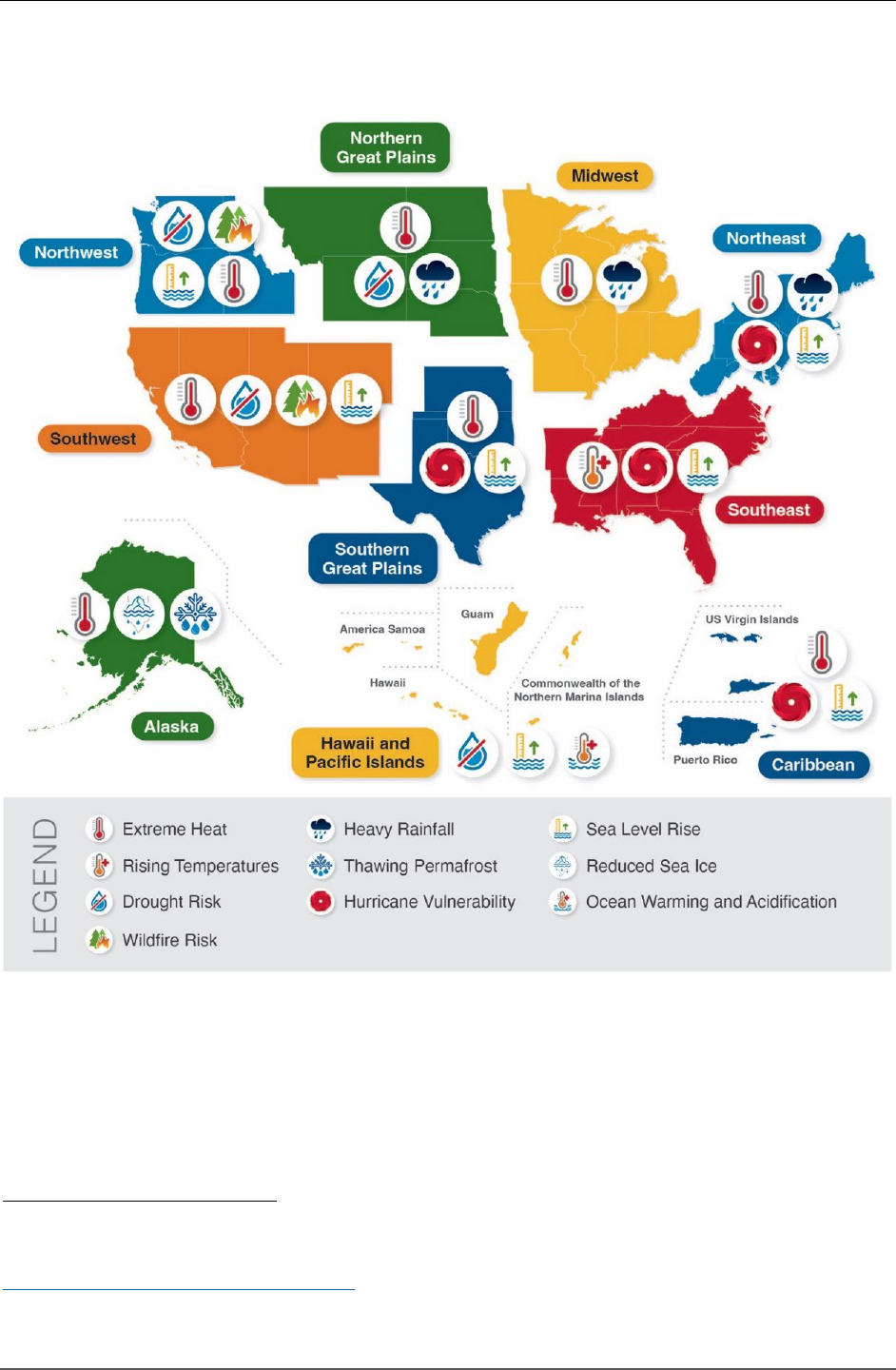
Climate Adaptation Planning: Guidance for Emergency Managers
11
2.3.1. POTENTIAL CLIMATE IMPACTS BY REGION
Figure 4. Regional Climate-Related Hazards
32
Northeast
33
The Northeast is experiencing warming temperatures and a large increase in the amount of
rainfall measured during heavy precipitation events.
32
Ibid. (Adapted figure).
33
USGCRP. Fifth National Climate Assessment: Chapter 21: Northeast. (2023).
https://nca2023.globalchange.gov/chapter/21/.

Climate Adaptation Planning: Guidance for Emergency Managers
12
Less distinct seasons, along with milder winters and earlier spring conditions, are already
altering environments in ways that adversely impact tourism, farming, and forestry. For example,
agriculture will likely face reduced yields as temperatures rise, potentially damaging livelihoods
and the regional economy.
More frequent heat waves in the Northeast are expected to increasingly threaten human health
through more heat stress and air pollution.
Sea level rise and more frequent heavy rains are expected to increase flooding and storm
surges, threatening infrastructure.
Southeast
34
Coastal communities in the Southeast are already experiencing warmer temperatures as well as
impacts from sea level rise, such as more frequent and more severe flooding.
Higher temperatures and greater demands for water will strain water resources.
Incidences of extreme weather, increased temperatures, and flooding will combine with high
rates of regional growth to have major impacts on human health, infrastructure, and agriculture.
Sea level rise is expected to contribute to increased storm surges, resulting in more damaging
hurricane and tropical storm events. Rising sea levels will increase the salinity of estuaries,
coastal wetlands, tidal rivers, and swamps, damaging habitats and degrading aquifers.
U.S Caribbean
35
Saltwater intrusion associated with sea level rise will reduce the quantity and quality of
freshwater in coastal aquifers.
Sea level rise, combined with stronger wave action and higher storm surges will worsen coastal
flooding and increase coastal erosion.
Projected increases in both average and extreme temperatures, resulting in higher levels of
noncommunicable diseases, behavioral health challenges, and excess mortality.
Midwest
36
Temperature increases in the Midwest have accelerated in recent decades, particularly
increases in nighttime and winter temperatures.
This region will likely experience warmer and wetter winters, springs with heavy precipitation, and
hotter summers with longer dry periods. Extremes may pose challenges for agriculture.
Risks to human health are expected to rise due to warming temperatures, reduced air quality,
and increased allergens.
Impacts to water quantity and quality are increasing the risks to ecosystem health, adequate
food production, surface water and groundwater uses, and recreation.
34
USGCRP. Fifth National Climate Assessment: Chapter 22: Southeast. (2023).
https://nca2023.globalchange.gov/chapter/22/.
35
USGCRP. Fifth National Climate Assessment: Chapter 23: U.S. Caribbean. (2023).
https://nca2023.globalchange.gov/chapter/23/.
36
USGCRP. Fifth National Climate Assessment, Chapter 24: Midwest. (2023).
https://nca2023.globalchange.gov/chapter/24/.

Climate Adaptation Planning: Guidance for Emergency Managers
13
Great Plains
37
,
38
Warmer winters are altering crop growth cycles and will require new agriculture and management
practices. Changes in water availability are likely to present challenges to agricultural irrigation
and threaten key wetland habitats.
Projected increases in temperature and drought frequency will further stress the High Plains
Aquifer, the primary water supply of the Great Plains.
Northwest
39
The Northwest is projected to face increased risks from extreme events, including flooding,
landslides, drought, wildfire, and heat waves.
The Northwest will likely be impacted by continued reductions in snowpack and lower summer
stream flows in the Northwest, worsening the existing competition for water resources. Larger
numbers of rain or snow events will also lead to additional flooding.
Higher temperatures, changing stream flows, and an increase in pests, diseases, and wildfires
will threaten forests, agriculture, and salmon populations.
Sea level rise is projected to increase the erosion of most coastlines, escalating infrastructure
and ecosystem risks.
Southwest
40
Observations of rapidly warming temperatures and reduced snowpack have been observed in
recent decades in the Southwest.
Increasing temperatures and more frequent and severe droughts are expected to heighten
competition for water for urban or residential use, agriculture, and energy production.
Indigenous populations are expected to experience difficulties associated with access to
freshwater, the sustaining of agricultural practices, and declines in cultural plant and animal
populations.
Drought, wildfire, invasive species, pests, and changes in species' geographic ranges will
increase threats to native forests and ecosystems.
Experiencing unprecedented extremes related to changes in climate, resulting in potential
droughts, larger and more frequent hailstorms, floods, and wildfires.
Older residents in rural areas and Indigenous communities are especially vulnerable to
increasingly severe and unpredictable climate impacts.
37
USGCRP. Fifth National Climate Assessment: Chapter 25: Northern Great Plains. (2023).
https://nca2023.globalchange.gov/chapter/25/.
38
USGCRP. Fifth National Climate Assessment: Chapter 26: Southern Great Plains. (2023).
https://nca2023.globalchange.gov/chapter/26/.
39
USGCRP. Fifth National Climate Assessment: Chapter 27: Northwest. (2023).
https://nca2023.globalchange.gov/chapter/27/.
40
USGCRP. Fifth National Climate Assessment: Chapter 28: Southwest. (2023).
https://nca2023.globalchange.gov/chapter/28/.

Climate Adaptation Planning: Guidance for Emergency Managers
14
Alaska
41
Extensive permafrost thaw is expected by the end of the 21st century, increasing the risk of
infrastructure damage.
Alaska is among the fastest warming regions on Earth, with temperatures warming twice as fast
as the global average since the middle of the 20th century.
Warming oceans will shift fisheries locations and impact productivity. Arctic sea ice is projected
to continue to decline, with nearly ice-free periods possible by mid-century.
Native Alaskans are expected to experience a declining availability of traditional foods and
reduced access to sea ice hunting grounds.
Hawaii and Pacific Islands
42
Dependable and safe water supplies for Pacific Island communities and ecosystems are
threatened by rising temperatures, changing rainfall patterns, sea level rise, and increased risk
of extreme drought and flooding.
Warmer and more acidic oceans are stressing coral reefs and fish habitats.
Sea level rise is expected to threaten biodiversity, ecosystems, and infrastructure of U.S. tropical
islands.
Changes in the climate are likely to affect the livelihoods of communities, tourism, and other
important economic sectors on tropical islands.
2.4. Climate Impacts on People and the Economy
The frequency and complexity of disasters are increasing. According to NOAA, there were 28 climate -
driven disasters with losses exceeding $1 billion within the U.S. in 2023.
43
These events happened
across all parts of the country and included droughts, floods, severe storms, tropical cyclones,
wildfires, and winter storms that resulted in the deaths of 724 people. 2021 was the third-most
costly year for weather and climate-related disasters in the U.S., with only 2005 (Hurricane Katrina)
and 2017 (the California wildfires and hurricanes Harvey, Irma, and Maria) causing more economic
impact. Since people live in high-risk areas, climate adaptation planning can play a key role in
reducing human vulnerability, risk to the built environment, and economic impacts.
While the frequency and severity of disasters over the coming century will continue to increase, such
changes are already being felt (see Figure 5
). For example, in the 1980s, a billion-dollar disaster
41
USGCRP. Fifth National Climate Assessment: Chapter 29: Alaska. (2023).
https://nca2023.globalchange.gov/chapter/29/.
42
USGCRP. Fifth National Climate Assessment: Chapter 30: Hawai’i and U.S.-Affiliated Pacific Islands. (2023).
https://nca2023.globalchange.gov/chapter/30/.
43
NOAA: National Centers for Environmental Information. U.S. Billion-Dollar Weather and Climate Disasters. (2024).
https://www.ncei.noaa.gov/access/billions/.
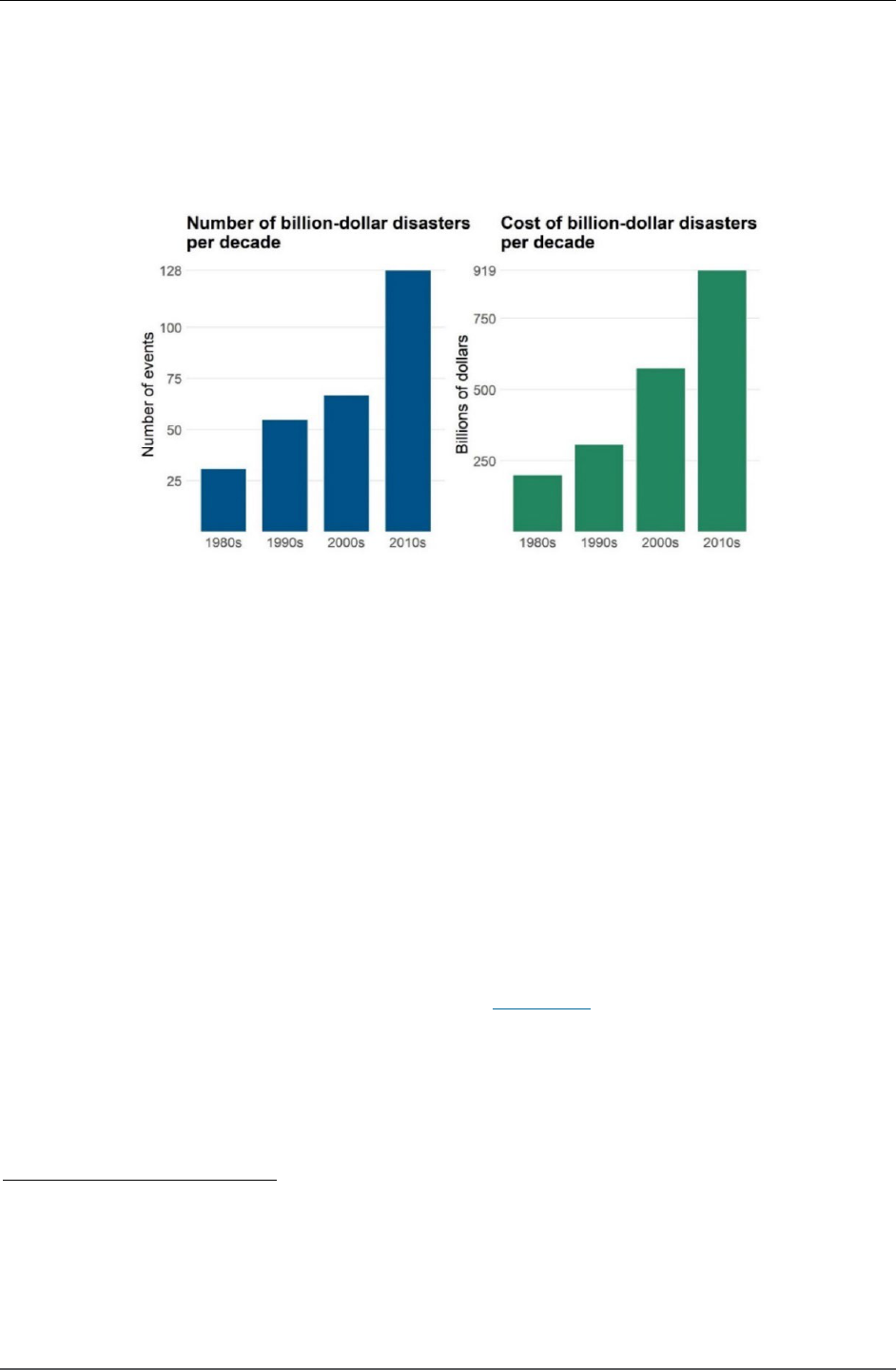
Climate Adaptation Planning: Guidance for Emergency Managers
15
occurred approximately every four months on average.
44,45
Today, there is a billion-dollar disaster
occurring every three weeks, on average. The physical, economic, and social impacts from these
disasters are not distributed evenly. Disadvantaged populations are more likely to be exposed to the
worst disaster impacts and possess fewer resources to cope with the effects.
Figure 5: Trends in Billon-Dollar Disasters Events (Inflation-Adjusted)
Rising global temperatures are the most observable impact of a changing climate, resulting in
significant impacts on the frequency, severity, and geographical distribution of natural hazards. A
warmer atmosphere means more intense storms. The warmer atmosphere can hold more water
vapor, which results in increasing precipitation levels and higher risk of flooding. More heat in the
atmosphere and warmer ocean surface temperatures can lead to increased wind speeds in tropical
storms. Rising sea levels caused by melting glaciers and the thermal expansion of the ocean expose
coastlines to tidal flooding and greater storm surge. All these impacts lead to increased damages.
For example, shifting precipitation patterns can lead to more prolonged periods of drought while
greater evaporation rates dry out soils and reduce surface water. Reduced snowpack limits the
replenishment of reservoirs, creating water shortages and straining agriculture and livestock
production. These conditions can cascade to produce an environment conducive to the spread of
wildfire, with dry soil and vegetation as ample fuel for fires. For more in-depth examples of climate-
related hazards with direct and cascading impacts, see Appendix A
.
Climate-related risks can compound with other hazards to create new threats or exacerbate existing
ones. For example, long-term drought is accompanied by a greater risk of wildfire and wind erosion
(e.g., the 1930s Dust Bowl). Coastal areas afflicted by riverine flooding as a result of intense
44
Ibid.
45
Billion-dollar event measurements are adjusted by the Consumer Price Index (CPI). The CPI is a measure of the average
change overtime in the prices paid by urban consumers for a market basket of consumer goods and services. The CPI is a
useful economic indicator, deflator of economic series, and a means to adjust dollar values.

Climate Adaptation Planning: Guidance for Emergency Managers
16
rainstorms upstream may simultaneously experience a severe hurricane. This, in turn, could double
the flooding impact and prolong the retreat of floodwater.
Extreme weather events, together with other natural and human-made health stressors, also
influence human health in numerous ways. Some existing health threats will intensify, and new
health threats may emerge. Not everyone is equally at risk due to social and economic inequities.
46
Potential health effects of physical, biological, and ecological disruptions include increased
respiratory and cardiovascular disease, injuries and premature deaths related to extreme weather
events, changes in the prevalence and geographical distribution of food- and water-borne illnesses
and other infectious diseases, and threats to mental health (see Figure 6).
47
Figure 6: Impact of Climate Change on Human Health
Climate threats may lead to other biological, technological, or economic threats. For example,
extreme heat can reduce outdoor labor activities or damage infrastructure exposed to conditions
beyond its design standards (e.g., melting roads, weakened bridges) or wildfire in one region can
affect air quality and human health in other regions, depending on where winds transport smoke.
Thus, different climate hazards can directly and indirectly affect a community or region’s economy,
creating new risks for agricultural or natural resource-dependent industries (e.g., skiing, fishing).
Individuals and businesses can also suffer from direct climate hazard impacts. This can include
damaged workplaces; lost income; reduced tax base; disrupted supply chains; destroyed
infrastructure, including power or internet; and inability to access a job site due to a damaged road.
46
USGCRP. Fifth National Climate Assessment. (2023). https://nca2023.globalchange.gov/.
47
Centers for Disease Control and Prevention (CDC). Climate Effects on Health. (2023).
https://www.cdc.gov/climateandhealth/effects/default.htm
.

Climate Adaptation Planning: Guidance for Emergency Managers
17
Climate and Equity: Keeping Equity at the Center of Climate Adaptation Planning
Underserved communities are disproportionately impacted by climate-driven hazards. For
example, Black, Indigenous, and People of Color (BIPOC) are more likely to reside in a highly
vulnerable flood zone due to years of discriminatory housing policy.
48
Lower income communities
are more likely to work jobs with direct exposure to climate hazards (e.g., workers in extreme
heat) and suffer greater harm from hazard-driven job disruptions or loss. Put simply, those with
the fewest resources to cope with climate change are often the most vulnerable to its impacts.
Keeping equity at the center of climate adaptation planning is key to ensuring the entire
community – not just a small subset – has access to the resources needed to adapt to climate
change. Importantly, it also means ensuring underserved communities can meaningfully
participate in decision-making, planning, and implementation of adaptation strategies. Action at
the local level is vital in this regard, as building resilience occurs within a local, site-specific
context. Emergency managers, elected and appointed officials, and other decision-makers are
responsible for addressing climate impacts and the distribution of adaptation benefits by viewing
the issue through an equity lens during every step of the planning process.
Climate impacts will affect many aspects of everyday life and may cause people and businesses to
relocate. This relocation process
will create both challenges and opportunities for communities, with
some areas losing population and others needing to accommodate an influx of new residents.
49,50
Emergency managers, with their expertise in hazard mitigation and adaptation, can help to improve
resilience for a community, and reduce involuntary relocation, through local climate adaptation
planning.
Environmental Justice
Environmental justice (EJ) is the fair treatment and meaningful involvement of all people. The
goal will be achieved when everyone enjoys 1) the same degree of protection from
environmental and health hazards, and 2) equal access to the decision-making process to have
a healthy environment in which to live, learn, and work.
51
48
Fang, Clara et al. Equity in Climate Resilience Planning and Action: A Practitioner’s Guide. (2022).
https://doi.org/10.25923/765q-zp33
.
49
FEMA. FEMA Efforts Advancing Community-Driven Relocation. https://www.fema.gov/fact-sheet/fema-efforts-advancing-
community-driven-relocation.
50
de Sherbinin, Alex et al. Preparing for Resettlement Associated with Climate Change. Science 334(6055), 456-457.
(2011).http://www.jstor.org/stable/41351300
.
51
EPA. Environmental Justice. (2024). https://www.epa.gov/environmentaljustice.

Climate Adaptation Planning: Guidance for Emergency Managers
18
2.5. Climate Informed Decision-Making for Emergency Managers
Emergency managers routinely influence and make decisions in highly uncertain situations. For
instance, emergency managers may be asked to recommend protective actions for a hurricane with
a 70 percent chance of landfall in their community in the next 72 hours, or for a chemical release
with wind conditions that may shift in the next 30 to 90 minutes. In responding to these scenarios,
emergency managers seek to minimize the risk while also arranging for the contingency that
conditions may change. As the situation evolves and new information becomes available, emergency
managers help leaders adjust risk management actions to cope with the evolving situation.
The decision-making approach used in planning, responding to, or recovering from disasters under
uncertain conditions is similar to that applied to climate adaptation planning, albeit with a much
longer timeline. Rather than operating over a period of hours or days, changes in the climate develop
over years, decades, and even centuries. Adaptation plans are often implemented over similar
timescales and usually reap rewards (e.g., risk reduction) over longer periods. Yet these plans also
need to be revised and updated regularly as new information is gathered (such as updated
projections of climate impacts). Climate adaptation planning should recognize that several potential
outcomes can occur, especially related to GHG emissions, but also that non-environmental factors
will influence the objectives and strategies of the plan.
Non-environmental factors that could impact jurisdictional climate adaptation planning include local
economic growth and demographic change, urban development patterns, and transportation needs.
Outside jurisdictional planning, individuals and businesses may contribute to adaptation. Examples
include individuals installing solar panels or businesses upgrading buildings to increase energy
efficiency in order to become more resilient to potential climate change impacts. By taking a broad
approach to planning for an uncertain future, emergency managers can help to ensure that climate
adaptation plans address a range of potential outcomes.
Emergency Management and Policy Change
Some emergency management policy changes come AFTER large disasters, such as after
Hurricane Katrina or Superstorm Sandy.
52
,
53
Yet, local emergency managers may be in a unique
position to address policy changes BEFORE disasters since they may be working with the elected
or appointed officials as well as the whole community.
54
A jurisdiction’s climate adaptation plan
may be used to support future policy changes that consider climate adaptation and resilience.
52
FEMA. Post-Katrina Emergency Management Reform Act of 2006. (2006). https://www.congress.gov/bill/109th-
congress/house-bill/5441/text.
53
FEMA., Sandy Recovery Improvement Act of 2013. (2013). https://www.congress.gov/bill/113th-congress/house-
bill/152/text.
54
FEMA. Local Elected and Appointed Officials Guide. (2022).
https://www.fema.gov/sites/default/files/documents/fema_local-elected-officials-guide_2022.pdf
.
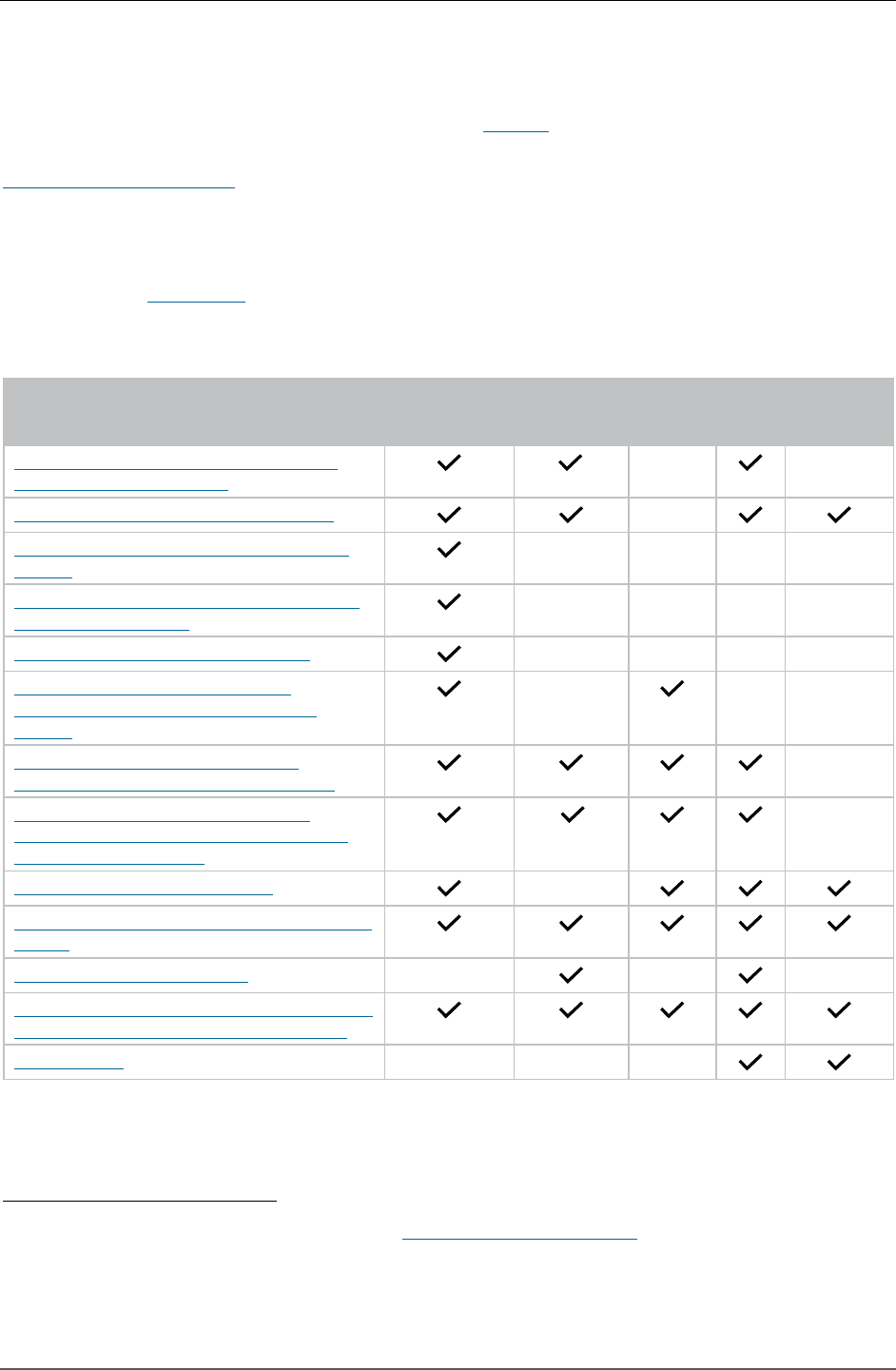
Climate Adaptation Planning: Guidance for Emergency Managers
19
2.6. Potential Tools for Climate Modeling
Many tools exist for potential climate modeling needs. Table 2 below provides information on tools’
applicability regarding social vulnerability, future conditions and some potential specific hazards. The
Climate Resilience Toolkit a
lso provides a website to start filtering for potential climate tools in
relation to specific regions, hazards, or community needs.
55
Using these tools, consistent with
applicable laws, emergency managers can further engage with the public and various planning
partners on potential decision-making for climate adaptation planning. For summaries on some of
these tools, see Appendix B
.
Table 2: Climate Resource Capability Inventory
56
Dataset / Application / Tool
Social
Vulnerability
Future
Conditions
Wildfire
Flood
Hurricane
Climate and Economic Justice Screening
Tool (CEJST) - White House
*
Coastal Flood Exposure Mapper – NOAA
Community Resilience Estimates - Census
Bureau
Low-Income Energy Affordability Data Tool -
Department of Energy
Social Vulnerability Index (SVI) – CDC
Wildfire Risk to Communities - U.S.
Department of Agriculture/U.S. Forest
Service
Climate Mapping for Resilience and
Adaptation (CMRA) - White House/NOAA
Environmental Justice Screening and
Mapping Tool (EJScreen) – Environmental
Protection Agency (EPA)
*
National Risk Index (NRI) - FEMA
Resilience Analysis and Planning Tool (RAPT)
- FEMA
Sea Level Rise Viewer - NOAA
Climate Risk and Resilience Portal (ClimRR) -
Argonne National Laboratory/AT&T/FEMA
Hazus - FEMA
*Denotes availability of climate data using SSPs (current as of April 2024).
55
NOAA, U.S. Climate Resilience Toolkit: Tools. (2014). https://toolkit.climate.gov/tools.
56
This list is not all-inclusive and represents the most commonly available and used tools for emergency management.
Tools listed are often updated without notice. Capabilities identified are as of May 2023 by the FEMA Climate Team.

Climate Adaptation Planning: Guidance for Emergency Managers
20
2.7. Communicating Changes in Climate
Communicating the degree of uncertainty
associated with climate projections and
information about ongoing hazard events is a key
activity for emergency managers. They may think
of public information activities primarily in the
context of impending or ongoing disasters and
emergencies. However, risk communications and
public information can also include efforts to
build awareness about how one or more hazards
can affect a community. This includes
communicating changes in climate for different
contexts, such as ensuring that future flood risk
is considered during the zoning and building
permitting processes for new developments.
More broadly, public outreach efforts can help
community members understand that certain
hazards may become more frequent and severe, and that all members of the community can adopt
a solutions-based approach to these changing conditions.
Best Practices for Communicating Climate Change to Diverse Audiences
57
Use terms that resonate with the target audience and find common ground. “Future risk”
and “future conditions” may be good alternative terms to “climate change.”
Leverage the power of story, such as through video.
58
Data can be presented when woven
within the context of an engaging story. Without a locally relevant story, focusing too much
on the data may cause people to retreat from the conversation. Stories can make climate
change more relatable.
Focus on resiliency as well as climate change. Be sure to convey opportunities and a
positive outlook. Get the audience excited about a climate resilient nation and let them
know they have the power to be a changemaker.
Collaborate with partners who the audience trusts and can carry the message for you.
Avoid stereotypes. Members of the whole community, of all capacities, capabilities, and
beliefs, are taking action to address changes in climates.
57
NOAA, Isn't there a lot of disagreement among climate scientists about global warming? (2020). www.climate.gov/news-
features/climate-qa/isnt-there-lot-disagreement-among-climate-scientists-about-global-warming.
58
Climate stories NC, Click on individual stories at https://www.youtube.com/@climatestoriesnc6891/videos.
Scientific Consensus on Climate Change
The U.S.’s foremost scientific agencies and
organizations have recognized climate change
as a human-caused problem that should be
addressed. The USGCRP has published a
series of scientific reports documenting the
causes and impacts of global climate change.
NOAA, NASA, and the EPA have all published
reports and fact sheets stating that Earth is
warming mainly due to the increase in human-
produced heat-trapping gases.
Source: https://www.climate.gov/news-features/climate-
qa/isnt-there-lot-disagreement-among-climate-scientists-
about-global-warming

Climate Adaptation Planning: Guidance for Emergency Managers
21
Climate can be a charged topic. Discussions around climate impacts can produce reactions ranging
from denial to anxiety or depression.
59
Therefore, it is important to ensure that information is
science- and evidence-based research from trusted sources and discussions emphasize concrete
actions to minimize climate impacts., Emergency managers can effectively communicate the
benefits of climate adaptation by framing the impacts of climate change as “future risks” or “future
impacts.” These terms highlight the frequency and severity of extreme weather events that may
increase, such as hurricanes, heatwaves, wildfires, droughts, floods, and precipitation.
60
The goal is
to encourage individuals and businesses to actively help decrease climate-related risk exposure.
Some public meetings may allow for two-way dialogues and public concerns furthering discussions of
potential adaptations that can lead to long-term community resilience and sustainability. For
example, there could be a discussion on how land use and zoning processes might mitigate climate
risks and provide additional social, economic and environmental benefits. Alternatively, local
meetings might provide opportunities to talk about how infrastructure and building projects, such as
using low-carbon materials, could be designed to address climate-related vulnerabilities.
Key Takeaways for Emergency Managers: Climate Science
The key factor currently driving changes in climate are the emission of gases that trap heat
in the atmosphere, commonly referred to as greenhouse gases (GHG). Since future GHG
emissions remain unclear, climate scientists created multiple potential futures; referred to
as Shared Socioeconomic Pathways (SSPs).
To be prepared for an uncertain future, emergency management planners should consider
a broad variety of scenarios and potential cascading disaster impacts on people and the
economy in their geographic region.
It is important to keep equity at the center of climate adaptation planning efforts as
underserved communities are disproportionately impacted by climate change and climate-
driven hazards.
Emergency managers can use a combination of climate modeling and social vulnerability
tools to support planning and decision-making in uncertain future climate conditions.
To communicate climate change threats to the public, emergency managers can focus on
terms such as “future risk” or “future conditions” to show how climate impacts may affect
individuals and the whole community.
59
Uppalapati, S., et al., The prevalence of Climate Change Psychological Distress among American adults. (2023).
60
NASA, Vital Signs of the Planet: What’s the Difference Between Climate Change and Global Warming? (2024).
https://science.nasa.gov/climate-change/faq/whats-the-difference-between-climate-change-and-global-warming/
.

Climate Adaptation Planning: Guidance for Emergency Managers
22
3. Climate Adaptation Planning: An Overview
Climate adaptation planning requires planners to think in terms of decades rather than months or
years. While there is uncertainty regarding the severity of climate impacts, there is little doubt that
emergency managers can plan for more frequent and more severe climate-driven incidents.
Emergency managers will have a leading role in preparing communities for new risks that will be
driven by the evolving climate.
3.1. Principles of Climate Adaptation Planning
Climate adaptation planning starts with understanding the types of climate-related hazards and risks
a community will face. This begins with reviewing weather-related disasters that have occurred in the
past and then projecting how future climatic conditions may change traditional hazards and create
new climate-related risks. Consideration of future climate conditions can be integrated into existing
risk analysis and planning activities, such as the Threat and Hazard Identification and Risk
Assessment (THIRA), hazard mitigation plans, and the development of mitigation and recovery
strategies, plans, and exercise materials. Once a community has this information, they can identify
how they are likely to be affected by all-hazards. Specifically, they can estimate which geographic
areas, population groups, community services, and critical infrastructure elements are vulnerable.
In collaboration with a diverse set of community members, planners can then identify strategies and
actions for adapting to these new risks. An inclusive, community-wide approach is essential to
ensure that the planning process and the goals, objectives, and strategies are equitable. This means
identifying and prioritizing the needs of underserved groups and ensuring equal access to the
benefits of adaptation. A climate planning process that is both equity-focused and informed by
science will help produce a quality climate adaptation plan. Ultimately, climate adaptation principles
should be incorporated into all community planning processes.
Climate and Equity: Portrayal of Underserved Communities
The United Nations states “Poorer countries and underserved communities, including Indigenous
peoples who have protected the environment for generations, are often portrayed solely as
victims of climate change, rather than positive agents of change. The same is often the case for
women and girls. Make sure to highlight the voices, expertise, innovations, positive action, and
solutions by people from all walks of life and communities from all parts of the world.”
61
While climate adaptation planning is a heavily technical process due to its reliance on risk data and
climate models, it will be most successful when it is people-centered, collaborative, and equitable.
This includes building partnerships across the whole community, collectively proposing creative
strategies, and sharing decision-making responsibilities to reduce risk from climate change while
preserving what the community values most.
61
United Nations, Communicating on Climate Change. www.un.org/en/climatechange/communicating-climate-change.

Climate Adaptation Planning: Guidance for Emergency Managers
23
3.1.1. CLIMATE ADAPTATION PLANNING PRINCIPLES
Preparing for climate-related disruptions is a key part of creating climate-resilient communities;
however, climate adaptation planning goes beyond preparedness and disaster response. Adaptation
planning involves implementing policies, management strategies, and long-term investments as part
of a community-wide approach to reduce climate-related risk. The following four principles are
fundamental to climate adaptation planning:
Focus on the Future: Even though recent disasters have raised awareness of the impacts
of extreme weather, future climate conditions are likely to be different than what
communities have experienced in the past. Planning for climate resilience involves
planning periods of decades or longer. Planners should factor in how changing climate
conditions might interact with other aspects of a community. Some non-environmental
factors include development patterns, population demographics, and emerging
technologies (e.g., new methods of transportation). This inherent uncertainty is an
important aspect of climate adaptation planning.
Link to Community Planning Processes: Most communities have well-established planning
processes that provide the infrastructure, services, land use, economic development, and
public health foundations for a community to thrive and prosper over time. Effective
climate planning can be integrated into these planning efforts so that strategies are put
into place to adapt existing services, infrastructure, and capabilities to withstand future
climate-related challenges.
Leverage Partnerships and Relationships: Just as community planning processes strive to
be transparent and provide opportunities for public and stakeholder engagement, it is
particularly important for outreach and engagement to be part of climate adaptation
planning. Adapting to future climate stressors (e.g., long-term trends that increase
vulnerability) is a relatively new concept, and it is important to ensure community members
and key stakeholders are aware of the threats posed by a changing climate and the ways
in which these impacts could affect different parts of the community
Use a Multidisciplinary Approach: Climate adaptation planning involves the integration of
social, economic, and environmental considerations to promote innovative solutions that
are socially acceptable, viable, equitable, sustainable, and increase resiliency. Climate
adaptation planning is most effective when it incorporates multi-disciplinary strategies
based in natural science-, social science-, and engineering to increase the communities’
resilience to climate-related disruptions.
Examples include:
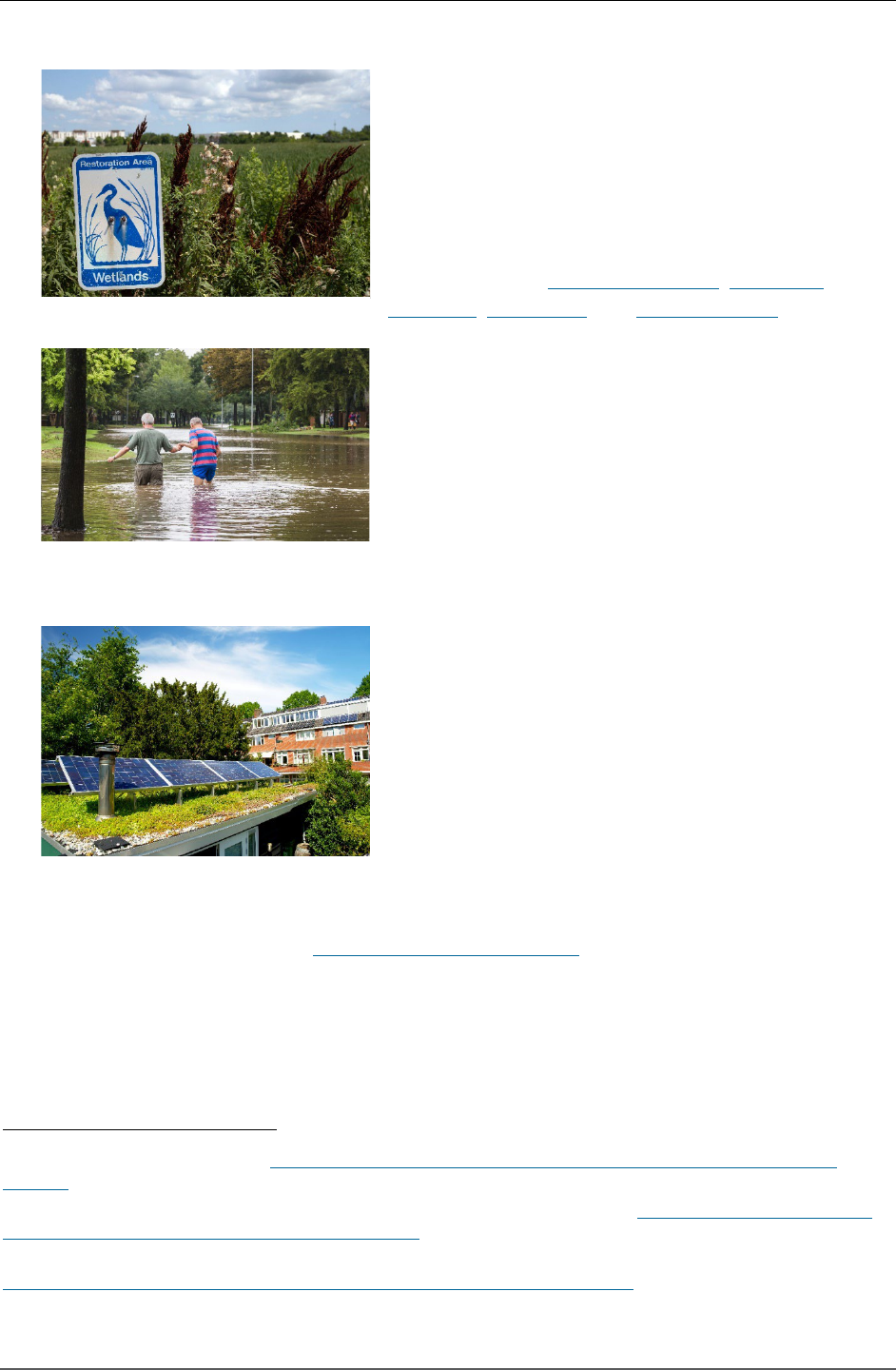
Climate Adaptation Planning: Guidance for Emergency Managers
24
Natural sciences help in understanding the risks caused
by climate change, particularly those important to habitat
and biodiversity. This information can be used to mitigate
impacts on wildlife, such as fisheries. Nature-based
solutions (NBS) can also increase resilience through the
integration of natural features into the built environment,
helping to reduce flood risk, lower urban heat, and more.
Examples include
wetland restoration, permeable
pavement, green roofs, and living shorelines.
62
Social sciences provide important context for
understanding and responding to the public health,
economic, and equity impacts of climate change. Social
sciences can provide information about the impacts that
climate change will have on people and encourage
sustainable practices that best fit the needs and culture
of the community. An example is using local public health
data to inform improvement strategies that incorporate
future climate changes.
Engineering offers effective and innovative strategies for
adapting to the impacts of climate change and the
possibility of novel approaches in the future. For
example, there are opportunities to integrate the
engineering of stormwater infrastructure (e.g., flood
levees, drainage systems, rainwater retention measures)
and natural systems into a mutually reinforcing and cost-
effective approach for environmental management.
63
These approaches can also benefit climate mitigation,
such as by reducing building energy use.
Many communities also undertake pre-disaster recovery planning
64
that establishes strategies to
lessen disruptions following a disaster. These recovery strategies can be a useful foundation for
climate resilience in traditional planning. Aligning strategies and leveraging funding opportunities
can also contribute to a cohesive community climate adaptation strategy. These strategies can
include using traditional ecological knowledge.
62
For more information on NBS, see https://www.fema.gov/emergency-managers/risk-management/nature-based-
solutions.
63
NOAA, Engineering With Nature: USACE, NOAA, and the Value of Partnership. (2022). Engineering with Nature: USACE,
NOAA, and the Value of Partnership - Podcast: Episode 55.
64
FEMA, Planning Guides: Pre-Disaster Recovery Plans for Tribal, Local, and State Governments. (2024).
https://www.fema.gov/emergency-managers/national-preparedness/plan#pre-disaster
.
A field undergoing wetland restoration
Helping an elderly neighbor after
Hurricane Harvey (2017)
Combining solar panels with a green roof

Climate Adaptation Planning: Guidance for Emergency Managers
25
Traditional Ecological Knowledge
Indigenous peoples maintain place-based knowledge
that holds thousands of years of natural resource
relationships and embodies multiple ways of
understanding resilient interactions between humans
and the ecosystem. Traditional cultural and ecological
knowledge is sound science and has been passed
down for generations through oral traditions. FEMA
acknowledges that Tribal Nations and Indigenous
peoples have performed resilience through traditional
ecological knowledge well before non-Indigenous
people came to North America or the U.S. became a
country (see Figure 7 at left).
65
3.2. Climate Funding and Adaptation Solutions for Emergency Managers
An important question to ask is, are established planning processes flexible enough to consider
adaptation and associated equity concerns, or do the processes need to change? Leveraging funding
opportunities through emergency management may provide potential solutions.
Before Disasters: Emergency managers work with—and invest funds in—communities to build a
nation able to withstand the climate hazards of today and those we can anticipate.
FEMA programs like the Building Resilient Infrastructure and Communities (BRIC) and the Flood
Mitigation Assistance (FMA) grant programs provide resources so communities are better
prepared before disasters or extreme weather events strike.
66
The National Exercise Program
provides support to federal and SLTT government partners to
assess and enhance response and recovery capacities.
67
FEMA grants
allow for investment in the infrastructure, including NBS and adoption of hazard-
resistant building codes, and response and recovery capabilities.
68
FEMA manages the National Flood Insurance Program which enables property owners to transfer
their financial risk through the purchase of flood insurance.
69
65
Figure adapted from: Status of Tribes and Climate Change Report, Institute for Tribal Environmental Professionals,
Northern Arizona University, Flagstaff, AZ. (2021). http://nau.edu/stacc2021
.
66
For more information on BRIC and FMA, see https://www.fema.gov/grants/mitigation/building-resilient-infrastructure-
communities and https://www.fema.gov/grants/mitigation/floods.
67
For more information on the National Exercise Program, see https://www.fema.gov/emergency-managers/national-
preparedness/exercises/about.
68
For more information on FEMA grants and Building Codes, see https://www.fema.gov/grants and see
https://www.fema.gov/emergency-managers/risk-management/building-science/building-codes-strategy.
69
For more information on the National Flood Insurance Program, see https://www.fema.gov/flood-insurance.
Figure 7: Indigenous Holistic Worldview

Climate Adaptation Planning: Guidance for Emergency Managers
26
After Disasters: Emergency managers provide information and funding to help SLTT officials
strategically invest in building back to increase climate resilience.
FEMA’s Hazard Mitigation Grant Program (HMGP), including 406 Public Assistance Grants and
Post-Fire assistance, goes beyond just rebuilding; these grants fund efforts for building back
stronger and more resilient to future threats.
70
The Inflation Reduction Act (IRA)
71
enables FEMA to fund costs associated with low-carbon
materials to help cut carbon pollution (GHG) to support climate resilience in communities.
72
Communities must have an approved hazard mitigation plan to apply for certain non-emergency
FEMA funding. More information can be found here.
73
Resources Available to Support Communities
FEMA Resources for Climate Resilience provides a comprehensive explanation of FEMA
programs planning for climate change.
74
Appendix C highlights other potential federal, state,
local, private, and philanthropic funding sources.
Climate adaptation strategies often have short- and long-term benefits beyond enhancing community
resilience. For example, using NBS to expand the flood water-carrying capacity of lands adjacent to a
river could provide recreational, aesthetic, biodiversity, and quality of life benefits to a community
(see Figure 8
). Benefits for other types of strategies might be linked to economic development,
public health, air and water quality, and improved housing. In some situations, climate adaptation
strategies could also contribute to reductions in GHG emissions.
Incorporating climate resilience principles throughout community planning can help reduce the
likelihood of engaging in maladaptation
. Examples of maladaptation include building seawalls that
then shift vulnerability to people elsewhere or eliminating floodplains, which in turn reduces the
nutrients in soils previously provided by flood water.
75
Officials who are often tasked with budgeting
for community services and capital investments should incorporate climate-related risk and
sustainability considerations into their decision-making processes.
70
For more information on FEMA’s HMGP and Post Fire Program, see https://www.fema.gov/grants/mitigation/hazard-
mitigation and https://www.fema.gov/grants/mitigation/post-fire.
71
For more information on the IRA, see https://www.whitehouse.gov/cleanenergy/inflation-reduction-act-guidebook/.
72
For more information on low-carbon goals, see https://www.fema.gov/grants/policy-guidance/low-carbon-goals.
73
For more information on mitigation planning grant requirements, see https://www.fema.gov/emergency-managers/risk-
management/hazard-mitigation-planning/requirements.
74
For more information on FEMA’s Resources for Climate Resilience, see
https://www.fema.gov/sites/default/files/documents/fema_resources-climate-resilience.pdf
.
75
Schipper, Lisa. Maladaptation: When Adaptation to Climate Change Goes Very Wrong. One Earth. (2020).
https://pubag.nal.usda.gov/catalog/7171690
.
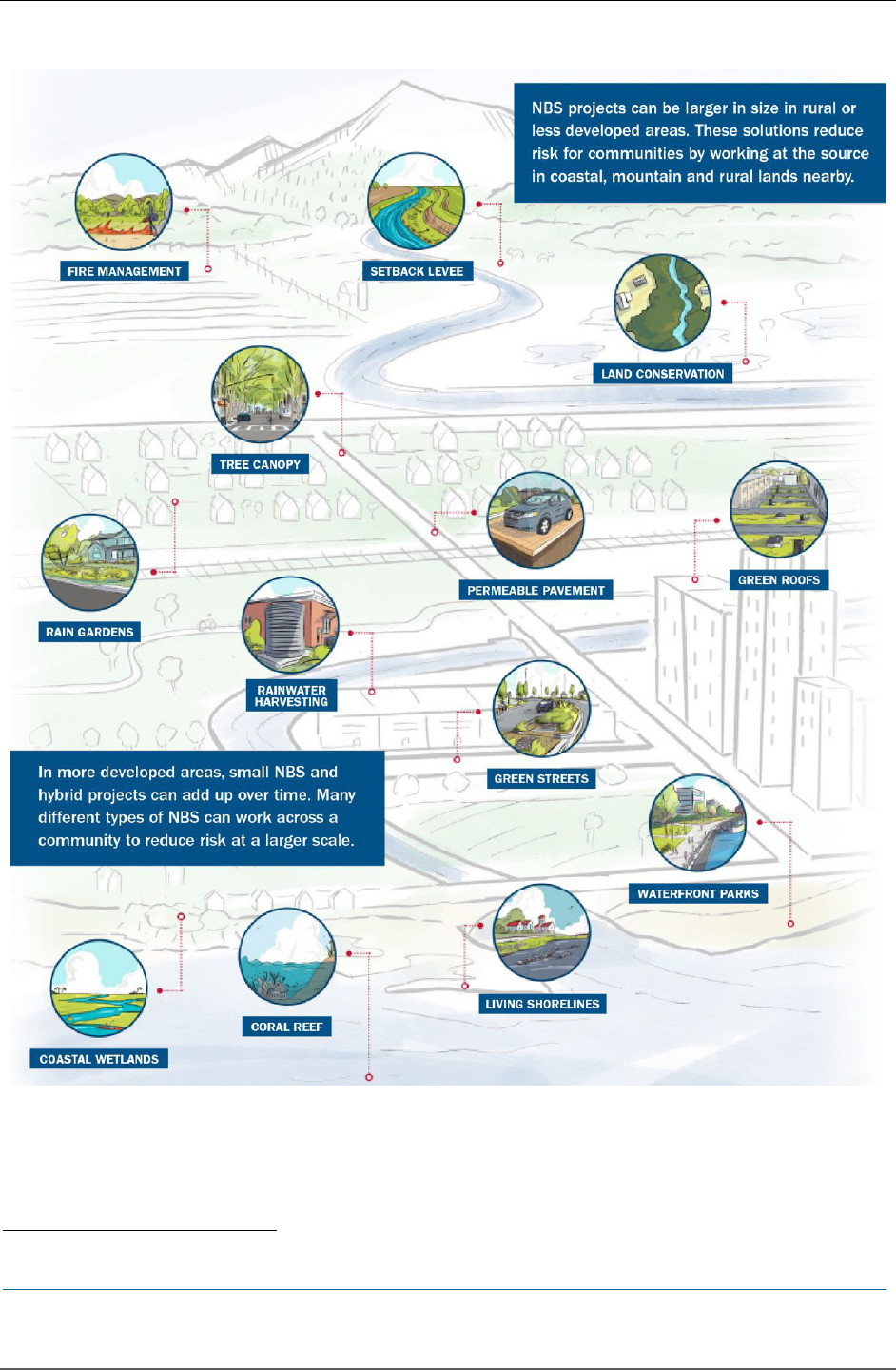
Climate Adaptation Planning: Guidance for Emergency Managers
27
Figure 8: Examples of Nature-Based Solutions Across Landscapes
76
76
For more information on Building Community Resilience with Nature-Based Solutions, see
https://www.fema.gov/sites/default/files/documents/fema_nature-based-solutions-guide-2-strategies-success_2023.pdf
.

Climate Adaptation Planning: Guidance for Emergency Managers
28
Types of Adaptation
Low-Regrets: Low-regrets actions are cost-effective now and under a range of future climate
scenarios and do not involve hard trade-offs with other policy objectives. These actions are
relatively low cost and provide relatively large benefits under predicted future climates. They
contribute to adaptation while also having other social, economic, and environmental policy
benefits, including benefits related to mitigation. Examples include efforts to improve water
and energy efficiency; preserving landscapes in support of biodiversity; and land use
planning to minimize flood hazard exposure.
Incremental: This adaptation pathway involves discrete actions that minimize present-day
climate impacts. Typically, these actions follow a climate-related disruption and target
solutions to a specific event or vulnerability. Examples include increasing stormwater and
wastewater capacity; building flood protection; designing buildings to meet future climate
demands; and increasing water reservoirs.
Transformational: Transformative adaptation involves large-scale changes that contribute to
long-term societal resilience and sustainability. This can emerge from both individual and
collective action and takes a long-term perspective while recognizing diverse constituent
interests. Transformational adaptation may involve institutional reform, structural changes,
and coordination across multiple levels of governance. Examples include funding the
relocation of underserved communities; changing land use patterns to restrict use in high-
risk areas (e.g., wildland fires, flood-prone areas); and prioritizing protecting ecosystems.
Maladaptation: Maladaptive responses to climate-driven events are those that end up
increasing or shifting vulnerability and reducing community resilience. Such actions may
address short-term risks, but in the long run increase disaster exposure. Examples include
planting trees in wildfire-prone areas and neglecting underserved communities.
Climate adaptation strategies are also often more effective when implemented across many different
communities without pushing the impacts into other jurisdictions. Regional coordination can lead to:
Consensus on which future climate scenarios should be used in vulnerability analyses;
Identifying the types of mitigation and adaptation strategies that would be most cost-effective;
Sharing of data, tools, and other resources for climate as well as response and recovery
operations; and
Identifying the types of mitigation and adaptation strategies that require collaboration across the
region’s communities to reach their full benefits.

Climate Adaptation Planning: Guidance for Emergency Managers
29
3.3. Connecting Hazard Mitigation and Climate Adaptation Planning
Climate adaptation planning, although it covers
all mission areas, can take advantage of relevant
existing mitigation plans and activities. All 50
states, the District of Columbia, and U.S.
territories have FEMA-approved hazard
mitigation plans, as do more than 224 Tribal
Nations and 24,700 local governments.
77
These
mitigation plans and the information developed
for them can provide a useful component of, and
a launching point for climate adaptation
planning. Furthermore, emergency managers’
experience in hazard mitigation planning
provides an opportunity to assume a leadership
or coordinator role in climate adaptation
planning. When emergency managers do not
have the technical expertise in climate
adaptation, they can use their role to ensure the core planning team includes climate experts such
as local staff with climate knowledge, academic researchers, state climatologists, or other agency
representatives (e.g., NOAA, National Weather Service).
The mitigation planning process shares some fundamental similarities with the process outlined in
this document, such as organizing the planning process, assessing risks and capabilities, developing
the plan, and then adopting and implementing it. However, the planning process differs slightly for
SLTT governments, with different laws and regulations guiding the development of each type of plan
and an action strategy or roadmap.
Case Study: Colorado Combing Climate and Hazard Mitigation Planning
In 2019, the State of Colorado established the Future Avoided Cost Explorer Tool
78
which helps
local planners incorporate climate into their jurisdiction’s hazard mitigation plans by exploring
the economic impacts from flood, drought, and wildfire in 2050. Larimer County used the tool
to forecast that under a medium growth and moderate climate change scenario, the County
will see $59 million in annual damage from these three hazards by 2050 (see Figure 9), which
is 2.6 times the current level. Post 2020 wildfires, Larimer County used HMGP grant funding to
establish a Climate Smart Future Ready Plan
79
which identifies actions the County can take for
mitigation, adaption, and resilience to hazards under climate change. The Plan includes
77
These FEMA approved hazard mitigation plan numbers are accurate as of the publication of this guide.
78
For more information on the Future Avoided Cost Explorer Tool, see https://cwcb.colorado.gov/FACE.
79
For more information on the Climate Smart Ready Plan, see https://www.larimer.gov/climate-and-sustainability/climate-
smart-future-ready.
FEMA’s Mitigation Planning Program
FEMA’s Mitigation Planning Program is a
useful resource to aid in the development
of state or community level climate
adaptation plans. The program can help
establish a foundation or be used as a
source of information to integrate into
climate adaptation plans. Dedicated
hazard mitigation planning policy guides for
state, tribal, and local governments,
technical assistance and training resources
are available at
https://www.fema.gov/hazard-mitigation.
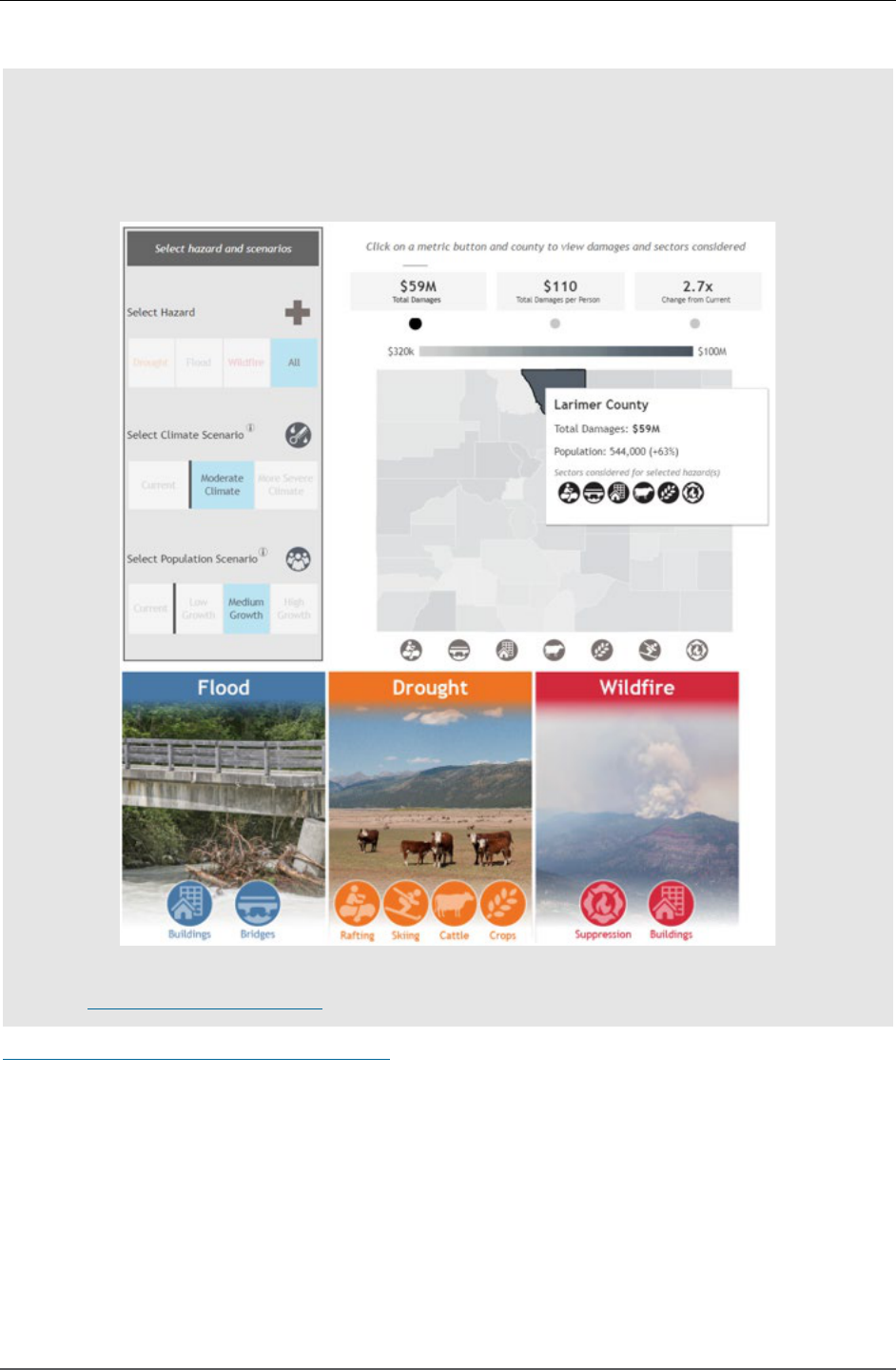
Climate Adaptation Planning: Guidance for Emergency Managers
30
understanding how the community perceives current and future climate change impacts and
what they see as challenges and appropriate responses for the unique North Front Range
context. Additionally, the Climate Smart and Future Ready Plan integrates with Larimer
County's Multi-Jurisdictional Hazard Mitigation Plan, as it is a Mitigation Action Item that was
identified through the local hazard mitigation planning process.
Figure 9: Larimer County’s use of Colorado’s Future Avoided Cost Explorer Tool
Source: https://cwcb.colorado.gov/FACE.
Updated hazard mitigation planning policies reinforce resilience as a whole community effort. State
and local hazard mitigation plans must now address current and future risks, including those from
climate change, land use, and population change. These risks, which are strengthened or worsened
by climate change, must be analyzed in how they impact community sectors (e.g., housing, economy,
infrastructure, natural systems and resources) and socially vulnerable populations. The policies
support mitigation planning’s integration with other complementary community actions, such as
climate adaptation, resilience, and sustainability planning initiatives.

Climate Adaptation Planning: Guidance for Emergency Managers
31
In hazard mitigation plans, emergency managers and planning teams should directly address climate
risks for each hazard and could develop adaptation solutions, including potential funding sources to
ensure these actions are attainable. Hazard mitigation plans should also incorporate and reference
any goals and actions in relevant state, tribal, or local climate plans. These efforts build state, tribal,
and local capabilities and help jurisdictions plan for long-term risk reduction, climate change, and
more equitable outcomes.
80
Hazard mitigation planning can be used to strategically advance climate adaptation efforts and can
be a useful mechanism for securing funds for projects that achieve both hazard mitigation and
climate adaptation goals. The Disaster Mitigation Act of 2000
created the framework for SLTT
governments to engage in hazard mitigation planning to receive certain types of non-emergency
disaster assistance. Governments with approved and adopted hazard mitigation plans may be
eligible for a number of FEMA grants,
81
including:
Hazard Mitigation Grant Program (HMGP)
Categories C-G of the Public Assistance Grant Program (PA)
Building Resilient Infrastructure and Communities (BRIC)
Rehabilitation of High Hazard Potential Dam Grant Program (HHPD)
For more information on these programs, along with other funding opportunities, see Appendix C
.
Key Takeaways for Emergency Managers: Climate Adaptation Planning
Consider integrating projected climate conditions into existing risk analysis and planning
activities, such as the THIRA, hazard mitigation plans, and the development of mitigation
and recovery strategies, plans, and exercise materials.
Climate adaptation planning is most effective when it incorporates natural science-, social
science-, and engineering-based strategies such as NBS.
Leverage diverse funding opportunities (emergency management grants, other government
funds, or public and private sources) and work across different communities and
jurisdictions to be most effective.
Connect hazard mitigation planning efforts, partners, resources, and funding opportunities
to climate adaptation goals and strategies whenever possible.
80
For more information on Hazard Mitigation Planning Policy updates, see https://www.fema.gov/emergency-
managers/risk-management/hazard-mitigation-planning.
81
For more information on requirements surrounding hazard mitigation planning, see https://www.fema.gov/emergency-
managers/risk-management/hazard-mitigation-planning/requirements and https://www.fema.gov/emergency-
managers/risk-management/hazard-mitigation-planning/regulations-guidance.

Climate Adaptation Planning: Guidance for Emergency Managers
32
4. Climate Adaptation Planning: Six-Step Planning
Process
This section provides a step-by-step process for integrating climate adaptation principles into
emergency management planning. While this section presents the planning process from the
perspective of developing a stand-alone plan, the process and its outputs can also be used to
incorporate adaptation concerns into other community plans, such as:
Hazard mitigation plans (comprehensive or specialized);
Emergency operations plans (EOPs) and appendices;
Recovery plans and strategies;
Local comprehensive and land use plans;
Economic development plans;
Transportation and capital improvement plans;
Sustainability and climate action plans;
Community health assessments and community health improvement plans; and
Water and land management plans.
This section builds upon the scientific and analytical approaches addressed in Section 2
. It also
proposes guidance on the integration of climate-related risks and adaptation principles into a
community’s broader planning processes and institutional structure.
U.S. Climate Resilience Toolkit
The U.S. Climate Resilience Toolkit
82
has a user-
friendly Practitioner’s Guide for Implementing
Steps to Resilience.
83
While there are some
differences between the Toolkit’s Steps to
Resilience (see Figure 10 at right) and this FEMA
guide, which is specific for emergency managers,
the fundamental approach and actions are
similar. This FEMA guide aligns the key climate
adaptation planning actions included in the U.S.
Climate Resilience Toolkit to the six-step planning
process outlined in FEMA’s CPG 101 (see Figure
11 on next page).
82
NOAA. U.S. Climate Resilience Toolkit. (2014). http://toolkit.climate.gov.
83
For more information on the Practitioner’s Guide for Implementing Steps to Resilience, see
https://toolkit.climate.gov/content/practitioners-guidance-implementing-steps-resilience
.
Figure 10: U.S. Climate Resilience
Toolkit’s Steps to Resilience

Climate Adaptation Planning: Guidance for Emergency Managers
33
Figure 11: The Six-Step Planning Process
Traditional emergency planning and climate adaptation planning share many similarities; however,
there are a few differences:
Climate adaptation planning has a higher degree of uncertainty and should consider multiple
future climate scenarios. Traditional emergency planning often relies largely on historical data.
However, climate change necessitates a shift to focusing primarily on future climate scenarios.
As it is not possible to know what future emissions levels and climate mitigation policies will be,
adaptation planning should consider multiple climate scenarios (e.g., intermediate emissions,
high emissions) and recognize that some impacts may be difficult to predict.
Climate adaptation planning is an iterative process. It cannot be completed once and then set
aside for 15 years. Knowledge of climate science and climate-related vulnerabilities is constantly
evolving. Likewise, community factors such as demographics and key institutions change over
time. Therefore, climate adaptation plans need to be monitored and adjusted regularly to ensure
adaptation strategies are effective.
Climate adaptation planning should be a key part of all community planning. While stand-alone
climate adaptation plans are important, climate adaptation planning and strategies should be
woven into all emergency and community planning efforts. For example, a decentralized energy
system using solar power can be taken down before big storms and then reinstalled after to
reduce potential loss of power.
The following sections walk through each step of the planning process, highlighting the key actions
for climate adaptation planning.

Climate Adaptation Planning: Guidance for Emergency Managers
34
4.1. Step 1: Form a Collaborative Planning Team
The first step of the planning process is to form a collaborative planning team. This begins with
identifying the core planning team members who are responsible for the bulk of the analysis and
planning activities. Efforts are then expanded to identify the broader collaborative planning team
members and processes to ensure whole community engagement.
Questions to Consider When Forming the Collaborative Planning Team
How does the jurisdiction define a climate-resilient community?
What does success look like for this effort, and what are possible barriers or challenges to
achieving this success? What is the target timeframe for developing the plan?
How can the planning team take advantage of existing planning and preparedness
activities (such as hazard mitigation planning and community preparedness efforts) to
inform the planning effort?
What types of education, outreach, and advisory structures should be established to
encourage awareness and participation in the planning effort?
How will the products of this effort be used to inform community or governmental decision-
making?
Climate adaptation planning touches on all aspects of community life and requires the engagement
of a broad range of stakeholders. Emergency managers have expertise in areas that are essential to
adaptation planning, such as hazard identification and risk management. They also have knowledge
of community resources and local characteristics. Depending on the jurisdiction, the emergency
manager may serve in a coordinating role for the planning effort.
Climate and Equity: Environmental Justice (EJ) Based Decision Making
Emergency managers can make more equitable EJ-based decisions by targeting resources and
grants to the underserved and integrating EJ into communications and directives. Emergency
managers can also collaborate with historically underserved communities to ensure their
perspectives and knowledge are included in climate adaptation planning and decision-making.
Climate adaptation planning is most successful when people with skills and expertise in many areas
are part of the effort. The specific expertise needed for the planning team will depend on the
geographic scope of the planning effort, the characteristics of the jurisdiction, and the scope of

Climate Adaptation Planning: Guidance for Emergency Managers
35
activities. Examples of expertise that may be needed on the planning team include climate science,
engineering (e.g., structures, transportation, water resources), community planning, public and
behavioral health professionals, public engagement strategies, social impact assessment, economic
development, and finance. The core planning team may also establish advisory committees (e.g.,
technical, public) to assist on issues such as the preservation of historic resources and to ensure the
interests of underserved and marginalized communities are heard with meaningful engagement.
Case Study: City of Miami, Florida Climate Resilience Committee Members
The Miami Climate Resilience Committee includes a list of characteristics that should be
represented by the Committee Members.
All members shall be city residents, work in the city, own a business in the city, or own real
property in the city.
One (1) member with expertise in infrastructure, civil engineering, or architecture.
One (1) member with expertise in community and real estate development.
One (1) member with expertise in climatology, geophysics, coastal management,
oceanography, or coastal ocean science.
One (1) member with expertise in emergency management.
One (1) member with expertise in advocating for vulnerable low-income communities.
Two (2) members who are eighteen to twenty-five (18 – 25) years of age and possess a
strong interest or education in climate resilience including but not limited to impacts on
infrastructure, water supply and quality, ecosystem health, housing, socioeconomics, or
advocacy for vulnerable low-income communities.
During this initial step of the planning process, the planning team may also find it helpful to discuss
and document some preliminary planning goals and considerations to help guide the effort.
Key Takeaways for Emergency Managers: Step 1
Lead or participate in scoping efforts to identify preliminary goals and considerations.
Identify key participants in hazard mitigation and community preparedness planning who
could participate in climate adaptation planning.
Describe funding opportunities for mitigation, community preparedness, and adaptation
strategies, programs, and projects.
Advocate for broad representation on the planning team to include individuals with
disabilities and others with access and functional needs as well as those that have been
historically underserved.

Climate Adaptation Planning: Guidance for Emergency Managers
36
4.2. Step 2: Understand the Situation
The second step of the planning process focuses on developing a solid understanding of the
community and its needs, resources, and risks. This information will inform the identification of goals
and objectives in Step 3 and the identification of adaptation strategies in Step 4. A
fter forming the
collaborative planning team, this second step is important in identifying a common language to use
prior to prioritizing goals and objectives. While this step focuses on identifying the community’s
climate-related risks, it is also important to document key community characteristics and needs.
Questions to Consider When Examining Risk and Vulnerability
What are the demographics of the community?
What populations have been historically underserved and what challenges do they face?
What infrastructure, facilities, assets, community services, and cultural or historical
features are important to the community and need to be protected?
What other voices are needed in this planning process?
What areas will be most affected by future climate conditions as seen in climate modeling?
Regarding the community’s climate-related risks, there are two key actions: 1) collecting and
evaluating data and information on historical and projected climate conditions, along with the
resulting threats and hazards, and 2) assessing current and future levels of risk to the community’s
people, assets, infrastructure, and services.
Evaluate Historical and Future Climate Conditions
Identifying and understanding past extreme weather-related events is an important starting point.
Many of these hazards are likely already identified in the community’s hazard mitigation plan. This
historical data provides a useful backdrop for evaluating how climate change will amplify current
hazards, as well as potentially create new ones; however, it is not sufficient to rely on historical data
alone. Planners should be familiar with widely used climate projections and understand how they
may impact local conditions.
The selection of which scenario(s) to use in climate adaptation planning is a critical decision.
Jurisdictions may choose to select:
1) A single scenario—for example, the worst-case scenario (not recommended but jurisdictions may
be constrained by time or resources).
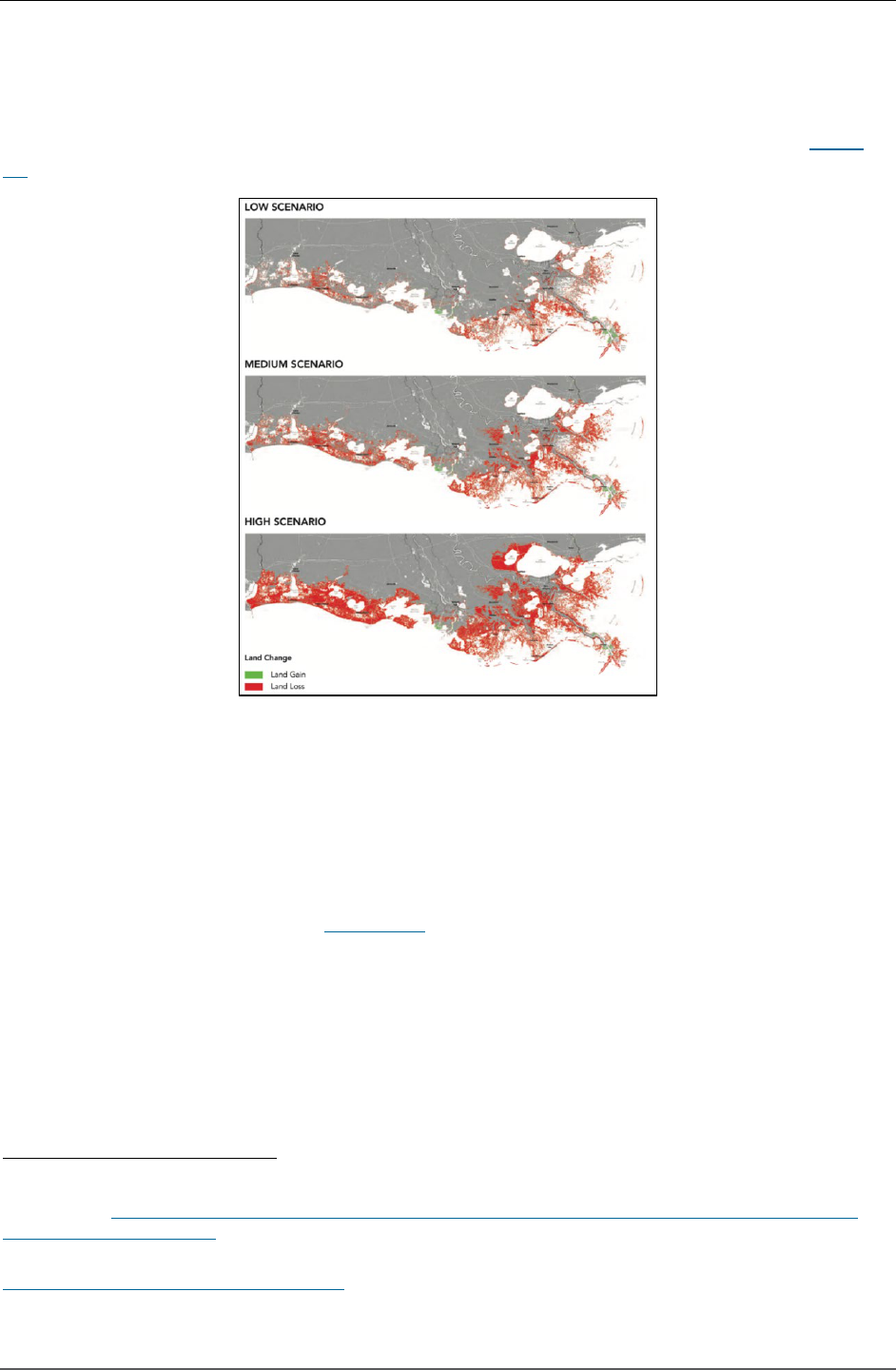
Climate Adaptation Planning: Guidance for Emergency Managers
37
2) Multiple scenarios—such as a low, medium, and high scenario—to establish a range of possible
outcomes. For example, Louisiana’s 2017 coastal master plan used three climate scenarios to
project future land changes (land lost in red or gained in green) over the next 50 years (see
Figure
12). Using multiple scenarios best captures the range of future climate uncertainties.
Figure 12: Example of Climate Scenarios Used in Louisiana’s Coastal Master Plan
84
The plan should also communicate the uncertainties associated with the key variables being used to
create objectives and strategies. For example, coastal communities that need to plan for sea level
rise should consider and communicate the difficulty of modeling rapid ice cap melting, which makes
projecting the upper bounds of sea level rise difficult.
85
Once the planning team has selected a climate scenario(s), they can use climate modeling
resources, such as those covered in Section 2.6
, to evaluate predicted future impacts. Comparing
these impacts to historical data (e.g., historical heat waves, flood levels) will enable the planning
team to estimate how the type and severity of climate impacts are expected to change.
Assess Vulnerability and Risk to Community Assets and Services
Once the planning team has predicted the types and severity of future hazards, they can conduct a
risk assessment. The risk assessment examines how vulnerable the community or a particular
facility, asset, service, or population is to the impacts of predicted climate hazards. Risk
84
Coastal Protection and Restoration Authority of Louisiana. Louisiana’s Comprehensive Master Plan for a Sustainable
Coast. (2018).
http://coastal.la.gov/wp-content/uploads/2017/04/2017-Coastal-Master-Plan_Web-Book_CFinal-with-
Effective-Date-06092017.pdf.
85
USGCRP. Fifth National Climate Assessment: Chapter 3: Earth Systems Processes. (2023).
https://nca2023.globalchange.gov/chapter/3/
.

Climate Adaptation Planning: Guidance for Emergency Managers
38
assessments are the basis for determining
which adaptation strategies will provide the
greatest risk avoidance and reduction.
In some cases, risk can be determined with a
relatively high level of accuracy. For example,
with projected flooding impacts on
infrastructure, a simple engineering analysis
can determine if a highway, bridge, building,
electrical grid component, or element of the
telecommunications infrastructure will be
compromised and possibly damaged. The
planning team can then use this information
to estimate the level of damage that might
occur and thus the costs of replacing or fixing
the damaged components. However, for other
types of vulnerabilities, such as with human populations, it is more difficult to quantify damage or
loss, including the loss of life.
86
For example, people displaced from their homes due to floods or
extreme temperatures may also face emotional, psychological, physical, and social stress due to the
disruption to their lives.
Risk assessments need to account for the probability or likelihood of these events occurring and the
likelihood of damage. The costs associated with damage or loss to the facility or asset are often
factored in as well. Yet, risk analysis differs under climate change because the environment is not
static, meaning that the risk of an event occurring will shift over time. For example, what has
historically been a 1 percent flood event (1-in-100 years) may now be a 1.25 percent flood event (1-
in-80 years), given recent climate changes. The same event might have a 2 percent (1-in-50 years)
probability of occurrence by 2050 and a 5 percent (1-in-20 years) probability of occurrence by 2100.
Similarly, the amount of damage or loss from an event may change over time as the impacts become
more severe under climate change (e.g., higher floodwaters). The use of climate scenarios is one way
of capturing a range of possible values for key climate conditions, such as temperatures and
precipitation. The scenarios then enable planners to evaluate how different amounts of change can
impact risk outcomes.
Planners must consider the cost due to damage or loss, which is more than simply the replacement
or repair cost. It often includes the societal costs of losing the functionality of the asset or facility. For
example, a damaged bridge will have costs associated with repair or replacement, but there will also
be costs to those having to find other paths to their destinations (e.g., detour time) and to those who
now have more limited options for moving people and goods.
86
For more information on the value of statistical life, see https://hazards.fema.gov/nri/data-glossary#VSL or
https://www.epa.gov/environmental-economics/mortality-risk-valuation.
THIRA/ SPR and Mitigation Planning
FEMA’s Job Aid “Increasing Resilience using
THIRA/SPR and Mitigation Planning”
describes the similarities and differences
between hazard mitigation planning and the
THIRA/Stakeholder Preparedness Review
(SPR) process and provides an overview of an
optional approach to streamline state, tribal,
and territory submissions of the hazard
mitigation plan and the THIRA/SPR. This
optional approach may reduce duplication and
maximize efficient use of these processes.
Source: https://www.fema.gov/sites/default/files/2020-
09/fema_thira-hmp_jobaid.pdf

Climate Adaptation Planning: Guidance for Emergency Managers
39
In evaluating risk, it is important to:
Consider the vulnerability of different populations and ecosystems to the predicted hazard(s) and
the populations’ ability to adapt to the impacts (e.g., adaptive capacity). In adaptation planning,
most effort is spent on identifying the level of exposure to different climate hazards. For example,
the extent of future flooding scenarios indicates which populations, facilities, structures, and
other community or environmental resources will be exposed to this hazard. How disruptive this
hazard is to individuals and groups is driven by underlying social, economic, demographic,
physical, and environmental factors. Considering vulnerability and associated equity impacts is
critical for this stage of the planning process.
Identify and focus on critical community facilities and services. FEMA’s concept of Community
Lifelines
87
are considered the most fundamental services in the community that when stabilized,
enable all other aspects of society to function. Community Lifelines are also useful in identifying
key infrastructure (for more on the cascading climate impacts to Community Lifelines, see
Appendix A
). Other institutions, including historical buildings, social or religious institutions, and
unique community features (e.g., monuments, county parks), may be identified as priorities for
investment or protection. Planners may consider the cascading impacts of potentially losing
those services in the prioritization process and they should note that economic valuation may be
insufficient to capture community concerns.
Identify assets in the community that are at high risk to climate-driven threats. Focus on assets
that could be vulnerable to climate-related hazards and risks, so they can be documented in the
plan and factored into the adaptation actions. FEMA’s description of assets of concern for local
hazard mitigation planning is a good starting point for identifying those that should be part of the
adaptation planning process. As noted in the
Local Mitigation Planning Policy Guide,
88
“Assets are determined by the community and include, but are not limited to 1)
people (including underserved communities and socially underserved
populations), 2) structures (including facilities, lifelines and critical infrastructure),
3) systems (including networks and capabilities), 4) natural, historical, and
cultural resources, and 5) activities that have value to the community.”
An important component of this definition is the phrase “determined by the community.”
Infrastructure networks, for example, already have criteria that indicate their importance (e.g., level
of demand, provision of access to other important community activities). Experience with adaptation
planning has shown that community residents can often provide important insights on which
facilities and services are critical to their everyday activities. Examples of essential community
facilities include hospitals and other medical facilities, police and fire stations, emergency operations
centers, evacuation shelters, resilience hubs, cooling centers, cultural centers, and schools.
Transportation, water, wastewater, telecommunication, and power grid networks are good examples
87
For more information on Community Lifelines, see https://www.fema.gov/emergency-managers/practitioners/lifelines.
88
FEMA. Local Mitigation Planning Policy Guide. (2023). https://www.fema.gov/sites/default/files/documents/fema_local-
mitigation-planning-policy-guide_042022.pdf.

Climate Adaptation Planning: Guidance for Emergency Managers
40
of critical infrastructure networks. Local knowledge can help identify issues and potential solutions
as seen with the Jamestown S’Klallam Tribe (Washington) case study below. Note that while impacts
to critical infrastructure are included, the community placed a higher priority on climate-related risks
to cultural, spiritual, socioeconomic, and nutritional health.
Case Study: Jamestown S’Klallam Tribe (Washington) Climate Change Risks
Excerpts from the Jamestown S’Klallam Tribe’s (Washington) climate adaptation plan.
89
Higher average temperatures will generate more extreme heat events and increased heat
stress for plants, animals, infrastructure, and humans.
Water usage from the Dungeness River is already considered critical due to multiple
competing uses, especially during low flow conditions in the late summer and early fall.
Shifting seasonal precipitation will lead to wetter winters and drier summers; winter
snowpack has decreased, and spring snowmelt occurs earlier, increasing spring flows and
decreasing summer and fall flows.
Rising sea levels will increase coastal flood risk. Furthermore, higher acidic ocean waters
will make it more difficult for some organisms to build their shells, potentially affecting
their survivability and the abundance of predator species.
The Northwestern portion of the Olympic Peninsula is projected to become drier, shifting
tree species away from primarily western hemlock to primarily Douglas fir and causing
coincident declines in western red cedar.
Climate change impacts human health directly (e.g., storm events) and indirectly through
intermediate environmental factors (e.g., air pollution).
Population-wide changes to tribally valued plants and animals have the potential to disrupt
cultural, spiritual, socioeconomic, and nutritional health.
Through a community-driven process, tribal members identified the following as the priority
areas of concern relating to climate change:
Very High Priority
Cedar harvests
Salmon, clams, and
oysters
Shellfish biotoxins
Wildfires
High Priority
Casino and Longhouse
market
State Highway 101
Tribal campus water supply
infrastructure
Medium Priority
Water supply infrastructure
Laboratory and planning
department buildings
Tribal wastewater
infrastructure
89
Jamestown S’Klallam Tribe. Climate Vulnerability Assessment and Adaptation Plan. Adaptation International. (2013).
https://jamestowntribe.org/wp-content/uploads/2018/09/3-
JSK_Climate_Change_Adaptation_Report_Final_Aug_2013s.pdf.

Climate Adaptation Planning: Guidance for Emergency Managers
41
Key Takeaways for Emergency Managers: Step 2
Identify data and information sources on past extreme weather-related events.
Lead or participate in the process of:
- Understanding past extreme weather events and their impacts to the community,
Community Lifelines, and identify lessons for the future.
- Identifying and evaluating climate scenarios and the types of impacts and consequences
these conditions may have on the community.
- Identifying underserved population groups, as well as critical community facilities,
assets, and services that could be affected by changing climatic conditions.
Collaborate with others to provide information and outreach to the community so different
groups understand the potential risks posed by climate-related hazards.
4.3. Step 3: Determine Goals and Objectives
The next step in the planning process focuses on using the information gathered during Step 2 to
develop goals, objectives, and performance metrics for the climate adaptation plan. These are then
used to guide the identification of the adaptation strategies and actions that the jurisdiction will
choose to undertake during Step
4 of the process.
Set Goals and Objectives
Goals and objectives describe the desired outcomes of the effort and inform the steps needed to
achieve them. The process of setting goals and objectives for climate adaptation planning is similar
to the process used for general and emergency planning. Given that climate adaptation planning can
incorporate a broad array of objectives over long timeframes, it is important to ensure that each
stated objective is targeted and actionable. Equally important, the process of setting goals and
objectives should incorporate a wide range of community partners, including both individuals and
organizations, to ensure a high level of buy-in with the plan and investment in its implementation.
Examples of Goals and Objectives Include:
Goal: Reduce the exposure or sensitivity (degree to which exposure impacts the system) of
critical structures, infrastructure, populations, and habitats to climate change risks.

Climate Adaptation Planning: Guidance for Emergency Managers
42
Objective: Reduce the number of households exposed to floods with a 1 percent annual
chance of occurrence – at mid-century – by at least 50 percent.
Objective: Require the adoption of energy efficient home cooling technology and design
features in all newly built housing and encourage their adoption in existing housing units.
Objective: Partner with civic centers and other key community institutions to develop
hazard response networks (e.g., planned check-ins with underserved households during a
heat wave, establishment of accessible cooling and warming stations).
Goal: Reduce the sensitivity of stormwater infrastructure to extreme rainfall events.
Objective: Make community-wide infrastructural investments and operational changes for
rainfall events that are 40 percent larger than the historical annual maximum event by
mid-century.
Objective: Encourage the adoption of green (e.g., bioswales, rain gardens) or gray (e.g.,
water reuse, bulkhead) stormwater and wastewater infrastructure by landowners.
Objective: Encourage the replacement of traditional turf with native plantings (e.g., deep-
rooted plants are often native) to reduce water needs, reduce need for artificial fertilizers,
encourage biodiversity, and to replenish the soil.
To ensure the goals and objectives help create a more resilient community with greater adaptive
capacity, it is important to develop metrics that can be used to evaluate progress. Metrics fall into
two categories: process measures and outcome measures. See Table 3
for a comparison.
Table 3: Process Measures versus Outcome Measures
Process Measures
Outcome Measures
Process measures assess adaptation
efforts or operations, as well as the
allocation of resources.
Examples include the number of staff
trained in resilience procedures, the
number of systems (e.g.,
communication, data management,
disaster response) updated for greater
resilience, and the level of planning
coordination across agencies or
governments.
90
Outcome measures evaluate performance under
specific circumstances, often within the context
of the stress or hazard for which they were
designed.
Examples include event response and recovery;
biodiversity indicators of ecosystem conditions;
measures of equity in recovery from an event or
stressor; local measures of climate and
environmental changes. Outcome measures may
also be tied to evaluation tools used to prioritize
actions (see Step 4
).
90
Boltz, Frederick, et al. Resilience Roadmap: Developing Key Performance Indicators for Climate Change Adaptation and
Resilience Planning. (2022),
https://nicholasinstitute.duke.edu/sites/default/files/publications/developing-key-
performance-indicators-for-climate-change-adaptation-and-resilience-planning.pdf.

Climate Adaptation Planning: Guidance for Emergency Managers
43
Most climate adaptation plans require a combination of process measures and outcome measures.
When developing measures, the planning team should determine which measures require the
identification of a baseline (e.g., current conditions) to compare with later conditions. Additionally,
performance metrics, like many parts of the plan, may need to be developed iteratively and re-
evaluated after strategies have been planned. In some cases, the planning team may find it
necessary to develop strategy-specific performance metrics. For a broad inventory of resilience
metrics, see the
National Institute of Standards and Technology’s (NIST) Inventory of Community
Resilience Indicators and Assessment Frameworks.
91
For an example of goals and objectives from
Hennepin County, Minnesota, see the case study below.
Case Study: Goals and Objectives in Hennepin County’s Climate Action Plan
In May 2021, Hennepin County, Minnesota, published a Climate Action Plan with strategies for
mitigating and adapting to climate change. Below is a sample of their goals and objectives:
Goal: Increase the resilience of the built environment and protect natural resources.
Objective: Climate risks and impacts on county buildings and infrastructure are assessed
and mitigated.
Objective: The county employs green and natural infrastructure to increase resiliency of the
built environment, especially in areas at high-risk for localized flooding and extreme heat.
Goal: Protect and engage people, especially vulnerable communities.
Objective: The county’s response to climate change prioritizes the protection of the most
vulnerable residents and advances equitable health outcomes.
Objective: Residents, businesses, and organizations pursue individual actions and support
collective actions that drive systems change.
92
Key Takeaways for Emergency Managers: Step 3
Collaborate with community partners to outline the desired outcomes of the plan and the
objectives that can frame individual actions or strategies.
Ensure that objectives are targeted, actionable, and incorporate the perspectives and
priorities of the collaborative planning team established in Step 1.
Lead or participate in the development of performance metrics that can be used to
measure the effectiveness of the goals and objectives.
91
For more information on NIST’s Inventory of Community Resilience Indicators and Assessment Framework, see
https://data.nist.gov/od/id/mds2-2297
.
92
Hennepin County, Minnesota. Climate Action Plan. (2021). https://www.hennepin.us/climate-action/climate-action-plan.

Climate Adaptation Planning: Guidance for Emergency Managers
44
4.4. Step 4: Develop the Plan
Step 4 of emergency operations planning described in CPG 101 focuses on developing courses of
action to accomplish goals and objectives established during Step 3. St
ep 4 focuses on identifying
and prioritizing the strategies and actions that the jurisdiction will take to address climate-related
risks, as well as the resources and information necessary to implement those actions. The outputs of
this step are then used to write and review the plan in Step 5.
Develop and Analyze Resilience Strategies and Actions
Step 2 and Step 3 identified the community’s climate-related risks, their impacts, and the
community’s goals and objectives. Using this information, the planning team now identifies
strategies and actions to avoid or mitigate those risks and achieve the identified goals and
objectives. This process involves not only technical staff and subject matter experts, but also
includes community outreach to collect public input on strategies and actions. Adaptation plans
typically include a broad range of strategies and actions; some strategies or actions may be mutually
exclusive (e.g., disaster waste management or electric car charging stations along evacuation
routes).
Although the identification o
f adaptation strategies and actions is a locally-led process, there are
many resources that present information on different types of adaptation strategies. For example:
SLTT communities now have more access to cleaner (low-carbon) materials through eligible
FEMA programs, as communities rebuild or take initiatives to become more resilient. This
ensures communities can help advance the clean energy economy as they confront the impacts
of the climate crisis.
93
The U.S Climate Resilience Toolkit pr
ovides a wide-range of possible adaptation strategies and
actions relating to the built environment, coasts, ecosystems, energy, food, health, marine,
transportation, tribal organizations, and water.
94
The Drought and Infrastructure - A Planning
Guide can be used to anticipate and prepare for the consequences of drought on infrastructure
services. The toolkit also includes filterable case studies by climate threat (or stressor), topic,
resilience step, or region.
95
93
For more information on Building a Clean, Climate-Resilient Economy through FEMA’s Grant Programs, see
https://www.fema.gov/grants/policy-guidance/low-carbon-goals.
94
NOAA, U.S. Climate Resilience Toolkit. (2014). https://toolkit.climate.gov.
95
For more information on Drought Guide, see https://toolkit.climate.gov/reports/drought-and-infrastructure-planning-
guide and for case studies, see https://toolkit.climate.gov/case-studies.
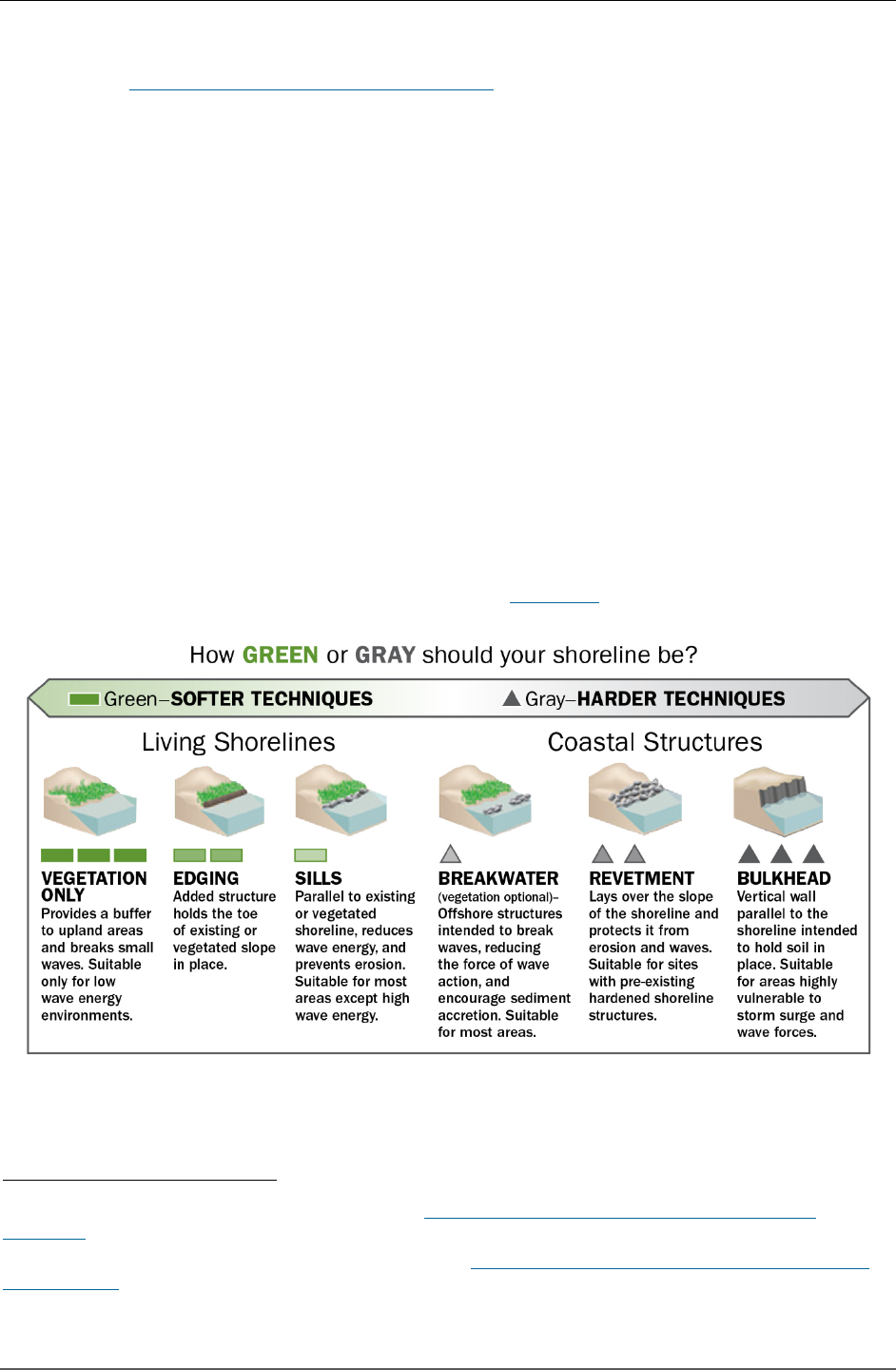
Climate Adaptation Planning: Guidance for Emergency Managers
45
The EPA’s Strategies for Climate Change Adaptation identifies strategies that can be applied to
the natural environment (e.g., air, water, waste, public health).
96
Many climate adaptation plans focus on physical (engineered) improvements to structures and
infrastructure or emphasize the importance of education and raising awareness of climate-related
risks. In addition to the physical improvements, ecosystem or nature-based adaptation strategies
use biodiversity and ecosystems as a means of reducing climate-related risks. An example of this is
extending or enhancing coastal wetlands to protect the land located behind them.
Most adaptation strategies and actions focus on achieving one or more objectives. For example, a
plan might have twin objectives of reducing the sensitivity of stormwater infrastructure to extreme
rainfall events and reducing biodiversity loss throughout the community. Broader use of “green”
infrastructure design concepts could be an applicable adaptation strategy for both objectives.
Adaptive capacity, on the other hand, is the ability of individuals or systems (e.g., infrastructure, a
community, an ecosystem) to adjust to climate stressors. One objective might be to increase the
adaptive capacity of critical infrastructure. A corresponding strategy might be building redundancy
into network operations so that functionality lost through damage to one portion of a network is
automatically replaced with functionality from another portion of the network. Consider the pros and
cons along a green to gray infrastructure continuum (See Figure 13
below).
Figure 13: Coastal Shoreline Continuum
97
96
EPA. Strategies for Climate Change Adaptation. (2022). https://www.epa.gov/arc-x/strategies-climate-change-
adaptation.
97
For more information on Understanding Living Shorelines, see https://www.fisheries.noaa.gov/insight/understanding-
living-shorelines.

Climate Adaptation Planning: Guidance for Emergency Managers
46
Different types of strategies can be used to implement adaptation actions. In some cases, existing
institutional mechanisms or structures, such as changing building codes,
98
may make
implementation straightforward. Sometimes, implementation may need to be tailored to current
institutional structures (e.g., government agencies, organizations), or a new structure put in place.
Examples of Implementation Strategies
99
Legal/Regulatory: Useful for ensuring a minimum standard of performance or condition
but often difficult to use politically.
Market: Includes such tools as financial incentives, grants, interest-free loans, all-hazard
risk insurance, taxes and fees. Fairly flexible in implementation, but desired outcome is
not guaranteed due to uncertainty in individual, household, organization, or agency
behavior. Often used to create a niche market for certain types of adaptation strategies.
Partnerships: Voluntary agreements or compacts among agencies and organizations to
achieve desired outcomes. Effectiveness depends on the ability of participants to assign
the staff and funding resources to make the partnership work. Pooled resources of
participants often raise questions of appropriate contributions to the partnership.
Persuasion and Awareness: Usually implemented through web-based communication and
exchange capabilities, in-person outreach, newsletters and awareness campaigns.
Outreach helps to develop support for plan and individual strategy implementation but
rarely successful in implementation by itself.
Hybrid Planning: Combination of different implementation strategies based on a
systematic understanding of how the different strategies interconnect and interoperate to
achieve community climate resilience.
When identifying strategies and actions, it is important to consider and document implementation
needs. These needs affect strategy or action selection and prioritization. The planning team should
identify or establish an entity (e.g., agency, organization) to be responsible for the implementation of
each strategy or action. The team should also outline the relationships that will provide leadership in
the implementation phase. This includes making sure stakeholders have 1) a common
understanding of desired outcomes and how individual strategies contribute to achieving them, 2) an
understanding of the timeframe for implementation of each strategy, and 3) awareness of the key
stakeholders and partners who might help implement the strategy.
98
For more information on FEMA’s Building Code Strategy, see https://www.fema.gov/emergency-managers/risk-
management/building-science/building-codes-strategy.
99
Adapted from: European Commission. Guidelines on Developing Adaptation Strategies. (2013). https://eur-
lex.europa.eu/legal-content/EN/TXT/?uri=CELEX:52013SC0134.

Climate Adaptation Planning: Guidance for Emergency Managers
47
Prioritize Strategies and Actions
Once strategies have been identified, the next step is to determine which strategies and actions to
prioritize. These priority strategies and actions then become the basis for the climate adaptation
plan. Prioritization is driven by one primary question; which of the options best help achieve the
adaptation plan goals and objectives given a range of possible climate futures? In other words,
prioritization identifies robust actions that achieve optimal results across a range of climate
scenarios. From an emergency management perspective, actions may include but are not limited to:
Evacuation planning;
Sheltering facilities;
Floodplain management;
Public information campaigns;
Supply chain logistics; and
Cooling or heating centers and resilience hubs
.
Prioritization is usually based on a set of criteria that reflect the most important community concerns
relating to desired plan outcomes. The planning team should determine which criteria to use with the
input of whole community stakeholders. In some cases, quantitative criteria, such as monetary risk
estimates or the population considered underserved to a particular hazard, are used. In other cases,
the criteria could include subjective assessments of overall effectiveness or risks associated with
each option. For example, some climate adaptation planning efforts use subjective values of low,
medium, or high based on the collective opinions of experts, staff, decision-makers, or the general
public. And in some cases, such efforts have used a combination of quantitative and qualitative
assessments.
Examples (in alphabetical order) of criteria that are often found in prioritization efforts include:
Additional benefits: Does the strategy or action have additional, perhaps unquantifiable, benefits
beyond enhanced climate resilience for the community? All things being equal, those strategies
and actions that provide additional benefits would be preferred over those that do not.
Benefit-cost analysis: In some cases, it is possible to estimate the cost of implementing a
particular action as well as to assign monetary values to the expected benefits of
implementation. This could be done in a straightforward manner, such as measuring the benefits
of reduced damage to buildings, or may require a more nuanced approach, such as assigning a
monetary value to social and environmental benefits (e.g., positive health impacts). Using
benefit-cost analysis examines strategies through a monetary lens, weighing whether the
benefits exceed the cost. Such analyses can also be used to determine the extent to which one
action is more beneficial than another.
Cost-effectiveness: In many cases, the cost to implement a strategy or action can be estimated,
along with the outcome, or benefit, expected from the investment. Cost-effectiveness criteria
estimate the expense that is required to produce a given outcome or output. Examples include

Climate Adaptation Planning: Guidance for Emergency Managers
48
the average dollar amount needed, per home, to harden against tropical storms; the cost to
reduce a community population’s vulnerability to a specific potential hazard by X percent; and
the investment necessary to reduce the incidence of a serious health hazard to X percent.
Equity: Assessing the equity impacts of climate adaptation strategies begins with evaluating how
different demographic groups benefit or are harmed from a given action. A key question is, what
individuals or community groups are reaping benefits and who is negatively affected? Special
consideration should be given to historically underserved groups, such as low-income, minority,
elderly, chronically sick, and mobility-impaired people and households. The equity criterion
intends to allocate the benefits and costs of climate adaptation investment equitably across a
community in a manner that reduces, rather than perpetuates, existing inequities.
Flexibility: Given the uncertainty in the timing and scale of climate hazards and risks, many
climate adaptation plans emphasize strategies and actions that can be phased in over time or
whose adaptive capabilities can be easily expanded.
Implementation feasibility. This criterion reflects the legal, financial, organizational, political, and
social challenges associated with implementing a strategy or action. Some strategies may offer
significant risk reduction potential yet face major political or social barriers. Alternatively, some
strategies may be “low-hanging fruit” and able to be quickly and easily implemented.
Robustness: Given the uncertainty of future climate conditions, strategies that provide resilience
benefits under different scenarios are preferable over those whose benefits only occur with one
possible future. This is particularly applicable to strategies or actions that mitigate current
threats, hazards, or risks and provide long-term benefits at the same time. This analysis should
also consider timing and the consequences of taking no action. A particular action may be
significantly more costly or ineffective (e.g., conservation of key habitat) if the action is delayed.
Identify Resource and Information Needs
After selecting strategies and actions undertaken, planners identify the resources and information
needed to carry out actions of the adaptation plan. Resource requirements will vary widely
depending on the strategies or actions selected and can encompass a wide range of items, such as
engineering or construction equipment; site-specific analytics, including measurement or analytical
tools (e.g., drones, computers); external funding; new hires or volunteers; land needs, natural
resources (e.g., seeds, saplings), or habitat-specific interventions (e.g., endangered species).
Resources should be listed without regard to current availability. Then, the planning team can
identify what resources are currently available and what will need to be obtained moving forward.

Climate Adaptation Planning: Guidance for Emergency Managers
49
Case Study: New Mexico’s Plan for Burying Powerlines
The 2011 Las Conchas fire was started by a downed power line in the Santa Fe National
Forest. It burned more than 156,000 acres, 63 homes, and 49 additional structures with total
midpoint damage estimates of $615 million. Climate projections indicate that New Mexico will
further be impacted by stronger winds and drier seasons which in turn increase the risk of fires
and the potential for flooding from burn scars. Buried power lines would reduce the risk of
ignition as these lines are not susceptible to damage from high winds or falling trees.
After seeking funding through other means, the Los Alamos Department of Public Utilities
reached out to their County’s Office of Emergency Management to see if they could partner
together to fund the burying of these power lines through hazard mitigation grant dollars. Since
the project was listed in the Hazard Mitigation Plan, it was a potential funding source for this
proposal and it is currently being reviewed for approval.
Partnerships, such as through mutual aid agreements, are an important method for obtaining
resources not readily available to a community, particularly for smaller or under-resourced
communities. Identifying regional partners that either have the needed resource or have a similar
need for the same resource can help cut costs and establish mutually beneficial working
relationships. These partners may be governmental or non-governmental. Local businesses, for
example, may be willing to provide certain resources or be willing to help fund their acquisition.
External funding sources, such as federal or state grants, are another good mechanism for obtaining
needed resources. For a list of emergency management funding resources, see Appendix C
.
Key Takeaways for Emergency Managers: Step 4
Lead or participate in the multi-agency and multidisciplinary process of identifying and
prioritizing strategies and actions to enhance community resilience.
Draw upon experience and local knowledge of past hazard events in the formation of
adaptation strategies and actions.
Encourage innovation in developing new strategies and actions.
Contribute to the preparation of the climate adaptation plan by linking information relating
to the local hazard mitigation plan, recent experience with climate-related hazards and
community preparedness.
Identify the physical, financial, or institutional resources and information needed to
implement strategies or actions.

Climate Adaptation Planning: Guidance for Emergency Managers
50
4.5. Step 5: Prepare and Review the Plan
Step 4 resulted in a set of prioritized strategies and actions for enhancing community resilience to
climate related threats, hazards and risks. The next step is to prepare and review the plan. This
includes writing the actual plan, leveraging the information from
Steps 2, 3, and 4.
Climate Adaptation Plans Components
A summary of the expected climate impacts to the community and region; background on
the methods and approach used to evaluate risk; the results of the local and regional risk
analysis; and key threats to underserved populations and important community assets.
Specific goals and objectives that outline the long-term desired outcomes for the
community and break these goals into targeted and actionable steps.
Strategies, actions, and responsibilities to achieve one or more objectives through targeted
policy, investment, engagement, operational changes, and institutional reform.
Review of a climate adaptation plan follows a similar pattern to that for traditional planning. First, the
planning team should review the plan and then make it available to other pertinent stakeholders
(e.g., community organizations, local institutions, subject-matter experts, the public). Given that the
adaptation plan may be the first within a jurisdiction, it may be useful to review peer community
plans and use these as a source of comparison. This can help identify areas that are under-
developed in the current draft plan, such as the rigor of the performance metrics. Similar to the
process in CPG 101, three criteria can be used when evaluating the plan:
Adequacy: Does the scope of the plan include the primary (and potential secondary) climate
threats to the community? Do the plan’s goals, objectives, strategies, and actions propose a
course for mitigating climate-related risk? Are the plan’s assumptions (e.g., climate science)
valid?
Feasibility: Are the organizations or agencies capable of accomplishing assigned tasks, either
with available resources or with reasonable expectation of securing necessary resources? Are
the timeline and project size sufficient to meet the stated need and practical? Can coordination
with necessary stakeholders or government agencies be secured?
Acceptability: Do the adaptation strategies meet the threats posed by climate change? Are the
strategies and objectives designed to be equitable and achieve social as well as physical
resilience? Is the plan consistent with the law and with relevant guidance?

Climate Adaptation Planning: Guidance for Emergency Managers
51
These criteria can be used to evaluate the plan’s goals, objectives, and strategies, along with how
they are coordinated and allocated across agencies or stakeholders. Moreover, they can be useful in
assessing whether the resources needed to implement a strategy or action are immediately available
or whether outside funding sources will need to be pursued. The Tompkins County, New York case
study below provides an example of a final climate adaptation chapter in a comprehensive plan.
Case Study: Tompkins County, New York Climate Adaptation Strategy
The Tompkins County Comprehensive Plan includes a chapter on adaptation.
100
This chapter
indicates that it is the policy of Tompkins County to:
Maintain floodways and limit floodplain development to reduce damages from flooding;
Improve connectivity of open space to prevent fragmentation of ecosystems;
Promote adaptation measures that lessen climate impacts on the local economy;
Encourage actions that protect underserved populations from climate change impacts; and
Prepare for community recovery in the event of disaster.
The Tompkins County Department of Planning and Sustainability also developed a Resiliency
and Recovery Plan to help reduce the risks associated with hazards and the changing climate.
The plan lays a foundation for collaborative action with each of the municipalities in Tompkins
County and a broad group of stakeholders. It addresses four critical areas from the County’s
Hazard Mitigation Plan: Flooding, Drought, Debris Management, and Economic Recovery.
Key Takeaways for Emergency Managers: Step 5
Lead or participate in multi-agency efforts to write and review the climate adaptation plan.
Help identify the roles and responsibilities of stakeholders to carry out the plan.
Provide information on possible funding sources to implement planned strategies and
actions.
100
Tompkins County, New York. Tompkins County Resiliency and Recovery Plan. (2022).
https://tompkinscountyny.gov/planning/climate-adaptation
.

Climate Adaptation Planning: Guidance for Emergency Managers
52
4.6. Step 6: Implement and Maintain the Plan
Once reviewed, approved, and released, implementation and maintenance of the plan begins. This
step focuses on monitoring and evaluating the performance of the plan, updating the plan as
needed, and mainstreaming adaptation planning in the community.
Implementation is a long-term process. Some tasks will occur soon while other strategies are
updated and executed over a course of years. The callout box below outlines key considerations for
implementation.
Considerations When Implementing and Maintaining the Plan
Assigning sub-tasks to individuals, groups, or organizations;
Obtaining the financial resources to pay for implementation;
Developing interorganizational partnerships and agreements when implementation
includes multiple players;
Developing a constituency for the different actions among key stakeholders and the
public; and
Linking assigned actions to the decision-making processes of that organization(s).
As with most planning efforts, climate adaptation planning is an iterative process that entails regular
reviews and adjustments. Updates are particularly important for climate adaptation planning where
advances in climate science occur constantly, new data sources become available, intervening
extreme weather events provide new information on the severity and extent of the resulting damage,
and the communities themselves can change in various ways.
Monitor and Evaluate Performance
Monitoring and evaluating the performance of the plan and regularly reviewing the underlying
assumptions is an important part of assessing whether a community’s climate adaptation plan is still
relevant and meeting the desired outcomes. Monitoring should address the criteria in the
performance metrics designed in Step 3
b
ut should also ensure the underlying assumptions that led
to the selection of adaptation strategies are still valid. For example, collecting data on recently
implemented NBS to verify if there was a reduction to frequently flooded areas. This information

Climate Adaptation Planning: Guidance for Emergency Managers
53
provides an important feedback loop to
determine whether adjustments to the plan are
needed. Analyzing individual strategy
effectiveness could lead to minor adjustments
or they might suggest a rethinking of the entire
strategy.
Ideally, an agency or multi-agency structure
would be designated to lead the
implementation, monitoring, evaluation, and
revision of the plan. For some communities, this
may be the emergency management agency,
who is already monitoring for hazard mitigation
plans and THIRAs, as well as evaluating
exercises and real-world events through after-
action reports.
Update the Goals, Objectives, and Metrics
of the Plan
Revising or updating a climate adaptation plan
can occur periodically, such as every five years
or when circumstances dictate, or in the
aftermath of a particularly severe extreme
weather event. The plan should establish this
process and the update should be undertaken
by the same (emergency management) agency
or a multi-agency structure that coordinates
monitoring and evaluation. Updating the plan
might include altering how a goal or objective
is being implemented, or it may involve altering
the strategy itself. In the latter instance,
strategy changes should be vetted with
leadership to ensure that their implementation
is feasible. Even evaluating what strategies
and implementation practices have been
ineffective is a useful learning exercise for
future planning or potential funding efforts.
Training and Exercise the Plan
Trainings and exercises provide
opportunities to stay up to date with
current climate science and tools as well as
a chance to learn about best practices
used by other jurisdictions.
FEMA’s Exercise Starter Kits and Long-
Term Community Resilience Exercise
Resource Guide are a “one-stop-shops" for
any jurisdiction or organization looking to
conduct a climate-focused exercises. For
more information, see Appendix D.
Factors for Updating Climate Plans
New information on climate science
New data and tools for vulnerability and
risk analysis
Experience with recent extreme weather
events
Community development patterns
Population characteristics
Community values
Updates to other community plans and
strategies
Addition of new staff and expertise
New technology innovations that change
demand and service patterns
Laws and regulations

Climate Adaptation Planning: Guidance for Emergency Managers
54
Case Study: New Orleans, Louisiana Tree Planting for Canopy Cover
Over the last 20 years, the City of New Orleans has seen considerable tree canopy loss due to
storms and hurricanes such as Katrina (2005) and Ida (2021). The lack of canopy cover
contributes to the urban heat island effect, causing parts of the City to be nearly nine degrees
hotter than others. These heat islands disproportionately affect lower-income areas.
The City worked with the nonprofit SOUL (Sustaining Our Urban Landscape) to develop a
Reforestation Plan to reverse this canopy loss and prioritize work in historically disadvantaged
neighborhoods. Over time, these trees will decrease extreme heat and reduce street flooding
by increasing water absorption. The city has used a combination of public and private grants to
begin planting the trees and training the urban forestry workforce to maintain them during
drier and warmer periods, which are becoming more frequent with climate change.
New Orleans has a Climate Action Goal to plant 40,000 trees by 2030. With the Hazard
Mitigation Plan due for updates in 2025, the City will look to benchmark the progress that has
been made towards the 2030 goal. Between 2017-2023, 17,914 trees have been planted.
Figure 14: Volunteers planting a tree in the Algiers Neighborhood of New Orleans
Source: https://soulnola.org/reforestationplan/.
Key Takeaways for Emergency Managers: Step 6
Participate in multi-agency efforts to raise community awareness and implement
adaptation plan recommendations.
Collect data and information on climate-related hazards to inform future plan updates and
monitor the performance of implemented strategies.
Lead or participate in evaluating whether implemented and recommended adaptation
strategies are still appropriate given changing environmental conditions.
Coordinate changes in the local hazard mitigation plan with the strategies of the
adaptation plan and continue to monitor and evaluate overtime.

Climate Adaptation Planning: Guidance for Emergency Managers
55
5. Conclusion
The purpose of this guide is to help SLTT emergency managers incorporate climate adaptation into
emergency management planning efforts. The six-step planning process presented here is broadly
applicable to many different climate adaptation planning contexts, yet the individual actions and
planning roles are designed to help SLTT emergency managers both lead and support climate
adaptation planning. Emergency managers’ experience identifying and mitigating hazardous threats
and vulnerabilities can be of great use in planning for long-term community resilience and
adaptation even as climate change continues to be a “risk multiplier.”
Many of the initial steps in the climate adaptation planning process presented here are similar to
those used in CPG 101
; however, as described earlier, there are several key differences:
1) While planning and preparing for emergencies always involves uncertainties and a need to
assess risks, climate-related threats magnify this uncertainty due to an inability to predict future
emissions and climate mitigation policies. Therefore, adaptation planning should address multiple
climate scenarios (e.g., intermediate emissions, high emissions) and investigate which projections
are most applicable to the community.
2) Actions to address the changing climate, as well as knowledge of climate science and
vulnerabilities, are constantly evolving. Planning for climate-resilient communities should become an
iterative process to ensure that strategies and plan priorities reflect the best information available.
Furthermore, exercising, monitoring, and adjustment of plan implementations ought to occur
regularly to optimize the effectiveness of adaptive actions. Changing economic and demographic
considerations may also necessitate adjustments to the plan or its implementation.
3) Creating and sustaining a climate-resilient community is most feasible when adaptive responses
are incorporated into all aspects of community planning and decision-making. Moreover, the equity
implications of both climate impacts and responses should be an important part of the discussion
both in creating the adaptation plan and in developing other community plans and policies. A
thorough and iterative planning process, along with strong community partnerships that draw on a
range of social and technical expertise, will create a strong foundation for building and sustaining a
climate-resilient community.
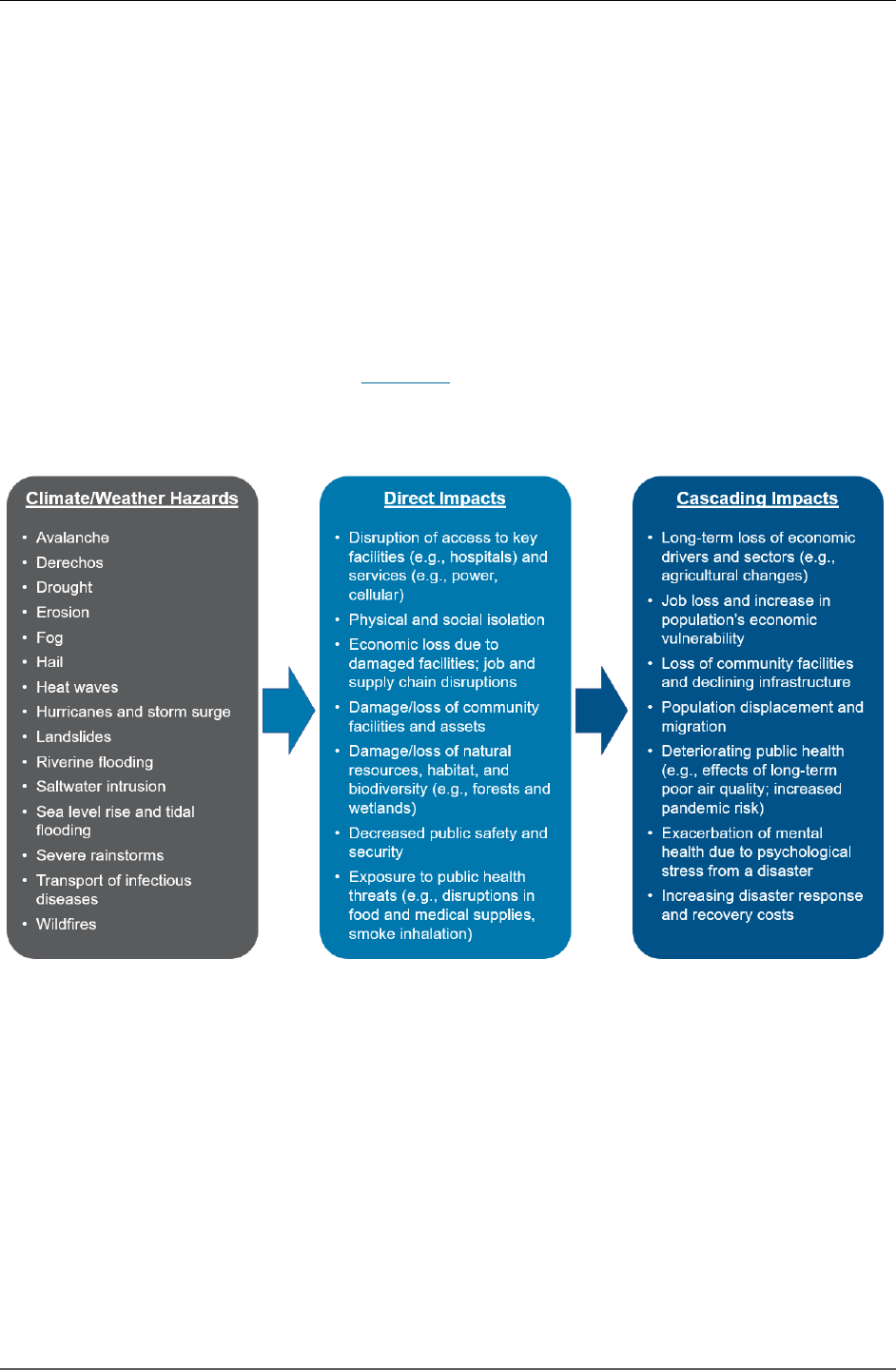
Climate Adaptation Planning: Guidance for Emergency Managers
56
Appendix A: Climate Impacts on Emergency Response
and Recovery Planning
The climate hazards that regions and communities are occasionally exposed to will become more
frequent, severe, and afflict new areas. Some of the most damaging events have been the result of
combined weather phenomena, producing multiple hazards simultaneously. Hurricane Sandy, for
example, was the combined result of a nor’easter and a hurricane, producing devastating results.
Natural hazards can also co-occur with other phenomena amplifying the overall risk. In 2021,
Louisiana was hit by the second-most damaging hurricane in the state’s history, Hurricane Ida, in the
midst of the COVID-19 pandemic, putting greater stress on the area’s hospitals, among other social
and economic impacts of the pandemic. Figure A-1
highlights hazards that may have direct (or
primary) and cascading (or secondary) impacts. Weather extremes will also likely directly impact or
cause cascading impacts to response planning and into recovery.
Figure A-1: Climate Hazards and Their Direct and Cascading Impacts

Climate Adaptation Planning: Guidance for Emergency Managers
57
Figure A-2: Example of Direct and Cascading Impacts on Energy Infrastructure
101
Using the eight Community Lifelines and six Recovery Support Functions (RSF), below is a bulleted
list of direct or cascading impacts from an emergency response and recovery perspective.
Safety and Security Lifeline
An anticipated increase in climate-related events may strain state, local, tribal, and territorial
(SLTT) response resources and capacities, resulting in increased requests for federal support.
Decreased water volumes in remote streams and ponds may hamper firefighting capabilities.
Persons with disabilities and those who live in rural areas have restricted (or lack) access to
government services.
Under-resourced populations and communities may lack access to capital that could help
support resilience investments.
Food, Hydration, Shelter Lifeline
Temperature and precipitation extremes may affect water quality and availability, agricultural
productivity, ecosystems, and species.
Thawing permafrost may lead to unsafe food storage and preservation.
People with disabilities have high rates of illness, injuries, or death during extreme events, as
cognitive, hearing, physical, and mobility impairments may impede their safe evacuation.
Sheltering needs may overwhelm SLTT capacities due to increases in climate-related events.
Federal support may be required for the provision of additional sheltering and/or the relocation
of impacted populations to unaffected areas.
Wrap-around services may need to be provided for survivors waiting to access aid sites to ensure
their health and well-being (e.g., moving water distribution to shaded areas in extreme heat
scenarios). Pre-identified aid sites may need to be reevaluated to ensure protection for those
awaiting access.
101
USGCRP. Fifth National Climate Assessment: Chapter 5: Energy Supply, Delivery, and Demand. (2023).
https://nca2023.globalchange.gov/chapter/5/.

Climate Adaptation Planning: Guidance for Emergency Managers
58
Health and Medical Lifeline
102
More frequent and severe heat waves will lead to more heat-related illnesses and deaths.
Changes in the timing and lengths of the seasons may cause shifts in the geographic areas
where disease-carrying insects such as mosquitoes, ticks, and fleas typically transmit West Nile
Virus, dengue fever, Lyme disease, malaria, and other diseases.
Increasing temperatures may cause degradation of air quality, exacerbating health conditions
such as heart disease.
Increased plant growing seasons may increase pollen exposure. A greater number of severe
storms will also increase mold exposures. Increased temperatures and wildfire risk will further
lead to more air pollution. All of these changes may worsen lung diseases and other health
problems.
Extreme weather events are associated with an increased risk of food- and water-borne illnesses,
as sanitation services, hygiene measures, and safe food and water supplies are often
compromised after such events.
An increase in the loss of patient medications is expected due to a larger number of power
outages and subsequent lack of refrigeration capabilities.
Increasing frequency and severity of wildland fires will reduce ambient air quality causing
increases in respiratory distress, especially among those with respiratory ailments, children, and
the elderly.
Energy Lifeline
Power transmission line capacity will decline at higher temperatures, reducing power availability;
extreme heat may also cause powerlines to droop.
103
Extreme temperatures increase demand for cooling and heating capabilities, which may result in
electricity shortfalls.
Climate-related incidents, such as increases in extreme heat and wildfires, will increase the
likelihood of public safety power shutoffs, limiting access to power.
Extreme flooding or severe weather may threaten energy infrastructure.
Underserved communities are historically the last communities to have their utilities restored.
Communications Lifeline
Extreme flooding or severe weather may impact communications infrastructure due to damage
or loss of power.
Buried fiber optic cables and nodes, which provide communications and internet services, are at
risk of failure due to sea level rise and flooding. Similar fiber optic cable issues may occur above
ground due to high winds associated with hurricanes, derechos, and other extreme weather
102
U.S. Department of Health and Human Services. Climate Change and Health Equity. (2022).
https://www.hhs.gov/climate-change-health-equity-environmental-justice/climate-change-health-equity/index.html.
103
National Public Radio. During the heat wave in the Pacific Northwest in 2021, the intense heat melted some power
cables in Portland. (2021). https://www.npr.org/2021/06/29/1011269025/photos-th
e-pacific-northwest-heatwave-is-
melting-power-cables-and-buckling-roads.

Climate Adaptation Planning: Guidance for Emergency Managers
59
events. Communications nodes are often clustered at low elevations around dense populations.
Fiber buried on land is water- and weather-resistant but is not designed to be submerged.
104
Persons with access and functional needs will require the need of assistive technology or other
communication support to receive information and how to respond during a disaster.
Transportation Lifeline
Extreme heat can warp railways, impacting rail operations, and can cause paved surfaces to
buckle, disrupting transit and making it difficult for airplanes to take off.
105
Higher winds and wildland fires may disrupt air traffic.
An increase in flooding or weather events that result in the accumulation of debris will impact
transportation routes.
More than 60,000 miles of roads and bridges in coastal areas are at risk of flooding from
climate-change-related sea level rise.
106
Permafrost thaw may reduce the viability of roads made of ice and snow and damage
transportation infrastructure due to ground sinking.
107
Compounding climate-related weather events that impact the transportation system could
severely impact supply chains due to worker attrition or flooded routes. Disruptions to supply
chains will impact operations, logistics, and management activities for response and recovery.
The development of community-specific distribution management plans that highlight vulnerable
transportation infrastructure and alternate commodity points of distribution should be supported.
Disruptions to transportation infrastructure can affect communities and their access to food,
healthcare systems, and social services.
Hazardous Materials Lifeline
Increased climate-related weather events may result in larger quantities of waste materials that
require processing. This may lead to increased greenhouse gas (GHG) emissions from waste
management activities as well as insufficient capacities for handling surges in the necessary
recycling, treatment, and disposal processes for the waste generated.
108
Extreme weather events may impact industrial facilities resulting in contamination of surrounding
communities (often low-income communities) requiring permanent evacuation and exposure to
hazardous materials.
Severe storms and heavy flooding are likely to result in industrial process disruptions which
could result in autocatalytic reactions, explosions, and discharges when a facility is not able to
104
National Public Radio. Rising Seas Could Cause Problems For Internet Infrastructure. (2018).
https://www.npr.org/2018/07/16/627254166/rising-seas-could-cause-problems-for-internet-infrastructure.
105
USGCRP. Fifth National Climate Assessment: Chapter 13: Transportation. (2023).
https://nca2023.globalchange.gov/chapter/13/.
106
EPA. Climate Change Impacts on Coasts. (2023). https://www.epa.gov/climateimpacts/climate-change-impacts-coasts.
107
USGCRP. Fifth National Climate Assessment: Chapter 29: Alaska. (2023).
https://nca2023.globalchange.gov/chapter/29/.
108
EPA. Waste Management Planning to Mitigate the Impact of Climate Change. (2023). https://www.epa.gov/homeland-
security-waste/waste-management-planning-mitigate-impact-climate-change.

Climate Adaptation Planning: Guidance for Emergency Managers
60
store chemicals at the proper temperature on alternate power sources or properly shut down
continuous flow process.
Low-income communities are often disproportionately impacted by hazardous materials events
due to their proximity to hazardous facilities or transportation routes. These communities may
also have limited resources to respond to and recover from such events.
Indigenous communities who practice subsistence farming and fishing are particularly vulnerable
to the impacts of hazardous materials.
Water Systems Lifeline
Thawing permafrost may lead to the deterioration of reservoirs and impoundments that rely on
the existence of permafrost for wastewater containment.
The intersection of flooding and warmer weather may cause bacterial growth in local water
sources, leading to health concerns (e.g., toxic algae blooms).
Aging water infrastructure threatens the quality of drinking water. This infrastructure is
unprepared to cope with risks worsened by climate change, including flooding, drought, and
waterborne diseases.
In coastal and island areas, aquifers are threatened by saltwater intrusion, which can harm
water infrastructure and make groundwater not drinkable.
Community Assistance Recovery Support Function
Equity issues regarding illiteracy should be taken into consideration when conducting community
engagement and training.
Community assistance efforts and climate considerations should be incorporated into long-term
recovery planning support strategies.
Economic Recovery Support Function
Labor hours lost by weather-exposed workers due to high temperature days.
109
There is also an
equity consideration on the demographics of weather-exposed workers.
Increase in property damage and business income losses due to increasing frequency and
intensity of climate-related hazards.
The displacement of socially vulnerable and underserved people may often coincide with the
displacement of essential, front-line workers who are the foundation of a community’s economy.
Health and Social Services Recovery Support Function
Individuals are at higher risk of developing chronic illnesses such as asthma, or fatalities from
cancer, residing in areas with higher counts of particulate air pollution.
110
109
EPA. Climate Change and Social Vulnerability in the United States. (2021).
https://www.epa.gov/system/files/documents/2021-09/climate-vulnerability_september-2021_508.pdf.
110
National Institutes of Health. The Impact of Disasters on Populations with Health and Health Care Disparities. (2010).
https://www.ncbi.nlm.nih.gov/pmc/articles/PMC2875675/.

Climate Adaptation Planning: Guidance for Emergency Managers
61
Climate-related disasters can drive higher incidence of mental and behavioral health issues,
post-traumatic stress disorder, and substance abuse.
111
Housing Recovery Support Function
Temporary housing and sheltering will continue to be a prominent and challenging aspect of
disaster recovery.
Infrastructure Systems Recovery Support Function
Projects should leverage resilience funding support for projects that adhere to consensus-based
building codes and standards for low-carbon materials.
112
Recovery-funded grant projects should emphasize mitigation measures (e.g., through the Hazard
Mitigation Grant Program [HMGP] and 406 Mitigation funding) that support risk reduction
actions, climate adaptation actions, and nature-based or green infrastructure solutions.
Benefit-cost calculations should be streamlined for hazard mitigation solutions that are local,
sustainable, and nature based, when possible, to enable better alignment with grant obligations
and planning timelines.
Natural and Cultural Resources Recovery Support Function
Anticipated increase in the frequency and intensity of weather events will pose a heightened risk
to the protection of cultural heritage resources.
111
Substance Abuse and Mental Health Services Administration. Climate Change and Health Equity. (2023).
https://www.samhsa.gov/climate-change-health-equity.
112
FEMA. Recovery and Resilience Resource Library. https://www.fema.gov/emergency-managers/practitioners/recovery-
resilience-resource-library.

Climate Adaptation Planning: Guidance for Emergency Managers
62
Appendix B: Climate Data and Mapping Applications
Atlas of the 5
th
National Climate Assessment:
113
The Atlas provides climate projections,
interactive maps, and acts as an extension for the data provided in the 5
th
National Climate
Assessment. The Atlas also provides map comparison options and plain-language explanations
of each map.
Climate Risk and Resilience Portal (ClimRR):
114
A public-private partnership that represents the
newest developing climate science modeling. The ClimRR National Map Explorer allows users to
view over 100 different climate visualizations at mid- and end-of-century in an interactive map
and the ClimRR Local Climate Summary provides users with a snapshot of climate projections for
a chosen location.
Climate Mapping for Resilience and Adaptation (CMRA):
115
CMRA combines currently available
federal datasets to create a climate risk information tool that also includes grant finance
opportunities and policy information. This tool is a community-focused, user-friendly model that
provides high-level trend information for SLTT communities. Viewers can use real-time maps
showing where climate-related hazards are currently happening.
Climate Explorer:
116
The Climate Explorer offers graphs, maps, and data downloads of observed
and projected climate variables for every county in the United States (U.S.). For the contiguous
U.S., the tool shows projected conditions for two possible futures: one in which humans make a
moderate attempt to reduce global GHG emissions, and one in which human GHG emissions
continue increasing through 2100.
Creating Resilient Water Utilities Climate Data Maps:
117
The Creating Resilient Water Utilities
Climate Data Maps combine complex climate and environmental data into usable formats and
can help identify climate risks. Maps can be created to show scenario-based climate projections
for temperature, precipitation, extreme storms, extreme heat, and sea level rise. Additional maps
show the historical and projected changes in river and stream flows, costal storm surge, and
wildfire trends and at-risk communities.
Drought.gov:
118
The National Integrated Drought Information System is a multi-agency
partnership that coordinates drought monitoring, forecasting, planning, and information at
national and SLTT levels.
Grant Equity Threshold Tool (GETT):
119
The GETT provides information about areas designated as
disadvantaged in the Climate and Economic Justice Screening Tool (CEJST), included in the
113
For more information on the Atlas of 5
th
National Climate Assessment, see https://atlas.globalchange.gov/.
114
For more information on ClimRR, see https://climrr.anl.gov.
115
For more information on CMRA, see https://resilience.climate.gov/.
116
For more information on the Climate Explorer, see https://toolkit.climate.gov/tool/climate-explorer-0.
117
For more information on Creating Resilient Water Utilities, see https://www.epa.gov/crwu.
118
For more information on Drought.gov, see https://www.drought.gov/.
119
For more information on the GETT, see https://rapt-fema.hub.arcgis.com/pages/gett.

Climate Adaptation Planning: Guidance for Emergency Managers
63
Community Disaster Resilience Zone (CDRZ) Act, and binned by FEMA’s Community Resilience
Challenges Index (CRCI).
120
,
121
The GETT helps grant applicants demonstrate how potential
geographic areas benefit by focusing efforts on disadvantaged communities and Tribal Lands.
Heat.gov:
122
The National Integrated Heat Heath Information System is a multi-agency
partnership that develops and provides actionable, science-based information to help protect
people from heat. It serves as the premier source of heat and health information for the nation to
reduce the health, economic, and infrastructural impacts of extreme heat.
National Risk Index (NRI) for Natural Hazards:
123
The NRI is an online mapping application from
FEMA that identifies communities most at risk to eighteen natural hazards. This application
visualizes natural hazards risk metrics and includes data about expected annual losses from
natural hazards, social vulnerability, and community resilience.
Resilience Analysis and Planning Tool (RAPT):
124
A Geographic Information System planning tool
to inform strategies for emergency management. RAPT includes over 100 preloaded layers
including FEMA’s Community Resilience Index, Census demographic data, infrastructure, live
weather, hazards, National Oceanic and Atmospheric Administration (NOAA) sea level rise
projections, and ClimRR future conditions data.
Sea Level Analysis Tool:
125
The U.S. Army Corps of Engineers’ Sea Level Analysis Tool helps
visualize observed sea level data, compare observations to projected sea level change, and
estimate when tidal and extreme water levels will intersect with elevation thresholds related to
local infrastructure. This data can help planners to better understand their local risk based on
various scenarios.
Sea Level Rise Viewer:
126
NOAA’s Sea Level Rise Viewer is a mapping tool that helps visualize
community-level impacts from coastal flooding or sea level rise up to 10 feet above average high
tides. This tool provides photographic simulations of how flooding might impact local landmarks
as well as data-related to water depth, connectivity, flood frequency, socio-economic
vulnerability, wetland loss and migration, and mapping confidence.
120
For more information on CDRZ, see https://www.fema.gov/partnerships/community-disaster-resilience-zones .
121
For more information on CRCI, see https://www.fema.gov/sites/default/files/documents/fema_community-resilience-
challenges-index-methodology-report-2023.pdf.
122
For more information on Heat.gov, see https://www.heat.gov/.
123
For more information on the NRI, see https://www.fema.gov/flood-maps/products-tools/national-risk-index. Planned
NRI updates will project the impacts of climate change for coastal flooding, hurricanes, heatwaves, drought, and wildfire
hazards.
124
For more information on RAPT, see http://fema.gov/rapt.
125
For more information on the Sea Level Analysis Tool, see https://climate.sec.usace.army.mil/slat/.
126
For more information on the Sea Level Rise Viewer, see https://coast.noaa.gov/digitalcoast/tools/slr.html.

Climate Adaptation Planning: Guidance for Emergency Managers
64
Appendix C: Financing Climate Adaptation and Mitigation
Policies, plans, and strategies to mitigate climate risks are of limited use if they are not adequately
funded and resourced. The Federal government, SLTT governments, regional planning bodies, the
private sector, and philanthropic organizations regularly provide funding for climate-related risk
mitigation projects. Savvy planners can make use of many existing programs to support climate-
related risk mitigation activities even if the programs do not exist to specifically combat climate-
related risks. For instance, many federal grant dollars to upgrade infrastructure or mitigate natural
hazards (most of which are influenced by climate change) can be used to achieve a variety of
objectives including climate-related risk mitigation. The
Funding Strategies for Flood Mitigation
handout depicts funding sources for climate-related risk mitigation and resilience-building activities.
Perhaps most important, thinking with a climate-resilient mindset can help planners find creative
funding sources for climate-related risk mitigation activities.
The remainder of this appendix reviews programs that provide funding that may often be used to
mitigate climate-related risks. This list is not comprehensive as does not include all-hazard risk
transfer activities which play an important role in economic recovery and climate resiliency. Many
other programs and funding sources exist and the following call out box provides some useful
overview guides.
Funding and Financial Management Resources
Disaster Financial Management Guide: Helps SLTT jurisdictions establish and implement
sound disaster financial management practices.
U.S. Climate Resilience Toolkit: Provides a range of government entities and private
foundations offering financial and technical resources to advance local adaptation and
mitigation efforts in the U.S.
The Institute for Local Government, Budgeting and Financial Management: Provides access
to numerous resources and case stories for engaging the public in the budgeting process,
as well as a repository of budgeting and finance forms.
The Grants Learning Center: Allows users to explore available federal grants and financial
assistance, learn about the laws and regulations for awards, examine grant eligibility,
explore grant registration and management tools, and more.
The Ready-to-Fund Resilience Toolkit: Helps increase climate resilience and create thriving,
just, and equitable communities by securing funding and finance for the physical and
social infrastructure necessary.
Annual Program Funding Provided by Federal Agencies
This section details annual program funding from primarily federal sources. Several federal programs
provide annual mitigation or mitigation-related funding to SLTT governments. The requirements for

Climate Adaptation Planning: Guidance for Emergency Managers
65
participation, eligibility, cost share, performance periods, acceptable uses of funds and other details
vary from program to program. This section highlights some key programs that may support climate
adaptation and mitigation activities. Planners should consult program-specific guidance to determine
if each program can support a community’s needs.
FEDERAL EMERGENCY MANAGEMENT AGENCY (FEMA) PROGRAMS
FEMA grant funds are available for pre- and post- emergency or disaster related projects.
127
Certain
non-emergency FEMA funding requires communities have an approved hazard mitigation plan in
order to be eligible to apply.
128
Some climate related FEMA resources are highlighted below:
Building Resilient Infrastructure and Communities (BRIC)
FEMA’s BRIC program funds capability- and capacity-building activities such as mitigation planning
and mitigation projects that directly impact the natural and built environment. BRIC aims to deliver
40 percent of its overall benefits to disadvantaged communities that are marginalized, overburdened
by pollution and underserved.
For communities and Tribal Nations with limited resources, the BRIC non-financial Direct Technical
Assistance is available. This assistance, provided for up to 36 months, helps local and tribal
jurisdictions to reduce disaster damage, build community resilience, and sustain successful
mitigation programs. The wide-ranging Direct Technical Assistance initiative includes climate risk
assessments, community engagement, partnership building, hazard mitigation and climate
adaptation planning.
Flood Mitigation Assistance (FMA)
FEMA’s FMA Grant is focused on reducing or eliminating repetitive flood damage to buildings insured
by the National Flood Insurance Program through mitigation planning and projects. FMA aims to
deliver 40 percent of its overall benefits to disadvantaged communities that are marginalized,
overburdened by pollution and underserved.
Safeguarding Tomorrow Through Ongoing Risk Mitigation Program
The Safeguarding Tomorrow Through Ongoing Risk Mitigation Program is a capital loan program,
similar to the Clean Water Act revolving loan fund, that allows grant recipients to provide loans for
zoning and land-use planning. Communities must contribute funds to be eligible; they will receive a
reduced interest rate to undertake projects. Interested communities should consult their State
Hazard Mitigation Officer about upcoming training and webinars.
127
For more information on FEMA grants, see https://www.fema.gov/grants.
128
For more information on mitigation planning grant requirements, see https://www.fema.gov/emergency-managers/risk-
management/hazard-mitigation-planning/requirements.

Climate Adaptation Planning: Guidance for Emergency Managers
66
Regional Catastrophic Preparedness Grant Program
FEMA’s Regional Catastrophic Preparedness Grant Program supports the building of core capabilities
essential to achieving the National Preparedness Goal of a secure and resilient nation by providing
resources to fill known capability gaps in housing, logistics, and supply chain management in order
to encouraging innovative regional solutions to issues related to catastrophic incidents and building
on existing regional efforts.
Rehabilitation of High Hazard Potential Dam (HHPD) Grant Program
FEMA’s Rehabilitation of High Hazard Potential Dam (HHPD) grant program provides technical,
planning, design, and construction assistance in the form of grants for rehabilitating eligible high
hazard potential dams. High hazard potential is classification standard for any dam whose failure or
mis-operation will cause loss of human life and significant property destruction. A state or territory
with an enacted dam safety program, the State Administrative Agency, or an equivalent state agency,
is eligible for the grant.
DEPARTMENT OF ENERGY (DOE) PROGRAMS
Resilient and Efficient Codes Implementation
Resilient and Efficient Codes Implementation grants provide funding for projects that support
updating building energy codes as they transition to clean energy, empower workers, support
resilience, and advance environmental justice (EJ).
DEPARTMENT OF HEALTH AND HUMAN SERVICES (HHS) PROGRAMS
Low Income Home Energy Assistance Program
HHS offers the Low Income Home Energy Assistance Program to mitigate extreme heat impacts by
providing funding to grant recipients for cooling assistance, summer crisis assistance, year-round
crisis assistance, and weatherization. In addition, it provides federally funded assistance to reduce
the costs associated with home energy bills.
DEPARTMENT OF HOUSING AND URBAN DEVELOPMENT (HUD) PROGRAMS
Community Development Block Grant (CDBG)
HUD’s CDBG program supports the development of stronger and more resilient communities.
Investment support may include infrastructure, economic development projects, public facilities
installation, community centers, housing rehabilitation, public services, and clearance or acquisition.
The CDBG program also includes targeted funding for post-disaster recovery and hazard
mitigation.
129
129
HUD also provides eligible grantees with direct grants for use in developing Indian and Alaska Native communities
through the Indian CDBG. For more information on this grant and other tribal specific federal funding opportunities, see
https://www.hud.gov/program_offices/public_indian_housing/ih/tribal_climate_resilience_and_adaptation_funding
.

Climate Adaptation Planning: Guidance for Emergency Managers
67
DEPARTMENT OF TRANSPORTATION (DOT) PROGRAMS
Promoting Resilient Operations for Transformative, Efficient, and Cost-saving
Transportation (PROTECT) Program
The PROTECT program supports eligible grant recipients by increasing the resilience of their
transportation system. Eligible projects include evacuation routes, coastal resilience, making existing
infrastructure more resilient or efforts to move infrastructure to nearby locations that are not
continuously impacted by extreme weather and natural disasters.
DOT Thriving Communities Program
The Thriving Communities Program aims to ensure that disadvantaged communities adversely or
disproportionately affected by environmental, climate, and human health policy outcomes have the
technical tools and organizational capacity to compete for federal aid and deliver quality
infrastructure projects that enable their communities and neighborhoods to thrive.
Rebuilding American Infrastructure with Sustainability and Equity (RAISE) Grant Program
The RAISE Grant program provides an opportunity to obtain funding to build and repair road, rail,
transit, and port projects. RAISE grants are eligible to a wide-range of applicants, including special
purpose districts and transit agencies, along with traditional SLTT governments. Funding is split
between urban and rural areas.
ENVIRONMENTAL PROTECTION AGENCY (EPA) PROGRAMS
Environmental Justice Thriving Communities Grantmaking
The Environmental Justice Thriving Communities Grantmaking Program is a competition to select
multiple Grantmakers around the nation to reduce barriers to the federal grants application process
communities face and increase the efficiency of the awards process for EJ grants.
Wildfire Smoke Preparedness in Community Buildings
The EPA’s Wildfire Smoke Preparedness in Community Buildings Grant Program supports enhancing
wildfire smoke preparedness in community buildings. The program provides grants and cooperative
agreements to states, federally-recognized tribes, public pre-schools, local educational agencies, and
nonprofit organizations for the assessment, prevention, control, or abatement of wildfire smoke in
community buildings.
NATIONAL OCEANIC AND ATMOSPHERIC ADMINISTRATION (NOAA) PROGRAMS
Climate Resilience Funding
NOAA maintains a list of Climate Resilience Funding Opportunities. While not comprehensive, this
website is regularly updated with funding opportunities that may support climate mitigation and
resilience-building activities for SLTT governments.

Climate Adaptation Planning: Guidance for Emergency Managers
68
UNITED STATES DEPARTMENT OF ARGICULTURE (USDA) PROGRAMS
Disaster Assistance Programs
USDA offers disaster assistance through the Emergency Watershed Protection Program, Farm
Service Agency, and Rural Development to help farmers, natural resource managers, and rural
communities manage risk, protect their operations, and recover from the impact of natural disasters.
The
Disaster Assistance Discovery Tool helps those impacted by natural disasters navigate to the
resources and assistance they need to access many of these programs.
Natural Resources Conservation Services
The Natural Resources Conservation Service offers a variety of programs, services, resources, and
tools to help conservation programs. Financial assistance and one-on-one technical support is also
available for conservation programs that directly support climate-smart agriculture and forestry
including the Environmental Quality Incentives Program, Conservation Stewardship Program,
Agricultural Conservation Easement Program, and Conservation Technical Assistance.
The Community Wildfire Defense Grant Program
The Community Wildfire Defense Program is intended to help at-risk local communities and tribes;
plan for and reduce the risk of wildfire. This program prioritizes at-risk communities in an area
identified as having high or very high wildfire hazard potential, are low-income, or have been
impacted by a severe disaster that affects the risk of wildfire. Additional Federal Wildfire Grant
Resources (e.g., training grants, mitigation grants, conservation funding, and restoration funding)
across USDA and FEMA can further support community-led efforts to prepare for wildfire.
Urban and Community Forestry Program
The Urban and Community Forestry Program provides funding to support urban tree planting, urban
forest planning and management, and related activities, particularly in disadvantaged communities.

Climate Adaptation Planning: Guidance for Emergency Managers
69
The Bipartisan Infrastructure Law (BIL) and Inflation Reduction Act (IRA)
The Bipartisan Infrastructure Law (BIL) of 2021 and Inflation Reduction Act (IRA) of 2022
marked two pieces of landmark legislation that provide unique funding opportunities for clean
energy, climate adaptation, infrastructure resilience, environmental justice, and much more.
Funding opportunities for several federal agencies are listed below with agency specific links,
though many more can be found using the BIL Guidebook and IRA Guidebook.
The Department of Interior received nearly $35 billion in combined BIL and IRA funding.
Funding is available for ecosystem restoration, drought mitigation, landscape conservation,
and includes targeted funding ($13 billion) for Tribal communities.
EPA programs received nearly $10 billion in combined funding from the BIL and IRA.
Funding is available for projects to mitigate GHG emissions, reduce climate pollution
impacts, and advance environmental justice initiatives.
FEMA programs received $6.8 billion in funding from the BIL, with funding allocated to
BRIC, FMA, Dam Safety, and other grant programs. The IRA provides financial assistance
for investments in low-carbon materials, which is available through FEMA’s Public
Assistance, HMGP, and BRIC programs.
Health and Human Services created the Quickfinder for Leveraging the IRA for the Health
Sector to help the health sector identify grants, loans, and tax credits that can be used to
fund resilience and renewable infrastructure.
NOAA programs received over $6 billion in funding from the BIL and IRA. Some highlights
include: $1.47 billion in funding for coastal resilience (Climate-Ready Coasts); $592 million
for the protection of fisheries; and $575 million for the Climate Resilience Regional
Challenge.
The USDA was allocated significant funding through the BIL and IRA for climate and energy
programs, including wildfire risk and flood prevention.
Post-Disaster Funding Provided by Federal Agencies
This section details post-disaster program funding from federal sources. FEMA operates several post-
disaster recovery and mitigation programs that provide an opportunity for communities to address
climate mitigation and resilience building.
FEMA POST-DISASTER FUNDING
Public Assistance (PA) Program
FEMA’s PA program provides supplemental federal grant assistance for debris removal, emergency
protective measures, and the restoration of disaster-damaged, publicly owned facilities and specific
facilities of certain private nonprofit organizations. The PA program also encourages protection of

Climate Adaptation Planning: Guidance for Emergency Managers
70
these damaged facilities from future incidents by providing assistance for hazard mitigation
measures. Potential applicants can apply within 30 days following a Presidential disaster
declaration. FEMA’s PA funding will cover no less than 75 percent of the project’s cost.
Hazard Mitigation Grant Program (HMGP)
FEMA’s HMGP provides funding to SLTT governments to rebuild in a way that reduces, or mitigates,
future disaster losses in their communities. HMGP funding can be used for mitigation planning, post-
disaster code adoption and enforcement, and mitigation projects that address any natural hazard.
The amount of HMGP funding available to a state, tribe, or territory is based on the estimated total
federal assistance provided under a Presidential Disaster Declaration.
HMGP Post-Fire Program
The HMGP Post-Fire program is available to states, tribes, and territories affected by fires that result
in a Fire Management Assistance Grant (FMAG). FEMA determines annually how much funding will
be available based on a rolling 10-year national average of assistance provided under FMAG
declarations and determines an allocation to affected states, tribes, and territories. FEMA also sets
the funding priorities, with the highest priority being wildfire and post-wildfire mitigation activities
such as defensible space, erosion control and slope failure prevention.
DOT POST-DISASTER FUNDING
Federal Highway Administration (FHWA) Emergency Relief (ER) Program
FHWA administers the ER Program for emergency repair or reconstruction projects on the Federal-aid
highway system needed as a result of natural disasters or catastrophic failures from an external
cause. The damage to highways must be severe, occur over a wide area, and result in unusually high
expenses to the highway agency. ER funds may be used on repairs that improve the long-term
resilience of the Federal-aid highways, if the design is consistent with current standards, or the State
DOT demonstrates that the resilience feature is economically justified to prevent future recurring
damage.
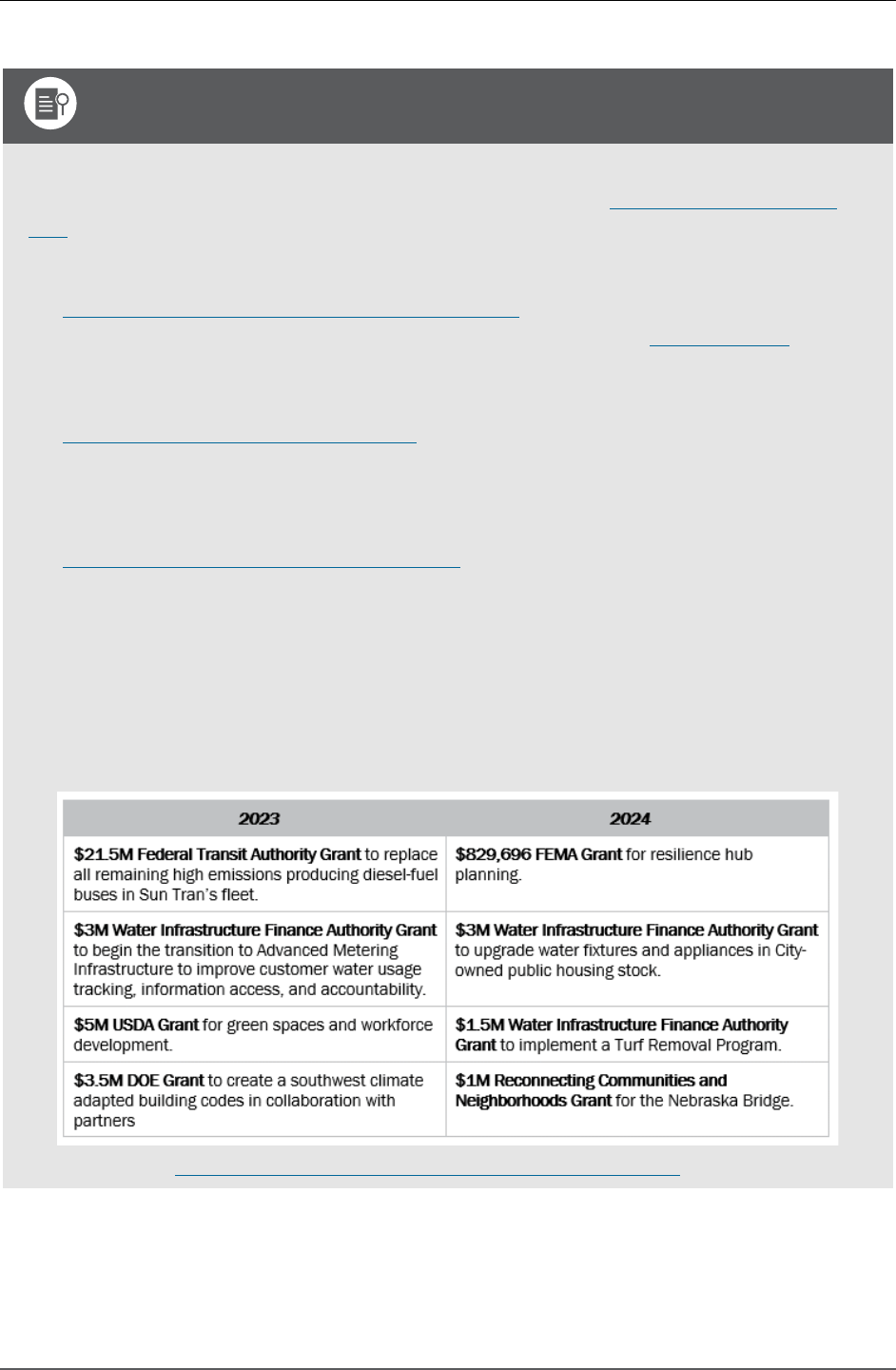
Climate Adaptation Planning: Guidance for Emergency Managers
71
Case Study: City of Tucson, Arizona Using Federal Funds
Extreme heat is the number one weather-related cause of death in Arizona. The city of Tucson
has been in an extreme heat state of emergency since 2020. The Tucson Resilient Together
plan was adapted to help combat extreme heat and mitigate future climate complications.
Below are examples of Tucson Resilient Together projects that received federal funding:
Regional Catastrophic Preparedness Grant Program funding is being used to create a
flexible and scalable plan on how to form resilience hub networks. Resilience hubs are
designed to be locations embedded in the community where people feel safe and seek
services and resources in times of need - such as a cooling center in the summer.
Urban and Community Forestry Program grant funding is being used for tree planting and
maintenance focusing on disadvantaged households and residents with higher heat
vulnerability. A multigenerational workforce will be developed to maintain the trees to help
increase long-term resilience efforts.
Resilient and Efficient Codes Implementation funding is being used to transform building
construction practices across the southwest to achieve highly efficient and climate-resilient
buildings and communities, while preserving affordability and regional characteristics.
Various grant funding will be used to work with the Pima County Health Department,
neighboring jurisdictions, local school districts, tribes, and community nonprofits to create
a community-wide, comprehensive heat mitigation strategy.
Table C-1: Tucson Resilient Together Funding Sources (2023-2024)
Table adapted from City of Tucson‘s Resilient Together Climate Action and Adaptation Plan.

Climate Adaptation Planning: Guidance for Emergency Managers
72
Funding Provided by State and Local Governments
Adapting to climate change is often achieved through local or regional actions. State and local
governments play an important and growing role in the financing and funding of adaptation projects.
While many states have authorized grant programs or financing authorities, local funding of
resilience and adaptation projects remains important. FEMA’s
Local Elected and Appointed Official
Guide
130
is a great resource for developing bond issues, special assessments, and taxes for
application to resilience programs.
STATE GRANT PROGRAMS
States have implemented a wide variety of grant programs with funding for climate resilience and
adaptation. Projects include but are not limited to; traditional infrastructure (e.g., transportation,
stormwater, wastewater), green infrastructure, wildlife and biodiversity conservation, flood
management, drought, heat waves, and many other outputs. Some programmatic examples include
the Virginia Community Flood Preparedness Fund Grant
, which was established to help Virginia’s
communities mitigate the impacts of flooding; the California Environmental Protection Agency’s EJ
Grants, which offer funding opportunities to nonprofit community organizations and Tribal
governments to address environmental hazard impacts; and New York’s Climate Smart Communities
Program, which provides broad funding to communities for both climate mitigation and climate
adaptation.
As there are an ever-increasing number of grant programs, FEMA’s Recovery and Resilience
Resource Library is a useful resource for finding new funding opportunities, along with other tools
and resources to help craft a strong grant proposal.
STATE-AUTHORIZED FINANCING
Some states have passed legislation empowering local governments to establish districts or
authorities whose purpose is to fund resilience projects. For example, the Maryland General
Assembly passed SB 457 in May of 2020, which allowed local governments to create
Resilience
Authorities that can establish a diverse array of financing for a variety of resilience-oriented projects.
These authorities can issue bonds, levy fees for services, or rely on government or nonprofit
contributions, among other funding streams. In turn, they have a wide range of powers (other than
eminent domain) to build, acquire, manage, or operate infrastructure and resilience projects.
California AB 733, enacted in 2017, similarly authorized local governments in the state to create
enhanced infrastructure financing districts specifically for climate adaptation projects. Given the
broad hazards and impacts associated with climate change, this law provides flexibility for local
governments to invest in projects adapting to flooding, drought, and heat waves, as well as the
spread of infectious diseases and other public health impacts.
130
FEMA. Local Elected and Appointed Official Guide: Roles and Resources in Emergency Management. (2022).,
https://www.fema.gov/sites/default/files/documents/fema_local-elected-officials-guide_2022.pdf

Climate Adaptation Planning: Guidance for Emergency Managers
73
Case Study: Climate Protection Fund in Denver, Colorado
On November 3, 2020, the people of the City and County of Denver, Colorado voted in favor of
raising the local sales and use tax by 0.25 percent to create the Climate Protection Fund. This
fund, which is expected to raise up to $40 million per year, is dedicated to eliminating GHG
emissions and air pollution, supporting climate adaptation, and creating new jobs to improve
the lives of community members. Its efforts focus on the communities most harmed by climate
change: low-income households, communities of color, Indigenous peoples, babies, children,
pregnant women, the elderly, people with disabilities, people with access and functional needs,
and people with chronic health conditions.
Private and Philanthropic Funding
A variety of private and philanthropic funding is available to SLTT communities in climate mitigation,
resilience and adaptation program design and planning. For instance, many large corporations
maintain philanthropic programs which may provide monetary support for climate mitigation and
resilience building programs. Elected and appointed officials can be helpful in making introductions
to business leaders and helping to broker funding for these projects. Planners should consider the
value a business may receive from their funding: safer and more resilient communities for their
employees, less risk to their operations, or public relations benefits.
Many nonprofits with explicit climate-related risk mitigation and resilience building missions exist
across the country. Some focus on specific issues such as wetlands, ocean conservation,
sustainable commerce, climate change action, education, or renewable energy. For example, the
Wildlife Conservation Society operates a Climate Adaptation Fund
that focuses on investment and
innovation in adapting wildlife and ecosystems to climate change.
Case Study: Groundwork Jacksonville, Florida
In 2021, Groundwork Jacksonville was awarded $294,000 from the National Fish and Wildlife
Foundation, with support from NOAA and AT&T, earmarked for the preliminary (30 percent)
design of the Hogans Creek restoration. The goal of the resilience project is to reduce flooding,
improve water quality, restore habitat, and provide access to recreation in and around the
creek.
The number of nonprofit philanthropic organizations offering funds related to climate-related risk
mitigation is rapidly growing. Many of these organizations are members of the
National Voluntary
Organizations Active in Disaster, making this a good starting point for exploring nonprofits offering
climate resilience project funding. The Georgetown Climate Center’s Adaptation Clearinghouse is
another great resource where users can search for funding or financing opportunities and filter by
region or locality, focal sector, or jurisdictional focus.

Climate Adaptation Planning: Guidance for Emergency Managers
74
Appendix D: Trainings and Additional Resources
Trainings
CLIMATE ADAPTATION AND HAZARD MITIGATION CERTIFICATE PROGRAM
The Emergency Management Institute has developed the “Climate Adaptation and Hazard Mitigation
Certificate Program.”
131
The program consists of the following courses:
IS1400 Foundations of Climate Change;
E1401 Climate Change Fundamentals for Emergency Managers;
K1402 Climate Change Communication for Emergency Managers;
E1403 Project Planning with Climate Change in Mind (last course before Capstone);
E1404 Capstone (must be final course); and
Three (3) elective courses to be completed at participating colleges and universities.
Fo
r a list of elective courses, use key word search such as “climate” in the National Preparedness
Course Catalog.
132
Potential elective courses include:
AW
R-347: Climate Adaptation Planning for Emergency Management tra
ins participants to be
able to discuss the impact of weather hazards on critical infrastructure and key resources and
explain how climate change projects will affect those impacts. The processes of common
weather hazards, climate variability, and climate change will be addressed alongside risk
assessment paradigms.
AWR-379: Costal Hazard Awareness provides training on the basic science of, assessment of,
and preparedness for natural hazards and risks that uniquely affect coastal communities.
Examples of these hazards are short-term events such as high surf, storm surge, and tsunami
inundation, or long-term threats from sea level rise and coastal erosion.
MGT-4
84: Nature-Based Solutions for Mitigation Hazards provides planners, government
officials, and hazard mitigation professionals information on the types, applications, and benefits
of nature-based solutions (NBS) as well as the common barriers for their use. Beyond an
overview of NBS, the course focuses on the planning and implementation mechanisms that can
be leveraged to employ these solutions in practice. This includes planning mechanisms related
to land use, hazard mitigation, stormwater management, transportation, open space, and
disaster recovery. The course also highlights important planning considerations for utilizing NBS,
including planning quality, alignment among plans, and equity.
131
For more information on the Climate Adaptation and Hazard Mitigation Certificate Program, see
https://training.fema.gov/programs/climate-adaptation-certificate/.
132
For more information on the National Preparedness Course Catalog, see
https://www.firstrespondertraining.gov/frts/npccatalog?catalog=NTED

Climate Adaptation Planning: Guidance for Emergency Managers
75
Additional Resources
ACHIEVING EQUITABLE RECOVERY
The Achieving Equitable Recovery provides local leaders with tools to help identify needs, establish
critical partnerships, leverage new opportunities, conduct strategic public engagement, and pursue
recovery in an equitable manner. Additionally, case studies, toolkits, and resources are included to
help highlight best practices and lessons learned.
BUILDING ALLIANCES FOR EQUITABLE RESILIENCE
Building Alliances for Equitable Resilience includes guidance, perspectives, stories, and resources
for equitable resilience.
CLIMATE ESSENTIALS FOR EMERGENCY MANAGERS
Climate Essentials for Emergency Managers offers foundational learning opportunities for the
emergency management community and beyond. By sharing communication techniques, climate
information, data resources, and guidance for connecting with experts, this resource helps advance
the integration of climate change considerations into actionable efforts before, during, and after
disasters.
CLIMATE RESILIENCE AND CLIMATE ADAPTATION EXERCISE STARTER KITS
The Emergency Management Toolkit (EM Toolkit) section of the Preparedness Toolkit (PrepToolkit) is
intended to provide information on resources that have been developed by FEMA and Federal
partners to help the emergency management community at all levels of government to prepare for
various threats that face the nation. The
Climate Resilience and Climate Adaptation Exercise Starter
Kits are specifically designed to provide a set of sample materials and templates that can be
customized to create a discussion-based climate exercise to validate plans and policies.
GUIDANCE ON EXTREME TEMPERATURES FOR SLTT LEADERS
Guidance on Extreme Temperatures for State, Local, Tribal, and Territorial Leaders outlines four
actions that can be taken by SLTT leaders to help protect people in their respective jurisdictions from
extreme temperatures.
LONG-TERM COMMUNITY RESILIENCE EXERCISE RESOURCE GUIDE
FEMA’s Long- Term Community Resilience Exercise Resource Guide offers reliable methodologies,
strategies, information and resources for designing and conducting discussion-based exercises
focused on climate adaptation and resilience planning. Exercises offer communities a low-risk and
cost-effective way to increase preparedness for all threats and hazards, including the potential long-
term impacts of climate.
REGIONAL RESILIENCE TOOLKIT
The EPA’s Regional Resilience Toolkit promotes an inclusive, coordinated approach to disaster
planning. It is designed to help multiple jurisdictions and levels of government, as well as non-

Climate Adaptation Planning: Guidance for Emergency Managers
76
governmental partners, collaborate on regional-scale actions. It can be used in any region or
community — no matter the size, location, capacity, or hazard. The flexibility of the toolkit also allows
for the user to jump in at any point in the process, depending on their progress in resilience planning.
RESILIENCE HUBS
Resilience Hubs are community-serving facilities set up to support residents and coordinate resource
distribution and service before, during, or after a hazard event. Resilience Hubs are often
established in well-managed buildings that have year-round community activities. They are focal
points for neighborhoods and provide the resources residents need to enhance their individual
capacity while supporting their neighbors. These are run by community members, faith-based
groups, and community-based organizations.
RESILIENT NATION PARTNERSHIP NETWORK
The Resilient Nation Partnership Network represents a diverse network of voices united in their
commitment to helping communities act and become more resilient toward natural disasters and
climate-related events. The mission is to inform, educate, and motivate communities to protect
themselves from the loss of life, property, and prosperity as a result of natural hazards.
TRIBAL CLIMATE ADAPTATION GUIDEBOOK
The Tribal Climate Adaption Guidebook provides a framework for climate change adaptation
planning in the context of existing tribal priorities, and directly considers the unique issues facing
indigenous communities. Specifically, the Guidebook directs readers to the foundation of existing
resources and tribal adaptation efforts and identifies opportunities for braiding together traditional
knowledges and western science in developing adaptation plans. The framework outline is useful for
tribes in different phases of climate adaptation planning efforts and supports learning from the
experiences, approaches, and lessons of tribes working to become more resilient to climate change.
U.S. GLOBAL CHANGE RESEARCH PROGRAM (USGCRP) INDICATORS PLATFORM
The USGCRP Indicators Platform is an interagency collaboration that leverages efforts from across
multiple federal agencies and highlights key climate information in the form of indicators. The
indicators provide information about global and U.S.-based climate and emissions trends. Indicators
are based on observed data that can be used to track and communicate climate-related conditions,
trends, and impacts. Indicators—which may be physical, ecological, health, or societal—can be used
to assess risks and vulnerabilities and help inform resiliency and adaptation planning in a changing
climate.

Climate Adaptation Planning: Guidance for Emergency Managers
77
Appendix E: Glossary
Adaptation: Adjustment in natural or human systems to a new or changing environment that
takes advantage of beneficial opportunities or moderates negative effects.
Cascading Impacts: Cascading impacts from extreme weather or climate events occur when an
extreme hazard generates a sequence of secondary events in natural and human systems that
result in physical, natural, social, or economic disruption, whereby the resulting impact is
significantly larger than the initial impact.
Climate: Climate is determined by the long-term patterns, over a period of 30 years or more, of
temperature and precipitation averages and extremes at a location.
Climate Change: A change in the state of the climate that can be identified by changes in the
mean or variability of its properties and that persists for an extended period, typically decades or
longer. Climate change may be due to natural internal processes or external forcings such as
modulations of the solar cycles, volcanic eruptions, and persistent human-driven changes in the
composition of the atmosphere or in land use.
Climate Mitigation (“mitigation” also “greenhouse gas [GHG] mitigation”): Measures to reduce
the amount and speed of future climate change by reducing emissions of heat-trapping gases or
removing carbon dioxide from the atmosphere.
Climate Projection: The simulated response of the climate system to a scenario of future
emission or concentration of GHG and aerosols, generally derived using climate models. Climate
projections are distinguished from climate predictions by their dependence on the emission,
concentration, radiative forcing scenario used, which is in turn based on assumptions
concerning, for example, future socioeconomic and technological developments that may or may
not be realized.
Climate Resilience: The capacity to anticipate, prepare for, respond to, and recover from
significant multi-hazard threats with minimum damage to social well-being, the economy, and the
environment.
Environmental Justice: The fair treatment and meaningful involvement of all people, regardless
of race, color, national origin, or income, with respect to the development, implementation, and
enforcement of environmental laws, regulations, and policies.
Equity: The consistent and systematic fair, just, and impartial treatment of all individuals,
including individuals who belong to underserved communities that have been denied such
treatment, such as Black, Latino, and Indigenous and Native American persons, Asian Americans
and Pacific Islanders and other persons of color; members of religious minorities; lesbian, gay,
bisexual, transgender, and queer (LGBTQ+) persons; persons with disabilities; persons who live
in rural areas; and persons otherwise adversely affected by persistent poverty or inequality.
Greenhouse Gases (GHG): A gas that absorbs heat in the atmosphere near the Earth's surface,
preventing it from escaping into space. If the atmospheric concentrations of these gases rise, the
average temperature of the lower atmosphere will gradually increase, a phenomenon known as
the greenhouse effect. GHG include, for example, carbon dioxide, water vapor, and methane.
Hazard Mitigation: Any sustained action taken to reduce or eliminate the long-term risk to human
life and property from hazards.

Climate Adaptation Planning: Guidance for Emergency Managers
78
Natural Hazards: Source of harm or difficulty created by a meteorological, environmental, or
geological phenomenon or combination of phenomena.
Nature-Based Solutions: Sustainable planning, design, environmental management, and
engineering practices that weave natural features or processes into the built environment to
promote adaptation and resilience.
Public health: A science that seeks to protect and improve the health of people and
communities. Through policy advice, health education, outreach, and research, public health
workers seek to understand and address the root causes of health issues.
Resilience: The ability to prepare for anticipated hazards, adapt to changing conditions, and
withstand and recover rapidly from adverse conditions and disruptions.
Risk: Threats to life, health and safety, the environment, economic well-being, and other things of
value. Risks are often evaluated in terms of how likely they are to occur (probability) and the
damages that would result if they did happen (consequences).
Underserved Communities: Defined in Executive Order 13985 as populations sharing a
particular characteristic, as well as geographic communities, that have been systematically
denied a full opportunity to participate in aspects of economic, social, and civic life, as
exemplified by the list in the preceding definition of ‘‘equity.’’
Vulnerability: The degree to which physical, biological, and socioeconomic systems are
susceptible to and unable to cope with adverse impacts of climate change.
Weather: The state of the atmosphere with respect to wind, temperature, cloudiness, moisture,
and pressure. Weather refers to these conditions at a given point in time.

Climate Adaptation Planning: Guidance for Emergency Managers
79
Appendix F: Acronyms
BIL Bipartisan Infrastructure Law
BRIC Building Resilient Infrastructure and Communities
CPG Comprehensive Preparedness Guide
CDBG Community Development Block Grant
CDC Centers for Disease Control and Prevention
ClimRR Climate Risk and Resilience Portal
DOT Department of Transportation
EJ Environmental Justice
EPA Environmental Protection Agency
FEMA Federal Emergency Management Agency
FMA Flood Mitigation Assistance
GHG Greenhouse Gas
HMGP Hazard Mitigation Grant Program
HUD Housing and Urban Development
IRA Inflation Reduction Act
NASA National Aeronautics and Space Administration
NBS Nature-Based Solutions
NOAA National Oceanic and Atmospheric Administration
RSF Recovery Support Function
SLTT State, Local, Tribal, Territorial
SSP Shared Socioeconomic Pathway
THIRA Threat and Hazard Identification and Risk Assessment
